Alaska
Glacier Gardens
adults Liberty/Momma and Freedom/Poppa
A pair of Alaskan Bald Eagles built a nest on the Glacier Gardens property in Juneau, Alaska, in 2004 and since then have fledged several adolescent bald eagles into the great Alaskan wild. A camera was added in 2010, and I first discovered them in 2017; the camera is on during the nesting season, roughly April to early September. The adults are named Liberty (F) and Freedom (M), but Glacier Gardens uses Momma and Poppa on their website. The nest is deep, so it's not possible to be sure how many eggs are laid.
We're not sure how many eggs they had in 2017, but one hatched and that chick fledged, and was reported as being the first successful fledgling in three years; according to the cam page, there was one chick in 2016 but it died soon after hatching. The pair raised two chicks in 2018, and GG2/Equality and GG3/Pride both fledged successfully. There were two chicks again in 2019, and GG4/Ch'áak' and GG5/Anáaski fledged successfully. The cam was not streamed in 2020 due to covid. There were 2 eggs in 2021, one hatched and GG6/Kindness fledged successfully.
Based on past experience, look for eggs in late April.
Alaska
Haines
This cam is the result of a partnership between the Hancock Wildlife Foundation in British Columbia and the American Bald Eagle Foundation in Haines, Alaska. The pair raised two fledglings in 2007, nested in a different location in 2008, and raised two fledglings in 2009. The cam has not been operational since 2009, and there's been no report on nest activity.
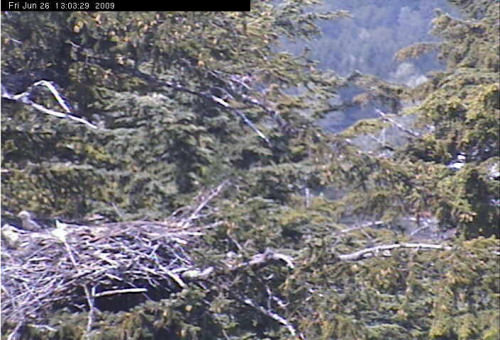
JudyB's s'cap - June 26, 2009
Based on past experience, look for eggs in early May, chicks in early to mid June, and fledging in late August or early September.
Alaska
Kenai
New camera for 2017
Aurora (F) and Redoubt (M)
This eagle’s nest is located in Kenai, Alaska and is provided as part of a public / private partnership involving residents of the City, the City of Kenai, and the Kenai Chamber of Commerce. The camera is online during the nesting season, roughly mid-May to mid-August.
The eagles had 2 eggs in 2017, both hatched, and both fledged successfully.
They had two eggs again in 2018, and K3 and K4 both fledged successfully. The adults moved to a new nest in 2019, and there was no cam and I did not find any local observer reports. The adults were back on the nest with a cam in 2021, but it was a challenging year - both eggs hatched, but male Redoubt disappeared on June 18 and younger chick Spurr fell from the nest and died on June 20; older chick Denali did not return to the nest after fledging, but local observers saw her with Mom Aurora for several days, so all appears well.
Based on past experience, look for eggs in mid April.
British Columbia
Burnaby
no cam -
observations by WillPatt
This nest is located in a tree in a small park in a residential area of Burnaby, BC. It's unusual not only for being is such a populated area, but for being in a tree with leaves that hide the nest (parents generally seem to prefer an unobstructed view from the nest), and for being several miles from the nearest body of water large enough to catch fish. This nest successfully fledged 2 eaglets in 2007, and fledged 2 eaglets in 2008, though one had poor feather development on its wings, making us wonder how that would affect its survival. The eagles haven't nested there since 2008.
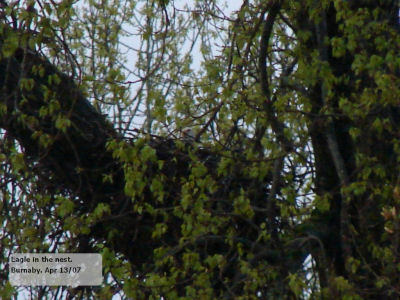
WillPatt's photo - April 13, 2007 - parent in nest
© 2009 Will Patterson, used with permission, all rights reserved
(note that the leaves are just beginning to open - they'll get much bigger!)
Based on past experience, look for eggs in early or mid April, chicks in mid May, and fledging in early to mid August.
British Columbia
Delta 1
no cam
This pair either abandoned their nest or were driven off by a nearby pair in 2007, but returned in 2008 to raise two eaglets. The older one fledged successfully, but the younger one fell from the nest when he was almost 11 weeks. He was found and taken to the Orphaned WildLife Rehabilitation Society (O.W.L.), where he was found to have no major injuries, but was underweight so they admitted him. He was released about 5 weeks later. Eagles believed to be his sister and one of their parents were seen in the area until he was released, at which time they all disappeared - we like to think heading North together for the salmon runs. The nest had fallen apart quite a bit by the end of the 2008 nesting season, and wasn't substantially rebuilt for 2009. The pair laid two eggs, both of which hatched. The older eaglet fell to its death when part of the nest broke away when he was about 3-1/2 weeks old; the younger eaglet (nicknamed "Bandit" on the Hancock Wildlife forum) fledged prematurely when a branch broke off the tree when he was about 11 weeks old, and was taken to O.W.L. for rehabilitation, and subsequently released at Chehalis in the fall, when there were other eagles in the area. By nesting season in 2010, there wasn't much of anything left in the tree, and the pair made a nest on the ground and laid at least two eggs; one was broken by the time David Hancock arrived to check it out, and the other had apparently died several days before David examined it. No reports since 2010. We continue to hope that they will find a safe place to nest and raise a family.
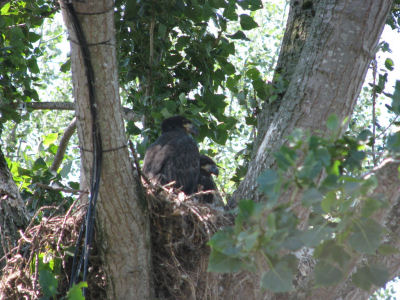

Photo of nest and the two eaglets from 2008 by Judy Barrows © July 15, 2008
all rights reserved
This pair had eggs in early April and chicks in early-mid May, but nearby eagles had chicks in early April - so there may be some flexibility in nesting time in the area.
British Columbia
Delta 2
Ma & Pa Delta (2011-2018)
Ma Delta & Trooper (2019-2021)
Ma Delta & ?
There have been eagles in this territory since at least the late 1990s. The initially built this nest, then nested on high tension power poles for a few years, then moved back to the nest in 2010 and successfully raised two eaglets. A camera was added for the 2011 nesting season. The pair laid 2 eggs in 2011, both of which hatched. The older chick, named Oreo by local schoolchildren, fell from the nest when about 10 weeks old; he was unharmed but couldn't be returned to the nest so was taken to O.W.L. and fledged from there at 14 weeks; the younger chick, named Jet, fledged successfully from the nest a few days earlier. The pair again laid 2 eggs in 2012; both hatched, and they were named Goldwing and Linux in honor of Richard Pitt, who rode a Goldwing motorcycle and much preferred the Linux operating system to Windows; the older chick died when she was a bit over 7 weeks old, possibly because a bone got stuck in her crop (based on how it looked on the cam) or perhaps because of contaminants in something she ate; the younger chick fledged successfully on her second attempt, after ending up grounded and rescued by O.W.L. for a checkup the first time she left the tree. The adults here seem to spend less time on the nest than many other parents, and seem to have trouble finding enough food for two chicks as the chicks get larger and begin to eat more. The pair laid 2 eggs in 2013; only one hatched; feathers were seen as the second egg deteriorated, so we suspect the chick inside died before or during the attempt to hatch. The chick was named Tux, after the mascot for the Linux operating system, and fledged successfully.
2014 was a year of miracles. Observers noticed a problem with Mom Delta's left leg on February 8, and David Hancock and Bev Day from O.W.L. reviewed the videos and felt it was likely broken, or at least badly sprained. Other eagles were seen in the area, so the injury could be the result of a fight with another female for control of the nest - in which case it looks as if Mom won - but at a price. We thought they might not nest - and they were late laying eggs, but they did lay two eggs. We also weren't sure they would hatch - the female must be able to support the male while he fertilizes the eggs, and Mom was mostly standing on one leg - but amazingly both of them hatched, and the eaglets named Ariel and Hunter by the people living on the nest property both fledged successfully, the first time both chicks fledged without intervention.
The eagles returned as usual in the fall of 2014; Mom was still favoring her left leg, but they prepared their nest and laid two eggs in mid-March, then partway through the nesting cycle, something disrupted incubation - construction nearby (which might have dislocated other pairs who suddenly were interested in taking over the nest), a re-injury to Mom's leg - or something we may never know. What we do know is that after a couple of weeks of steady incubation, the eggs were left alone for hours at a time, including several nights when the temperatures dipped near freezing, and not surprisingly, even though they resumed incubating somewhat more consistently after a time, neither egg hatched. I'm sad that we didn't have chicks this year - but consider it a small price to pay if Mom is finally able to rest and heal and return as the strong capable adult she was before her injury.
And then - as we were wondering how we could afford to keep this nest streaming for another season - on August 29, just weeks before the eagles might return, the nest and tree came down in a wind storm, damaging both cams in the process. And thanks to a whole lot of people, we (Hancock Wildlife Foundation, where I'm a volunteer admin for their website and forum) raised $7000 to bring in a lift and climbers, build a nest in a nearby tree where the pair often perched, retrieve the two cams from Delta 3 and install them here - and have everything ready for the return of the eagles. The eagles returned in early October - and as of early November, it looks as if they've accepted the new nest, and are beginning to fix it up for 2016.
The eagles did indeed use their new nest in 2016 and laid two eggs, which hatched into the chicks named Ace and Pippen. Ace fledged successfully, but sadly Pippen died when he or she was about 6-1/2 weeks old; Pippen had not been showing much interest in food for several days before that, and stood up much of the time, perhaps because it was harder to breathe whyle lying down, and his breathing was very labored the last few days. Those of us who were watching this nest in 2012 could see definite similarities between Pippen's symptoms and what we'd seen when Goldwing died at 51 days old. There was speculation that it might have been Aspergillosis, a respiratory disease caused by a fungus, but it's unlikely that we will ever know; Pippen was 46 days old when he or she died.
2017 was a happier year - the pair again had two eggs, and the eaglets named Spirit and Jewel fledged successfully. As the 2018 nesting season begins, the eagles have returned and are working on their nest - and Mom's leg is looking great!
2018 was another challenging year - both adults were calling the evening of June 1, perhaps warning off other eagles in the area, and Pa flew of at 4:57 pm - and that's the last time we saw him. They had laid two eggs, and eaglets Dusk and Dawn were 7 weeks old when Pa disappeared.
A new male was seen in the area soon thereafter, and appeared to be chasing other eagles away from the territory, and respecting the female's calls to stay away from the nest and the chicks; he became known as UME (unidentified male eagle). He also disappeared at some point, and was replaced by another male, known as AME (adult male eagle) who spent the rest of the season guarding the area and keeping things safe.
As the chicks got closer to fledging, the male started coming to the nest; unfortunately he did not provide food - and occasionally took food from the chicks - but he also did not attack them or harm them when they tried to take food from him - and he did keep other eagles away. Happily Ma Delta, with a little help from her friends, was able to provide all the food needed for the growing chicks, and both fledged successfully. Once they left, AME and Ma were seen together more often, and they did some work on the nest; at the end of the season, AME was given the name Trooper.
Ma Delta and her new mate Trooper laid two eggs in 2019, and Trooper proved to be a good provider; eaglets Bella and Coola (named after the BC town Bella Coola) both fledged successfully.
In 2020, Ma Delta laid three eggs for the first time since we started watching them in 2011; two of them hatched, and both eaglets had accidental fledges several days apart. Younger eaglet Shadow returned to the nest the next day. Sunny was seen by experienced local observers the evening after the fledge, but they weren't able to catch him, and he never returned to the nest, even though the adults continued to feed Shadow there for almost a month. There are coyotes in the area - but one of the neighboring nests in the direction Sunny was heading was thought to have only one chick, and observers started seeing two youngsters there shortly after Sunny left the nest - so maybe he found a foster home?
Ma Delta laid three eggs again in 2021,
two hatched, and Hope and Chase (named for communities in BC) both fledged successfully and spent the normal amount of time at the nest afterwards before heading off for their great adventure.
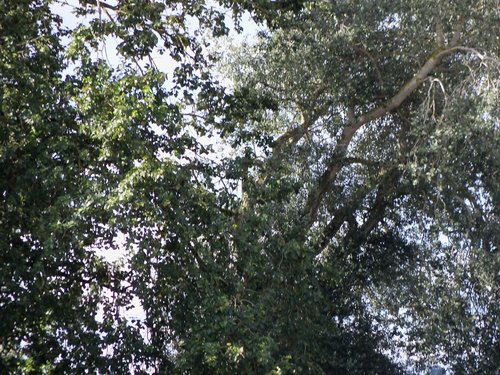
Photo of original nest and "Jet" from 2010 by planetocean © July 16, 2010
all rights reserved
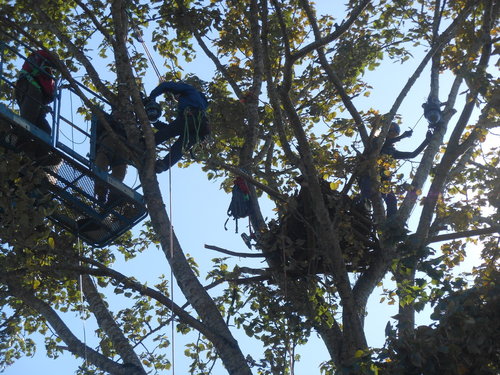
Photo of new nest and cams being installed by Karen Bills © September 6, 2015
used with permission, all rights reserved
This pair had eggs in early March which hatched in mid-April.
British Columbia
Delta OWL
This nest is located in the same general area of Delta, British Columbia, as the Orphaned WildLife Rehabilitation Society (O.W.L.), which cared for Delta Dan, who fell out of the Delta 1 nest in 2008 and needed some extra help to get ready for the fall migration. This nest was new in 2008, and while the pair built a nest and spent time there, they did not lay any eggs (not uncommon for the first year of a new nest). They laid two eggs in 2009, but sadly the eggs did not hatch, although they continued to incubate for at least two weeks past the likely hatching time. Part of the nest collapsed as they were rebuilding it for the 2010 season, and they've divided their time between trying to fix it, trying to start a new nest, and possibly being a bit lost (though that's assigning human characteristics). A raccoon has been seen in their nest several times, adding to the difficulty of rebuilding it for the 2010 season. They did not nest in 2010, and in the end the nest was completely destroyed by wind, but Hancock Wildlife Foundation and O.W.L. were able to shore up the nest with reinforcing in September 2010, so we're hoping the eagles will be back in 2011. This pair laid 2 eggs in 2011 and tended them diligently, but they didn't hatch; the first may have been fertile - some of us thought we saw a pip and heard peeping; the second was recovered from the nest by David Hancock after the eagles stopped incubating and analysis showed it was infertile. Additional branches were added to the nest in fall 2011 when the cams were cleaned. The eagles only stopped by the nest once or twice in 2012, and local observers reported that the male may have died or left the area (pairs do split up after unsuccessful seasons); the female was still in the area, often perching at the top of the nest tree, and it appeared as if there may be males in the area showing an interest, so maybe 2013 will be the lucky year for this nest. An interesting aside - a pair of young raccoons slept in the tree a couple of times, and one alone was there once or twice afterwards; not good for our goal of having nesting eagles here - but cute to watch.
No news since 2012.
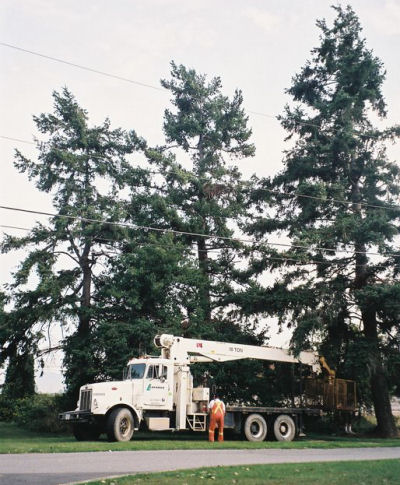
Photo of nest by Karen Bills © August 2009
used with permission, all rights reserved
Based on other nests in the area, eggs could come any time from late February to mid April.
British Columbia
French Creek
new nest for 2021
adults not named yet
This is a new nest built to replace one that was removed, but the resident pair had other ideas and built a new nest 650 feet away, near the Marina; unfortunately that nest did not produce chicks, and the male may have died in late March.
A pair of eagles which might include the Marina female were visiting the nest in early summer, so we are hoping to see activity here in 2022.
More bad luck - the cam has stopped working at the end of December 2021 and can't be fixed from the ground, so no cam until fall 2022.
British Columbia
Harrison Mills
Mr and Mrs Honeycomb (unofficially Mom & Dad) (fall 2012 - June 20 2017)
Mrs Honeycomb & "New Dad" (fall 2017 - May 31 2018)
Dad (2018's New Dad) and Lady (official names Duffer & Dimple, or Mr & Mrs D) (summer 2018 - )
This nest is 175 feet up a huge Douglas fir - on the 10th green of the Sandpiper Golf course at Pretty Estates Resort in Harrison Mills, BC (site of the Fraser Valley Bald Eagle Festival). The 2 PTZ cams also show the eagle activity on the Chehalis - Harrison Flats to the North East. 2013 was the first year Hancock Wildlife Foundation had a camera in this nest, and David Hancock's research suggests that the pair we watched originally moved from the next territory over when licensed utility construction led to the removal of their former nest. We were worried that the nest might not be occupied because we didn't see any activity in the fall, when eagles usually do the preliminary work on their nests - and the first member of the pair who nested did not arrive until March 5th, and both were not seen until March 10. They laid their first egg April 4, after a modest amount of work on the nest; a second egg followed 4 days later. Unlike some pairs, they started incubating full time once the first egg was laid, so the eggs also hatched 4 days apart. The chicks were named Birdie and Bogey by the folks at Pretty Estates Resort (sponsor of the nest), and little Bogey held his own for a couple of weeks, but once Birdie started his/her growth spurt, the size difference was too great and the much smaller younger chick was no longer fed. Bogey was 23 days old when he/she died. Birdie fledged successfully, and didn't return to the nest until four days later; he/she made a final visit to the nest a few days later. Observers noted that the adults did not spend much time in the nest before the eggs were laid, and David Hancock noted that they seemed to be following the pattern of wilderness eagles, who only use the nest for raising young, rather than the more urban eagles we observe on many cams, who eat and mate at the nest before laying eggs, and use them as feeding platforms for the eaglets once they fledge.
The eagles returned in the fall of 2013, and put in a lot of work on their nest, making it ready for spring. The pair only laid one egg in 2014, and sadly it didn't hatch. 2015 was better - as in 2013, the pair laid two eggs four days apart, and Driver and Putter hatched four days apart. There were a few days when we held our breath as the older chick hit her growth spurt and food deliveries seemed down - but happily they picked up again in time to help the younger chick catch up - and both fledged successfully, 4 days apart.
2016 was a challenging year at several HWF nests, including this one. The pair laid two eggs four days apart as usual, and they hatched four days apart and were named Sandy and Piper; we didn't notice any rivalry or bullying, but younger chick Piper was sleeping through feedings the day after hatching and didn't show the energy we normally see in little chicks, and died peacefully at 3 days old. Sandy fledged successfully.
2017 was another challenging year - there was an intruder in the area while they were incubating but the Honeycombs were able to protect the nest - and their two eggs hatched a day and a half apart, rather than the 4 days that had been seen here in the past, which made it easier for the chicks, named Bunker and Divot, to compete for food - though Bunker made it clear that she or he was the boss! Things went fairly smoothly for the first five weeks - then Dad disappeared, and people in the area reported seeing a aerial fight in which at least at least one adult may have been injured; he had brought food and fed the chicks around 5 pm on June 10, and we only saw him once after that, when he visited the nest briefly a couple of times on June 20; he did not appear injured - but it seems that whatever happened during the previous 10 days disrupted his nesting instinct (or he may have lost the fight for the territory - the human in me likes the idea of his stopping in to say goodbye, but I know it's more likely this was part of a final attempt to regain the territory, after which he moved on). With a bit of help, Mom was able to provide for her growing chicks (though there were some days without food which were hard to watch) - and they both fledged successfully and were seen in the area for a few days afterwards, which isn't always the case at this nest.
As the 2018 nesting season begins, Mom is back, and we've seen at least one other adult in the area who seems to be spending a lot of time with Mom; he looks bigger than Dad - but we're all waiting for him to come to the nest and show us his tailfeathers - since Dad had an unusual dark stripe. And while we'd all love to see Dad back, we'll be happy with a peaceful, productive nesting season with whoever Mom chooses.
~
Mom and her new mate laid one egg in 2018, several weeks later than she usually laid them, and the egg hatched;
the new male was doing such a good job providing food and tending the egg/chick that observers on the HWF forum agreed he should be called Dad. Sadly the little 7-day-old eaglet named Chips died early on May 29 for no apparent reason; he had looked fine the night before, and snuggled under Mom as usual - and wasn't moving in the morning. We did notice that because the river was high, not many fish were brought to the nest, and frogs or toads were a primary food - and perhaps Chips was fed a poisonous one or one that was contaminated in some way. Rest in peace, little one.
Mom was last seen on the nest on May 31, the day after she consumed Chips's remains; Dad was seen occasionally in early June, and brought a new female to the nest on June 19; he and the new female we have been calling Lady visited the nest regularly during the summer.
Lady disappeared
at the end of February 2019 and a new female was seen with Dad starting in early March, and they did some work on the nest - and then Lady returned on April 14; things looked promising - they bonded, and worked on the nest - but they did not lay any eggs; the new pair did get official names - in keeping with the tradition of golf terms, they are Duffer (M) & Dimple (F), or Mr & Mrs D - though we generally call them Dad and Lady.
As of late fall 2019, they are being seen regularly and have made a beautiful nest, and we're hoping to see eggs in the spring. That pattern was repeated in 2020 and 2021 - nicely prepared nest, lots of time spent there, but no eggs.

Photo of nest by Karen Bills © September 2012
used with permission, all rights reserved
This pair generally lays their eggs in late March or early April..
British Columbia
Hornby Island
Ma and Pa (2006-spring 2016)
Pa and Em (2016-spring 2018)
Em and Mr Em
The nest is located about 30 meters (100 feet) up an evergreen tree, and is situated on private property about 100 meters from the ocean on Hornby Island in the Strait of Georgia between Vancouver Island and the British Columbia mainland. According to Doug Carrick, the eagles built their first nest in the fall of 1989 and fledged their first eaglet in 1990. This will be their twenty-first year of nesting; they have fledged 18 eaglets in 20 years - just under one a year, which is considered average for eagles in this area. There has been a camera in the nest since September 2004, and it was first connected to the internet in spring 2006. The pair laid two eggs in 2006, neither of which hatched; the camera was offline in 2007 after the line was damaged in a winter storm but Doug reported that they raised and fledged two eaglets (Thunder and Lightning) that year; they did not lay any eggs in 2008. In 2009, they laid two eggs, both of which hatched; the younger eaglet Echo died in a freak accident, after becoming tangled in the female's feathers; older eaglet Hope fledged successfully. The pair laid two eggs in 2010; one hatched, and was named Phoenix; she died at 76 days old of acute aspergillosis, a respiratory infection likely caused by spores in the nesting material. The pair laid two eggs in 2011; both appeared to have some difficulty breaking out of their shells, but did hatch and the eaglets named Alexandra (for Alexandra Morton) and David (for David Suzuki) fledged successfully. Doug Carrick decided to stop streaming his cams for this nest in 2012; we think two eggs were laid, and know that one was hatched, and that chick, named Elizabeth (for Elizabeth May) by Doug Carrick fledged successfully. The Hornby Eagle Group Project Society was able to install a cam in a tree about 230 feet/70 meters away, providing a different view of these much-loved eagles. The Hornby eagles were seen in their territory in 2013, but did not lay any eggs. In 2014 the pair did nest; we're not sure how many eggs they laid, but one hatched, and the eaglet named Scootch fledged successfully.
2015 was a year of sadness and change - both adults returned as usual in the fall of 2015, but it was reported by observers in early March that the female (known as Ma) may have been injured in a fight with an intruder; she was seen on the nest during the first half of March and appeared to be healing as of March 14, but more eagles were drawn to the area for a herring spawn near shore - and Ma hasn't been seen since March 15; Pa was seen for a while longer and another female was seen in the area, but no one used the nest.
Pa returned in early October 2015, and was seen with another female (named Em by observers) by mid-October; they were seen together through the 2016 season, but did not nest. The pair laid 2 eggs in 2017; one hatched, but the chick died during the night. We have our fingers crossed for 2018.
2018 was another year of change; Pa was injured in a territorial fight in the fall of 2017, but was back and looking good this spring; however, there was apparently at least one other male trying to take over the nest, and as of April 15, there were a number of eagles around, and might be a pair, but I'm not sure who they are and they did not produce any eggs. As of fall 2018, Em is still in the territory and there has not been a confirmed sighting of Pa; there are males courting her, but she did not nest this year.
Em and her new mate who is being called Mr Em hatched two chicks in 2019, named Victoria and Albert; the cam is quite a ways from the nest and can't see down into the nest, but observers reported only seeing one chick as of July 8 (when they would have been about 7 weeks old); since they couldn't tell which one it was, they decided to call the remaining chick Churbles, and he or she fledged successfully. The pair raised two chicks named Frankie and Zen in 2020.
The year ended on a surprising note for observers - the nest tree was cut down on October 5th; there apparently was a permit, and parts of it may have been in danger of coming down; one of the adults was believed to be in the area a few days earlier. Em and Mr Em built a new nest for 2021 in a nearby tree; it's in sight of the cam but no way to look into the nest. They successfully raised two chicks named Salish ("Sally") and Georgie, but the nest wasn't that sturdy and came apart around the time the eaglets fledged. It will be interesting to see what they do in 2022.

Photo of Hope in the nest June 14, 2009, 9:21 am by boonibarb
© 2009, used with permission, all rights reserved
Based on past experience, look for eggs in late March, chicks in late April, and fledging in mid to late July;
the new pair laid their first egg April 21 - perhaps a new schedule.
British Columbia
Lafarge
Pa & Ma Lafarge (2011-2015)
Pa & Lady (2016-2019)
The Lafarge downtown Vancouver concrete plant is on the waterfront of Vancouver's inner harbor, beside the main CP rail tracks and sidings, in the heart of Vancouver's busy container and grain port facilities. The nest tree is alone on the property, right on the water's edge and outside the property's fenced area. An artificial nest structure, designed by David Hancock, sits beside the tree where it can be used by the eagles both as a perch and as a replacement nest site if something happens to the tree. This pair successfully raised three eaglets in 2011, even though the oldest was very big, and the youngest almost a week younger. In 2012 history repeated itself as the parents again successfully reared 3 chicks to fledging. New to the Lafarge nest in the 2013 season is a PTZ cam with sound that will give us a “bird’s eye view” of this very special eagle family. The pair again laid three eggs in 2013, and all three hatched, but the youngest died within a day of hatching, and the middle one died when he/she was 11 days old - no clue why - the chick had seemed healthy until the final day, when it was lethargic. The remaining chick, named "Feathers," fledged successfully. The pair laid 3 eggs in 2014; the first and third eggs hatched successfully and the second started to hatch but it appeared that the chick was unable to to peck around the shell so it could split, either because it was stuck or because it was too weak, and sadly the chick died; the remaining chicks, named J.J. amd Jess, fledged successfully.
2015 brought a lot of changes. The nest tree at the Lafarge site had been at risk for a while, and blew down during a bad storm in October 2014; the eagles returned soon afterwards, and chose to rebuild a nest near Pandora Street that they'd used before moving to Lafarge, rather than adopting the artificial nest. By mid March it appeared that one of the adults was always at the new nest - so we suspected that there were eggs - and we think there were chicks by mid to late April, though they weren't seen until May 11 and 17. All was going well until mid-June - when Ma Lafarge flew into power lines while being chased by a flock of crows, and died instantly. Happily Pa Lafarge was up to the task, and began feeding the chicks and staying by the nest at night, roles the female more often played, and the 7-1/2 week old chicks were old enough to be safe from most predators while he was away hunting for them. Local observers named the eaglets Pan and Dora, in honor of the location of their new nest, and both fledged successfully.
As of mid November 2015, Pa is back, and it looks as if he's found a lovely new partner, whom observers are calling Lady or Lady Lafarge. She's spending a lot of time perched on the rails of the artificial nest, sometimes with Pa (and they flew off in unison one time I watched - which looked to me as if they were developing a bond) - and both have also been seen at Pandora Street. It's early for them to have to decide and work on a nest - and we are wondering what they will do.
The pair nested at the Pandora Street nest in 2016, and appeared to have eggs they were tending, but there was was no indication of a hatch. They used the Pandora nest again in 2017, and local observers again watched them tending their eggs - and this time they saw feeding motions, right on schedule - though the chick itself wasn't seen for several more weeks - and was nicknamed Houdini by observers for its ability to hide.
2018 was a good year - Pa and Lady raised two chicks at the Pandora nest, and Apollo and Artemis both fledged successfully.
2019 was a challenging year; Pa and Lady again produced two chicks, because there is no cam, we don't know when they hatched, though feeding behavior was observed on April 22 (and based on likely incubation, the first hatch may have been as much as a week earlier); normally this wouldn't be important - but Lady was last seen on April 30, leaving Pa to raise two very small chicks - and amazingly - he did it! Both fledged successfully.
As of fall 2019, Lady has not returned, but an observer has seen Pa with another adult at the Pandora nest, so he may have a new mate for 2020. Pa and his new mate raised two chicks in 2020, but there may have been a different female in 2021, and as far as we could tell, they either did not lay eggs or the nest failed.
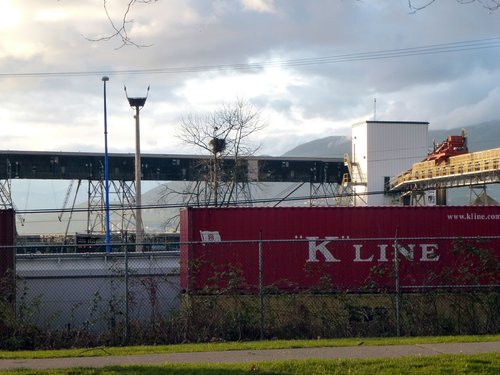
Photo of the Lafarge nest showing its industrial setting March 14, 2012, by gemini
© 2012, used with permission, all rights reserved

Photo of eaglets Pan and Dora branching at the Pandora nest, by Annemie
© July 10, 2015, all rights reserved
Based on past experience, look for eggs in late March, chicks in late April, and fledging in mid to late July.
British Columbia
Pacific Coast Terminals
Port Moody
According to residents in the area, there's been a nest here for about 18 years. The pair appeared to have eggs in 2010, but unfortunately they either didn't hatch or the chicks died before they were large enough to be seen from the ground. Pacific Coast Terminals has given Hancock Wildlife permission to put a cam on this nest for 2011 - but the eagles are busily building a new nest at another location on the PCT site. We hoped that they would move back to the nest with the cam once they completed their "spare" nest - but they chose the new nest; ground observers reported there were two eaglets; one appeared to fall from the nest at fledging age, tumbling down through a number of branches before catching itself, and then was seen flying to another tree - but hasn't been seen since; the second fledged more traditionally. Sad news in 2012 - the eagles again chose the same tree as 2011, fixed up the nest, and laid their eggs - but the tree blew over in a bad windstorm, fortunately before the eggs had hatched. Both adults were seen in the area, but as far as we know, they did not nest again. Keeping our fingers crossed for 2013 - and hoping they move back to the nest with the cam. No cam in 2013, but local observers reported at least two chicks, at least one of whom fledged successfully.
Local observers reported seeing a pair near the nest in spring of 2014, and were hopeful that they had or would soon have chicks - but around June 5 an injured adult female was found near the nest and brought to OWL, and only one adult was seen the next day. No one was seen on subsequent visits - but happily the female was released July 22nd, so we're hoping the pair will returrn and nest successfully in 2015.
It looks as if the female returned (a banded female was seen) and they appeared to be incubating - but no chicks were seen. Not much news in 2016, and observers in 2017 noted that the new skytrain from Vancouver to Coquitlam passes extremely close to both the nests, so it’s likely the pair have moved to a new location.
No news since 2017.

Photo of original nest with cam May 13, 2010 by urban Eagle
©2010 Larry Dorosh, used with permission, all rights reserved

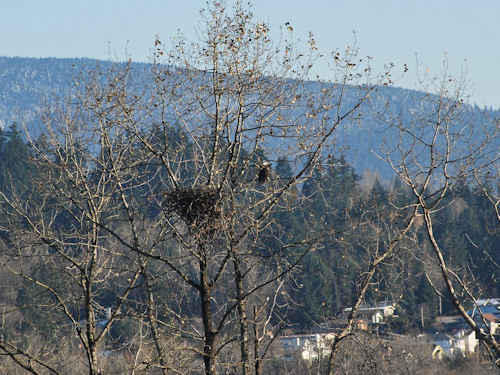
Two views of the new nest, November 23, 2010
Photo across the water towards the Port Moody plant is
by urban Eagle ©2010 Larry Dorosh, used with permission, all rights reserved
Photo from the Port Moody facility is
by sawrat ©2010, used with permission, all rights reserved
Based on other nests in the area, eggs could come any time from late February to mid April.
British Columbia
Sidney
Ma & Pa Sidney (2006-early 2018)
Pa & Missy
This pair fledged 2 eaglets, named Victoria and Sidney, in 2006. They laid two eggs in 2007, one of which hatched and successfully fledged; that eaglet was named Skye. This pair was observed building a feeding platform in 2007, which they made into a second nest that they used for 2008; attempts to place cameras in the alternative nest were unsuccessful - the tree was too high for the crane - so information for 2008 was provided by observers on the ground - who reported the successful fledging of three eaglets, named Sunny, Angel and Freddy. In 2009, there was a wide angle cam in each tree, and they again used the "new" nest, successfully fledging three eaglet, named Breeze, Hero, and Tiny/Tink. The old nest blew down in a windstorm in 2010, but the eagles were fortunately using the "new" nest (hereafter known as "the nest") again. They laid two eggs, but one was stolen by a raven shortly before hatching; the other egg hatched, and the chick, nicknamed Solo, successfully fledged. A wide-angle cam with night vision has been added for the 2011 nesting season. The pair laid 3 eggs in 2011 and all hatched successfully, but when they were about a month old, the oldest caught her foot in some fishing line that had been brought to the nest and ended up hooked to the side of the nest; thanks to a lot of work by a lot of people, a crane was brought in and she was freed; all three chicks, named Flyer, Snuggles and Burrows by local schoolchildren, fledged successfully. The adults may be working on a new nest for 2012 - guess we'll have to wait and see what happens. The adults did build a new nest on private proterty in 2012, and no pictures have been published, per request of the landowners; local observers reported that they again fledged three eaglets. The pair used the same private nest in 2013; only one chick was seen, and it fledged successfully. Mom and Dad Sidney were seen in their territory in 2014, but apparently didn't nest. They've been seen near their 2011 nest - so we are curious to see what they will do in 2015.
The pair moved back to their new/dead-tree nest in 2015, and successfully raised one eaglet, known as Herbie Epicure Hancock; things didn't work out for a cam for 2016, but maybe we'll be able to see them again eventually. And the eagles moved again in 2016 - and observers eventually discovered their nest, and a chick they called "Parker."
The pair did not nest in 2017; there has been a lot of development in the area which has resulted in the loss of perch trees, and it looks as if another pair is nesting at one end of what was once their territory - and on May 6 observers saw Ma and Pa defend their territory against at least two other eagle pairs. Hoping for the best for 2018.
Because there is no cam, we're not quite sure what happened in 2018 - but we know that Pa Sidney has a new mate; Ma was seen early in the spring, but it was a slender female who looked as if she may be fairly young who nested with Pa; she was named Missy by local observers. It's also possible that there was a second clutch - incubation was seen as of March 27, but the size of the chick seen on May 31 makes it unlikely it was laid that early - and the female seen with the eaglet (known as Genesis for a new beginning) seemed older and not as slim.
Observers weren't able to be at the nest as often in 2019, but confirmed that there were two eaglets, and are calling the female Missy.
Observation was again limited in 2020; there were two chicks and we think both fledged successfully. The pair was incubating for a while in 2021, but no chicks were seen.
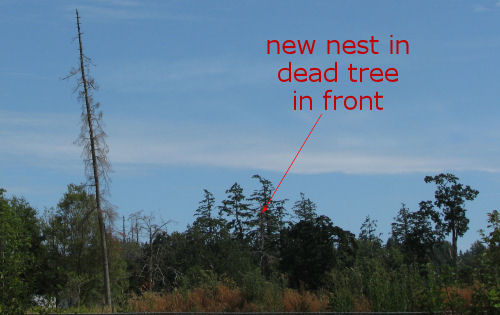
JudyB's photo - July 14, 2008
©2008 Judy Barrows, all rights reserved
(original nest is in the tall tree on the far right)
Based on past experience, look for eggs in early to mid March, chicks in mid April, and fledging in mid to late July.
British Columbia
Surrey Reserve
Sur (M) & Res (F)
There have been eagles nesting in this rapidly developing part of Surrey for at least 20 years, but cams were first installed in the fall of 2018 when a new nest was built as part of an agreement between the City of Surrey, the developers building a housing complex next to the nest area, and David Hancock. There were some challenges – the original nest fell down, the eagles moved, a new nest with cameras was provided (full story here) – but happily we got to see the eagles adopt the new nest built for them in British Columbia’s first bald eagle reserve. (A bald eagle reserve is a section of forest large enough to support an eagle nest which is set aside by a developer who is clearing land adjacent to it.)
Adults Sur and Res (named for Surrey and Reserve) laid two eggs in 2019, and eaglets SR1/Dee and SR2/Ess (named for developers Dawson & Sawyer, the original sponsors of the cams) both fledged successfully.
The pair laid two eggs in 2020, and eaglets
SR3/Thor and
SR4/Loki (names provided by their human neighbors) both fledged successfully on the morning of June 28, about 2 hours apart. Both were coming and going for about 4 days, and then Loki did not return for the night on July 1st. We learned that Loki was found the evening of July 1 danging from a power line about 300 yards from the nest, and the people who found her called OWL; they were able to capture Loki (after she demonstrated that she could still run and make hopping flights); they did not find any obvious injuries but kept her for observation for 5-10 days in case he got a jolt from the power line since that can cause internal damage that is not immediately visible. Loki was found to be healthy (and likely female, based on weight), and was released from OWL in Peace Arch Park (near the nest) on July 17; she did not return to the nest - but she was banded (blue band on her left leg with silver D over 3), and she was equipped with a tracker; her tracker code is BETA04 and you can follow here travels here. As of August 26, 2020, she was exploring the islands off the Alaskan Panhandle.
2021 was another eventful year. The pair again laid 2 eggs, and both hatched, becoming SR5/Tiku and
SR6/Tucca (names suggested by a student from Ontario whose class was following the nest). Both accidentally fell June 24, 8:39 am, when Tiku bumped into Tucca while landing on the little perch (Tiku 82 days old, Tucca 81 days old); they landed on/among branches below the nest; Tiku had been more actively branching and recovered fairly quickly and flew off; it took a couple of days before Tucca got out of the tangle of branches and managed to fly off; I'm listing the times they flew from the tree as the official fledge times (details here). July 14 at 5:30 am was the last time we saw both fledglings together; Tiku may have stopped by once or twice after that - but usually if one fledgling is on the nest with food, the other one comes screeping in for a share; Tucca did spend a couple of days eating and sleeping on the nest after he finally got back there, so it makes sense to me that it would take a few extra days before he was ready to leave. We think it likely that both fledglings are male; they seem the same size, and sometimes looked huge, but other times not quite as big as Res; also, David Hancock said that Tucca's ear-piercing screep suggested he was male.

gemini's photo - October 17, 2018
©2018 Sharon Miletic, used with permission, all rights reserved
Based on past experience, look for eggs in early-mid March, chicks in mid April, and fledging in mid to late July.
British Columbia
White Rock
Mom & Dad White Rock
This nest is on a private portion of the White Rock bluff overlooking Boundary Bay. The nest tree is only about 100 feet from the back porch of the family who has generously provided the cameras, and the nest is about 120 feet up the tree. It was built in November 2009 after the pair's original nest, 500 yards south of this site, was disturbed by construction. The eagles successfully raised two chicks, named Alpha and Bravo by the landowners, at this new nest in 2010. In 2011, their first year on cam, the eagles laid two eggs, both of which hatched; the two eaglets, named Charlie and Delta, fledged successfully. The nest looked a little precarious by the end of the 2011 nesting season, so additional supports were added when the cams were cleaned in fall 2011. 2012 was another good year for this pair, and eaglets Echo and Foxtrot ("Foxy") fledged successfully. Their nest was looking a bit precarious by the end of 2012, so when David Hancock installed additional PTZ cams, he made sure they would also provide a look at another tree that looked promising for a nest, and may have added a few branches to help them get started in case they decide to move. 2013 was a hard year at White Rock; it appeared to many observers that a new, possibly young, pair took over the nest. They laid two eggs, but were not consistent about incubating them, and near the hatch date, a subadult landed while the adults were away and broke one of the eggs; David Hancock reviewed the video of the event, and said it looked as if the embryo had stopped developing at 10-12 days, probably from lack of incubation. The adults stopped caring for the remaining egg after that, and it was destroyed by a juvenile eagle a week or two later; it also appeared only minimally developed. As I write this in October 2013, a pair of eagles is working on the nest - and we're hoping for a better year in 2014.
2014 was a much better year, though not without a bit of sorrow - we're not sure if the original pair returned, or if last year's pair matured, but the adults seemed very competent, and laid three eggs; about half way through the incubation period, we lost one of the eggs - it stuck to the adult's chest when he got up (perhaps already cracked?), and fell off as he moved to the side of the nest
and bounced off the nest rails; it appeared intact, but it was soon obvious that one of the eggs was broken, and the female removed the pieces. The other eggs hatched successfully, and the chicks named Indy and Jules fledged successfully.
All went well in 2015
- two eggs were laid, and the chicks named Kilo and Lima fledged successfully - but about two weeks after they fledged, while they were still using the nest for food drops - the nest came down. We are very happy that both fledglings were old enough that they didn't need a nest - and we're eager to see what the adults will do next year.
The eagles built a new nest for 2016, in a tree which was just barely visible from one of the cams; local observers reported when they seemed to be incubating - and reported that they appeared to be feeding chicks. The new nest fell down when the chicks were about 10 weeks old, and fortunately both chicks were able to cling to branches, and there was enough nest left that one at a time could lie down, at least initially. Observers reported that the adults were feeding them on the branches, and both seem to be doing well. The fledglings (who were not named) spent several weeks in the area, visiting the old nest tree and the human-built nest, so were eventually seen up close on the cams.
In preparation for 2017, some supports were added to the new nest tree and cams were installed - and happily they used the nest, laid two eggs - and Mary (after David Hancock's late wife Mary Scott) and Oscar (returning to the aviation alphabet) fledged successfully.
There were issues with intruders at the beginning of the 2018 nesting season, and not much work was done on the nest - and no eggs were laid. The adults did work on the nest some in 2019, but didn't lay any eggs; David Hancock has noted that there are several pairs nesting in a fairly small area, and they may be stressed by the close proximity of other eagles, because I believe David said none of them raised chicks.
2020 was a happier year, though a bit unusual. They pair laid two eggs and one hatched and was named Quebec (P for "Papa" was skipped in the aviation alphabet - posting about Mom feeding Papa could easily be confusing!). All went well until July 2nd, when Quebec had what may be the most unusual fledge I've ever seen. The 75-day-old chick was sound asleep in the middle of the nest when he or she jumped up at 3:07 in the morning, ran to the edge and left; my guess is that something startled him/her - maybe a raccoon climbing the tree? We didn't hear anything on the cam, the adult who was probably nearby didn't call, no one subsequently came to the nest. Local observers looked for the chick in the morning, but it's rough terrain with lots of trees - more suited to eagles than humans. The zoomers did see a young eagle at the beach who had similar coloring - so we were hoping it was Quebec - and the young eagle successfully returned to the nest five days later. Quebec remained in the area for the rest of July, visiting the nest regularly before heading out to explore the world.
2021 was also a bit strange - the eagles only laid one egg, and that was almost a month later than usual. The egg hatched, and Romeo fledge successfully and uneventfully.
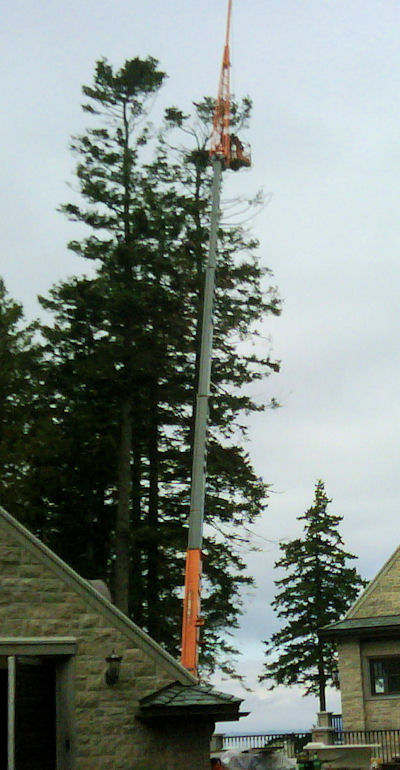
Photo of David Hancock installing the camera, September 16, 2010, by richardpitt
©2010 Richard Pitt, used with permission, licensed under a Creative Commons Attribution-Noncommercial-Share Alike 2.5 Canada License.
Based on past experience, look for eggs in early-mid March, chicks in mid April, and fledging in mid to late July.
California
Anacapa Island
Oak Canyon
no cam
adults A21(M) & A11(F)
Male A21 (removed from a nest near Juneau, Alaska, in 2003 and released from the North Hacktower on Santa Cruz Island) and female A11 (removed from a nest near Juneau, Alaska, in 2002 and released from the North Hacktower on Santa Cruz Island) established a territory in the Yellowbanks area on the south shore of Santa Cruz Island in 2008 (see below).
They were a non-breeding pair in 2009 and 2010, then moved to Anacapa and became the Oak Canyon pair; A21 was seen in the Yellowbanks area with A48 for a while early in 2011, before settling on Anacapa with A11 and raising their first eaglet. Dr. Sharpe noted that their new territory is visible across the water from their former small Yellowbanks territory on Santa Cruz Island. The nest is on an island that is not normally accessible, so reports were sketchy - but we know they laid at least two eggs, and at least one hatched, and that chick fledged successfully. Their nest is on a hillside, and near to the ground - the eaglet jumped down and ran away when Dr. Sharpe and his team arrived for banding. The pair nested again in 2012 and appeared to be incubating or brooding when the nest was viewed from a boat in early April, but there didn't seem t be any activity when the nest was viewed from a boat in May; a site visit in June confirmed that the nest had failed, though they don't know when or why, due to the limited access granted to the biologists. Another interesting development is that male A21 was seen with A11 on Anacapa and also seen spending time with female A48 on Santa Cruz - so it will be interesting to see if there is a switch of partners in the works. Success for A21 and A11 in 2013 - we don't know how many eggs they laid - but there was a healthy chick in the nest when the team arrived for banding, and A90(M)/CBrink fledged successfully. A pair appeared to be nesting in 2014, but the nest can only be seen by sea when one is quite a distance from the shore, and the presence of nesting cormorants kept the IWS team from approaching the nest at banding time, so we don't know if there were fledglings, and if there were, they were not banded or tagged.
2015 was similar - it appeared while viewing from a boat that the pair was incubating and then brooding, and a chick was seen June 1st - but we don't know how s/he did or if there were other chicks because of the restrictions on access to the nest.
Access to the island has been very limited, so we don't have results for 2016, 2017 or 2018; two 4-week-old chicks were seen during a helicopter survey in early June 2019, but they weren't banded and we don't know if they fledged. The pair didn't nest at either of the two known locations in 2020.
A11 and her mate (probably still A21 but they couldn't confirm his identity) laid an egg on June 1st, 2021, but sadly it had disappeared by June 5th; they did set a record for the latest date for an egg to be laid at an IWS nest (previous date was late April). According to the trail cam reports, they did spend time working on both of their traditional nests - and I'm wondering if there might be a third nest that hasn't been discovered - the late date would make more sense if it was a second clutch.
A11 hatched in 2002 and A21 in 2003, so they both are older adults and may have accumulated more toxic chemicals in their bodies from their years of fishing, making it possible that their eggs are more thin-shelled than most, and more likely to break.
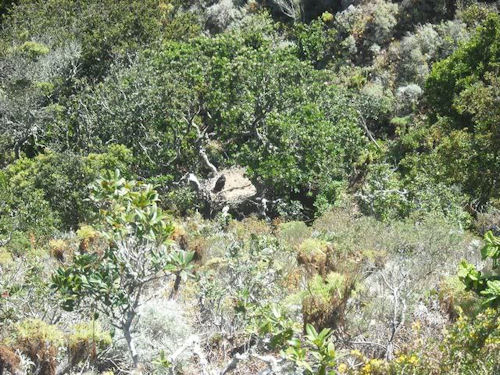
Peter Sharpe's photo - June 7, 2011
California
Big Bear
adults called Lucy and Ricky on Facebook (2012-2016)
Mr & Mrs BB (2017-2018)
Shadow (M) & Mrs BB
("Jackie")
The Big Bear Bald Eagle Nest at Big Bear Lake near Fawnskin in the San Bernadino National Forest, inland from Los Angeles. From the information on Facebook, it appears that they are early layers, with a possibility of eggs in late December or early January - and unfortunately that doesn't always work out. Dr. Peter Sharpe from the Institute for Wildlife Studies noted in their chat that "This nest is at an elevation of ~7000 feet, so it is probably one of the highest bald eagle nests." It does make me wonder why they nest so early - the Channel Island nests are later (though many of the eagles there - or their parents - were imported from further north where eagles were more plentiful when the bald eagle restoration project on the islands began, so they may be on a northern schedule). I did look at a map of the US, and found that this nest isn't that much further north than the nests in Florida, and is a bit south of the Carolina Raptor Center, in the southern part of North Carolina.
From the Facebook page, they successfully raised an eaglet named Jack (who turned out to be female) in 2012, but lost eggs or young chicks to cold snaps in 2013 and 2014. They were raising a chick named Shadow in 2015, and I didn't find a report of a fledge, but he/she was looking good and was near full-size in posts I did find, so here's hoping that went well. They ended up using a different nest in 2016, and as of April 25, it was reported that they had two 8-week-old eaglets (which would mean eggs around January 20 with hatching around February 28).
A young adult was seen at the nest in the fall of 2016 and was joined by another young eagle in January 2017; the new pair spent a lot of time working on the nest, and I think they may have eggs in 2018.
The young pair that formed in 2017 produced two eggs in 2018; both hatched, but sadly the younger one (Baby Big Bear or BBB) died as a result of heavy rain and freezing temperatures when s/he was 5-1/2 weeks old; the storm came at just the wrong time, when they didn't have enough feathers to stay dry but were too big to both fit under Mom; older eaglet Stormy had a premature fledge but found his wings and returned to the nest 11 days later - and was seen visiting the nest (and being fed) for another month; during that month, it seems that Mr BB wasn't being seen that often - and a subadult was visiting, and sometimes on the nest with Mrs BB - so there may be a change for 2019.
The subadult from summer 2018 became the resident male in 2019; he was named Shadow because he still had a lot of dark feathers on the head and tail; Shadow and Mrs BB (also known as Jackie) produced two eggs, both of which hatched, but sadly younger eaglet Cookie died after a night of rain and snow and below-freezing temperatures; he was 6 weeks old - too big to fit under Mom, and not quite old enough to be waterproof. Older eaglet Simba fledged successfully - but later than most; he was 100 days old or a bit over 14 weeks; he or she remained in the area for almost a month after that. Shadow and Jackie laid two eggs in 2020 but neither of them hatched; they continued incubating until day 65 for the first egg.
2021 was a hard year - the first egg was taken by ravens the afternoon of January 7, the day after it was laid- Shadow had not been seen since the previous morning and may not have known there was an egg, and didn't come to the nest to take over incubation, so at some point Jackie had to leave to get food. Jackie laid two more eggs but #3 appeared to have broken either before or during the laying process; the pair had not been incubating as consistently as usual, and part of that may have been that something was wrong with the third egg, making it uncomfortable for her to brood. More sad news - the remaining egg (#2) was eaten by ravens the day after #3 was laid; as Friends of Big Bear Valley and Big Bear Eagle Nest Cam noted on Facebook, "The eagles have clearly been focused on something else, we will never know what that may be." The pair laid a second clutch about a month later, but there was even more sad news - one of the eggs from the second clutch began to hatch and little peeps were heard, but apparently the chick died during the night without completing the hatch process; the remaining egg didn't hatch and was eventually taken by ravens on April 17 (day 65 if the second egg).
California
Catalina Island
Empire Quarry
no cam
adults K51(M) & K03(F) (2014-2016)
unknown male (maybe K51?) &
K18/Solitaire (F) (2019-2021)
K51/Fletcher (M) & K55/Sammy (F)
(2022-
A new pair was found in 2014 (initially called Cherry Cove before their nest was found) who may nest this year in this new territory near Twin Rocks. K51 hatched in 2005 from an egg produced at the San Francisco Zoo and fostered in the Pinnacle Rock nest, and spent some time with Wray a couple of years ago while K01 was off on vacation; K03 is a 2007 naturally hatched chick from the Seal Rocks nest; they built a nest and laid two eggs, but the eggs didn't hatch (not unusual for a new pair). Unfortunately 2015 was a repeat - two eggs were laid, but neither hatched. Maybe next year....
There were two eggs in 2016 but neither hatched; Dr. Sharpe said in the Apr 9 2016 update that the remaining egg might not hatch because "the female still has trouble laying down and standing up from the egg, likely because of an old injury. This makes proper incubation difficult." - I hadn't realized she had mobility issues; for the record, K03 is a 2007 naturally hatched chick from the Seal Rocks nest, from before the non-cam chicks were named..
The pair wasn't seen in the area in 2017 or 2018. In 2019 a new pair was seen - K18/Solitaire (Two Harbors 2011, nicknamed "Sassy") and her mate; they didn't nest - but maybe they will in 2020. They didn't nest in 2020, but a pair was seen incubating in 2021 on a new nest on February 13 and March 5, but sadly something went wrong - there were no adults in the area when the team checked on March 22. It's possible they used that nest in 2020 when they weren't seen nesting.
June 24, 2022, per Dr, Sharpe, "K-18 was last seen in 2020. K-51 had another mate in January, but she was replaced by K-55 at the end of January." Dr. Sharpe clarified that K-18 was seen flying in the area of the nest in January 2021, but was never confirmed at the nest that year, though there also wasn't anything to prove conclusively that it wasn't her. Looking at the CHIL records, K55/Sammy hatched in the Seal Rocks nest in 2015 (parents were K25 and K34) and spent some time at Big Bear Lake from December 2016 - November 2018. Dr. Sharpe also said they were able to read all but the last digit on K51's band in January 2022, making them reasonably certain that he is still the resident adult; the trail cam stopped working after January, and they are hoping to confirm the ID in the fall. On a personal note, I won the right to name K51 in IWS's Nest Adoption Challenge, and named him Fletcher in memory of my brother (Fletcher was an old name for the place where we grew up). The pair was seen incubating, but there were no reports of chicks or banding, so they may not have been successful.
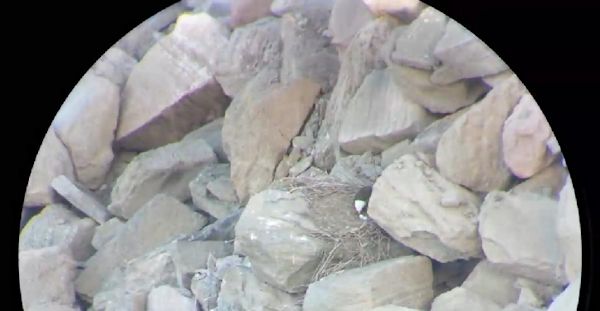
photo from Maria's video - March 2014
California
Catalina Island
Middle Ranch (formerly Thompson Reservoir)
no cam
adults K93(M) & A32(F) (through 2009)
adults K93(M) & A37(F) (through 2013)
adults K88(M) & A37(F) (2014)
A37(F) alone (2015)
K00(M) & A37(F) (2016)
K08/Scout (M) & A37(F)
Male K93 (produced by the San Francisco Zoo in 1999 and released from the Bullrush Hacktower on Catalina Island) and female A32 (removed from a nest near Juneau, Alaska, in 2004 and released from the North Hacktower on Santa Cruz) became a pair in 2007. Dr. Sharpe and Steffani of IWS built them an artificial nest in December 2007 because they hadn't had much luck with nest building; they added branches and used it as a feeding platform, but did not lay any eggs in 2008. They built a nice new nest for 2009, but did not lay any eggs. In 2010, A32 was replaced by A37 (produced by the San Francisco Zoo in 2005 and released from the South Hacktower on Santa Cruz) - and the pair laid their first egg ever! The egg hatched, but the eaglet (male K-98) sadly died a couple of days after fledging, most likely from dehydration; it was very hot, and he had been fed a lot of squirrel (which is dry) and not a lot of fish (which contains a lot of water). This pair had another sad year in 2011; they laid two eggs, one of which hatched but failed to thrive and died within a week or two of hatching; it's not clear if the second egg disappeared during incubation or failed to hatch - hard to see into the nest. We're hoping they'll finally have a successful season in 2012. Another sad year for the Middle Ranch pair in 2012 - they laid two eggs, but one disappeared a few days later, and the other apparently broke or was broke about three weeks after it was laid. Here's hoping they'll have better luck in 2013. K93 and A37 laid two eggs in 2013; one disappeared within the first 10 days, the other hatched and K30 (M)/Blaze fledged successfully. Sad news in fall 2013 - the IWS team received a report that an eagle was dangling from a tree; they were able to rescue K93 and brought him for treatment, but circulation to his lower leg and foot had been cut off for too long, so he was euthanized on October 30. Rest in peace, K93.
Male K88 (naturally hatched from Twin Rocks in 2008) had been spending time with K87 as pre-nesting adults, and went with her to West End in the fall of 2013, where she stayed but he did not (I suspect the resident male K01 helped him make that decision); he was seen with A37 in early February 2014, and they produced two eggs, one of which broke and the other disappeared near hatching time.
2015 was a year off here - male K88 moved to the Pinnacle Harbor Nest, and A37 spent the spring alone; the wonderful annual summary on the CHIL forum (All Eagles All The Time: Season 2014/2015) reported that male K00 (formerly from the Twin Rocks nest) had been seen with A37 - he hadn't been successful at Twin Rocks - so we're all hoping they will finally have chicks in 2016.
K00 and A37 did lay at least one egg in 2016, but the nest was empty a week later. IWS reported in early 2017 that K08(M)/Scout-Seal Rocks 2011 apparently replaced K00 as the male here; they did not nest in 2017. K08(M) & A37(F) produced two eggs, but the nest failed, perhaps because of harrassment by crows or ravens; they built a new nest, but didn't lay a second clutch.
For 2019, K08/Scout was still the male; A37 may still be the female - hard to tell without tags; whoever they are, they built a new nest for 2019, laid at least one egg, and successfully fledged 1 chick; the eaglet wasn't banded because the tree was hard to access; this is the first eaglet here since 2013. The pair laid at least one egg in 2020, and the chick named Concord fledged successfully; the eaglet wasn't banded. The pair produced two chicks in 2021; they weren't banded but Sasao Le Matagi (means soar the wind) and Sharilyn fledged successfully.
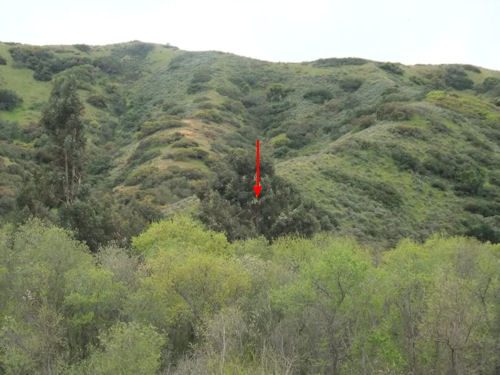
eaglegal's photo - March 7, 2011
(the nest as seen from the road near Pimu's enclosure)
California
Catalina Island
Pinnacle Rock
no cam
Adults K65(M) & K92(F) (through 2008)
Adults K65(M) & K56(F) (through 2011)
Adults K73(M) & K56(F) (through 2014)
Adults K88(M)/Muir & ?K56(F)?
Male K65 was removed from a nest near Steep, Vancouver Island, BC, in 1986 and released from the Bullrush Hacktower on Catalina Island; female K92 was raised at the San Francisco Zoo in 1999 and released on Catalina Island from the Bullrush Hacktower. This pair was allowed to keep their eggs in 2007 (instead of having them removed for incubation), and both hatched - making them the first pair of chicks to hatch naturally without human assistance on Catalina Island since 1945; males K00 and male K71 both fledged successfully, but K71 was found dead in September. The pair laid two eggs in 2008; both hatched and male K70 and female K71 fledged successfully, but K71 was found dead July 24, probably of starvation; K70 was still on Catalina Island as of January 2009. (There were two K71s because numbers of eagles that die are reused; it was a coincidence that the number was used again at the same nest.).
There was apparently a change of partners at the beginning of 2009, with female K56 becoming K65's new mate. We don't know what might have happened, only that K92 has not been seen. K56 was from an egg laid at Seal Rocks, taken to IWS for incubation, and then fostered back into the Seal Rocks nest in 2005. The new pair laid two eggs in 2009; one was lost a week or so before its hatch date and the other produced female K99, who fledged successfully but was sadly lost 2 months later, probably while trying to fly to the mainland. The pair laid two eggs in 2010; one was lost a month or so later, and the other produced female K95, who fledged successfully. This pair laid two eggs in 2011; one was lost fairly early, and the other failed to hatch. We hope they'll have better luck in 2012.
There was another change in partners, with male K73 replacing K65, who had a physical encounter with K25 (the Seal Rocks male) in the fall of 2011; K65 ended up in the water and a boater followed as the 25-year-old eagle made the long swim back to shore; Steffani went to check in the morning in case he was injured on the beach but could not find him; he hasn't been seen since. The new male K73/Wind is one of the West End triplets from 2007 (and a personal favorite of mine - that was the last year that they had three adults helping to raise the chicks, and it was such fun to see how they shared the duties). The new pair unfortunately did not have a good year - the first two eggs were lost within a couple of days of being laid, and while they incubated the third egg past the expected hatching time, it didn't hatch. Hopefully they'll have better luck in 2013. 2013 was a good year for the relatively new pair - they laid two eggs, both hatched, and K14 (M)/Shay Awahili and K16 (F)/Rose both fledged successfully. K14 was rescued from the water about a month after he fledged, and sadly his body was found on a mainland beach about a month later. The pair laid two eggs in 2014, one of which hatched, and K44 (M)/Arnie fledged successfully.
There was another partner change for the 2015 season - male K73/Wind apparently went north for his post-season vacation, and was sadly discovered dead under a power line near Glenwood, WA. It took a while for the IWS crew to identify the new male here - it turned out to be K88, who was the male at Middle Ranch in 2014; the female no longer has tags - they are guessing it's still K56, but would need to get a close shot of her leg band to be sure. The new pair laid two eggs and one hatched, but sadly the chick disappeared when it was around 4 weeks old, perhaps in a fall from the nest. We're hoping for a happier and more productive year in 2016.
The pair had two chicks in 2016 - K66(F) and K68(M); they had two eggs in 2017 but there was only one chick by banding day - orange band 07/A (F)/Maxiwo Eneq (name means Eagle Woman in Chumush); visits to the nesting territories have been down in recent years, so I don't know if the second egg hatched. Male K88 was named Muir in 2018; we think K56 is still the female but she no longer has tags so not sure; they had two eggs and one hatched and received leg band 30/A (M); he was named Kalani. The pair laid two eggs in 2019; one disappeared and the other hatched and the eaglet fledged successfully; it was not banded because of the difficulty in reaching the location. There was no trail cam in 2020 so less info, but the pair produced at least one chick, who wasn't banded but received the name Joraine. They also had one unbanded chick named Adtian in 2021; it was seen near fledging, so they assume it fledged.

eaglegal's photo - February 11, 2009
(the nest is at the end of that narrow point)
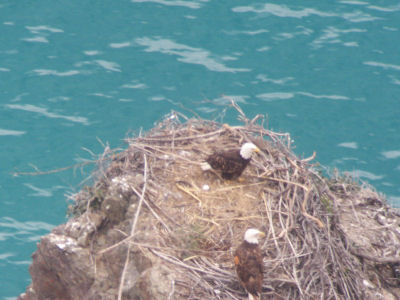
Eagle Guy's photo - February 27, 2009
Pinnacle Rock pair with their first egg.
Based on past experience, look for eggs in late February and early March, chicks in early April, and fledging from mid-June to early July.
California
Catalina Island
Rattlesnake Canyon
no cam
adults K80(M) and K47/Rae (F)
This is a relatively new nest with male K80 (who came from an egg laid at the San Francisco Zoo and fostered into the West End nest in 1998) and female K47 (produced at the San Francisco Zoo in 2004 and fostered into the Seal Rocks nest). They nested and laid eggs in both 2008 and 2009, but the eggs disappeared shortly after they were laid both years. It seems that the instinct to incubate the eggs isn't quite as strong as the instinct to produce and lay them, especially for male K80. This pair laid two eggs in 2010, and were successful in hatching both of them, and raising them to the point of fledging; unfortunately both were found dead of unknown causes within a couple of days after fledging, under a bush near the nest. 2011 was a good year for this pair - they laid two eggs, both of which hatched, and both eaglets K15(F)/Ho'ihoulala "Lala" and K19(M)/Robben fledged successfully and were still on the island and doing well as of mid-August 2011. This pair definitely have their ups and downs - and this year started out well, but ended sadly; both of their eggs hatched, but the younger chick was apparently blown out of the nest during a terrible wind storm when he was about a month old; the remaining eaglet was a male, banded as K22 and named Jerry; he fledged successfully, but apparently drowned about a month later. K80 and K47 laid two eggs in 2013; both hatched, but there was only one chick in the nest during a check about a month later; it's likely that sibling rivalry was involved, but with nests that are only checked once or twice a week, it's hard to know what might have happened. The remaining chick K39 (F)/Lina fledged successfully, and was rescued from the water about 6 weeks after she fledged, but tried again to reach the mainland about 3 weeks later, and her body was found near Laguna Beach.
The pair moved to a new nest for 2014, and laid two eggs, one of which hatched; the eaglet K46 (F)/Tiana was banded June 14, and less than two weeks later, a large branch naturally broke off from the tree, and 64-day-old K46 was found on the ground with two broken legs. She was taken to the mainland for surgery, then returned to the IWS office to recover; the pins were removed August 13, and she tried to stand August 20; by the end of the day on August 23, she was able to stand on both legs without using her wings for balance, and even managed to put one foot on a fish! On September 3 K46 was moved to a small enclosure within the enclosure of non-releasable adult Pimu; she adapted well, and on September 11 was let into the larger enclosure to share it with Pimu, and she was soon on the high perches. K46 has some feather damage, but it did not appear to interfere with her flight from one perch to another, and she was able to curve around the tree in the middle of the enclosure while flying (probably trickier than a straight flight), so she was given a backpack transmitter and released near her nest on October 13, with 2 pounds of mackerel nearby; her parents were in the area and saw the release but didn't interact with her. K46 took her first flight in the wild at noon, then tried a couple of perches and spent the afternoon perching. On October 16 she discovered a deer carcass being shared by other eagles, ravens and hawks and joined in the feast - her first feeding in the wild! After keeping an eye on K46 for a bit over a week, the staff had commitments elsewhere for a week or so - and when they went to look for her in her nest territory on October 24 - they couldn't find her! They searched with their tracking unit for several days, and hoped she had a faulty transmitter - and then they discovered she'd left the territory, and was living in the town of Avalon! The new nest is near a children's science camp - so K46 grew up accustomed to the noise and bustle of people. The IWS team tried to lure her away from town by putting food on the hillside, and she explored that area and found the food - but returned to town. On November 20 they trapped her, gave her a health check (a bit underweight but otherwise fine) and released her beside the reservoir near the Middle Ranch territory. It's an area where there's food that's relatively easy to catch, less ravens to harrass her, and an adult eagle (female A-37) that she can watch to learn eagle behavior. The team provided food twice a day while she was at the reservoir, to encourage her to stay there and to help her transition to hunting on her own. On November 27 they found her eating a bird she probably caught, and by December 4 she began exploring the areas outside her new home territory, as most young eagles do 4-6 weeks after fledging. As of the end of December, she was flying well, and spending time at the Reservoir - and occasionally visiting her "roommate" Pimu (who is not necessarily thrilled to see another eagle nearby); food is now being tied down in the water to keep ravens from taking it, and to keep K46 from associating the food with humans; K80 and K47 are rebuilding their nest for the coming season.
2015 was a better year - K80 and K47 laid two eggs, both hatched, both chicks were banded when they were too young/small for wing tags, so they got colored ID bands as well as the federal bands, and orange 5/R(M) (on right leg)/Mica and orange 5/G(F) (on left leg)/Golwin both fledged successfully. And 2014 juvie K46/Tiana was seen in July 2015, looking healthy and having grown a complete new set of tail feathers. On a personal note, I had the honor of naming 5/G, and chose/invented the name Golwin, for the touch of gold in her wings and the golden winds that will soon help her explore the hills around her nest; the name is also a quiet tribute to the memory of Richard Pitt from the Hancock Forum, my mentor in all things forum, and the Gold Wing motorcycle he loved.
K80 and K47 fledged on chick in 2016, K69(M)/Thor, and fledged one chick in 2017, K71(M)/Dyami (name is native American for eagle). They raised 2 chicks in 2018, leg bands 27/A (M)/Timbo and 59/A (M)/Casper. They fledged one chick in 2019, leg band 12/A (M)/Ramsey. Female K47 was named Rae in 2020; the end-of-season report says she and K80 laid and lost 3 eggs, one in a first clutch, two in the second. The pair built a nest in a eucalyptus tree near White's Landing in 2021 and produced one chick who is assumed to have fledged successfully.
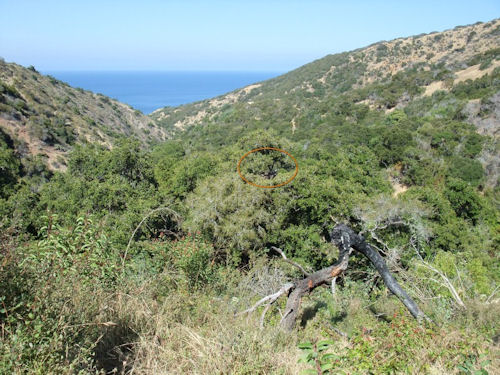
eaglegal's photo - June 22, 2011
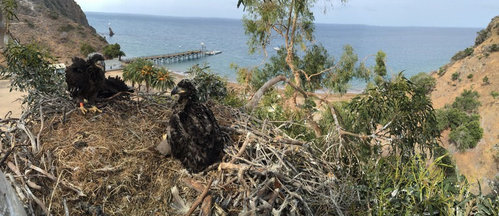
IWS photo - May 13, 2015
Golwin (back to cam) on banding day
California
Catalina Island
Seal Rocks
no cam
adults K25(M) & K34(F)/Grace (through 2017)
2011 - neither adult has tags; may be the same pair but can't be sure
adults K25(M) ? & K32(F)/Shasta (2018 & 2019)
young unbanded male & K32(F)/Shasta (2020 -)
Male K25 was hatched from an egg removed from the West End Nest in 1992 and fostered into the Pinnacle Rock Nest; female K34 was raised at the San Francisco Zoo in 1993 and released on Catalina Island from the Bullrush Hacktower. This pair was allowed to keep their eggs in 2007 (instead of having them removed for incubation), and both hatched - making them the second pair of chicks to hatch naturally without human assistance on Catalina Island since 1945 (Pinnacle Rock was first, a week earlier); female K03 and male K77 both fledged successfully; K77 was last seen on Catalina Island in November 2007, and probably explored neighboring islands until June 2008, when he drowned while trying to fly to the mainland. The pair laid two eggs in 2008; one broke after about 10 days, and the other hatched to become male K62 Gulliver; he fledged successfully, but drowned about 4 months later while trying to fly to the mainland.
2008 was the first year IWS has a cam on this nest; the eagles moved their nest for 2009 so there wasn't a cam in 2009 and won't be a way to have a cam in 2010. They did lay two eggs in 2009, but only one hatched, becoming male K90, who fledged successfully. They laid two eggs in 2010, one of which disappeared after a month or so; the other hatched and fledged successfully as female K05. The pair again laid two eggs in 2011, both hatched successfully, and K07(F)/Karis and K08(M)/Scout fledged successfully; K07's signal hasn't picked up since July 25 (presumed to have left the island or transmitter failed; no visual sightings either), and K08 was still on the island as of mid-August. Another good year at Seal Rocks in 2012 - they laid two eggs, and K20(F)/Pukuu and K21(M)/Micco both fledged successfully. And a repeat for 2013 - both eggs hatched, and K32 (F)/Shasta and K31 (M)/Edge fledged successfully. I like patterns like this - in 2014 they laid two eggs, both hatched, and K40 (F)/Julie and K41 (M)/Kilakila ("majestic") fledged successfully. The pattern continued in 2015 - they laid two eggs, both hatched, and K55(F)/Sammy and K57(F)/Tripina fledged successfully.
The pair fledged on chick in 2016, K64(F)/Connie (for the USS Constellation); the 2016 nest tree apparently blew down after the nesting season; the pair moved back to a former nest for 2017 and laid eggs about 3 weeks later than usual, but that nest failed.
We think K25 is still the resident male for 2018 (though he was hatched in 1992 so would be 26 years old, and he hasn't had wing tags for several years), but there is a new female, K32(F)/Shasta (Seal Rocks 2013, daughter of K25 and K34 - so a new Mom); the pair apparently lost their first clutch, then laid two eggs for a second clutch; at least one of them hatched and was banded 23/A (M) and named Wraymond in honor of Wray, the long-time female at West End, who was the mother of K25 and grandmother of K32/Shasta. (As an aside, it doesn't seem common for eagles to mate with a parent or a sibling - but it does happen from time to time.)
The pair laid at least one egg in 2019, but as far as we know, they didn't have any chicks. The pair used a different nest in 2020; the trail cam confirmed that the female is still K32, and the male is a young, unbanded bird, maybe one of the 2016 Bald Canyon chicks from San Clemente; I saw a report that there appeared to be eggs, but didn't see an update to learn if they hatched or fledged. The pair laid at least two eggs, at least one hatched, and 46/A (M)/ Wayne is assumed to have fledged successfully.
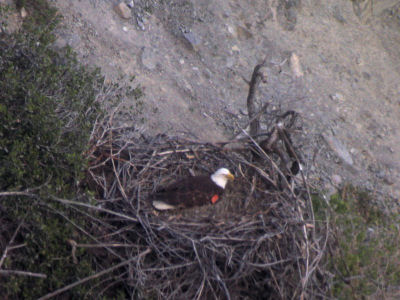
Eagle Guy's photo - February 27, 2009
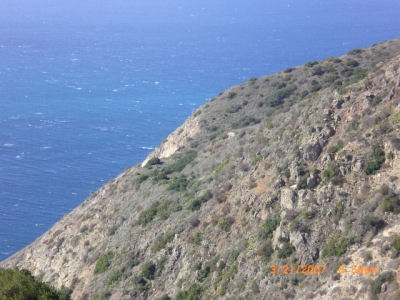
nancy's photo - March 21, 2007
This is the general area around the nest, but I'm not sure where exactly the nest is.
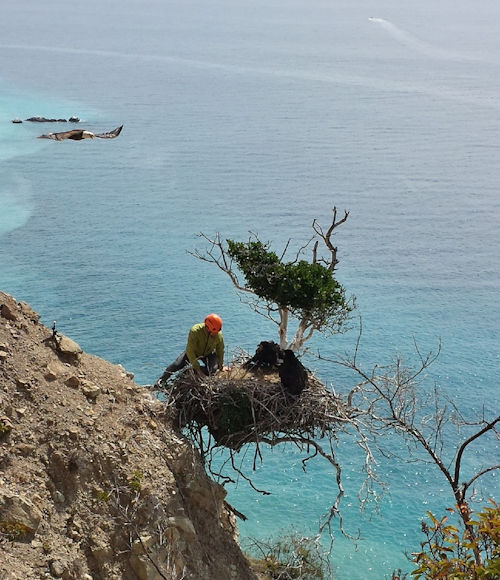
IWS photo - May 13, 2015
Another perspective, from banding day - note adult overhead.
Based on past experience, look for eggs in late February and early March, chicks in early April, and fledging from mid-June to early July.
California
Catalina Island
Twin Rocks
no cam
adults K33(M) & K17(F) (through 2011)
Adults K00(M) & K17(F) (through 2015)
Adults K00/Darwin (M) & K95(F) (2017 -
Male K33 was hatched from an egg removed from the Seal Rocks Nest in 1992 and fostered back into the Seal Rocks Nest; female K17 was brought from a nest in California as a chick in 1984 and released on Catalina Island from the Bullrush Hacktower. Both of the eggs removed for incubation in 2007 hatched, and the pair successfully raised K75 and K76 (both males). K75 was the only 2007 eaglet still on Catalina Island as of December 5, 2007. In 2008, this pair was allowed to hatch their eggs naturally for the first time. It's not known how many eggs were laid, but two hatched, and males K88 and K89 fledged successfully. K88 was sighted on the mainland August 19 and was seen in southwest Oregon in November 2008 and back on Catalina Island in March 2009; K-89 died around Sept 6 while trying to fly to the mainland. They laid two eggs again in 2009, and successfully fledged males K-96 and K-94. K-96 died while trying to fly to the mainland; as far as we know, K-94 is OK, though he hasn't been seen for a while. The pair laid two eggs in 2010, but stopped incubating a month or so later; not sure if the eggs were still there or if they had broken or otherwise disappeared, but either way, there were no chicks. Sad news again in 2011 - the pair laid two eggs and incubated them well past the anticipated hatch date, but neither hatched; female K17 is the oldest known bald eagle on the islands at 27 years old, so that may be a factor.
It appears that male K00 replaced K33 in 2012. K00 was one of the first two naturally hatched chicks on Catalina Island since 1945 when he and his brother hatched in 2007 at the Pinnacle Rock nest, so it's really exciting to see him back on the island after a bit of wandering, and perhaps settling down. The pair were seen together on and off through the summer, but did not nest in 2012. Maybe next year. K00 and K17 nested in 2013 and laid two eggs, but neither hatched, although they continued incubating the final egg until a month past the expected hatching date; K17 is now 29 years old, and may sadly be past the point where she can produce fertile eggs. The pair laid two eggs again in 2014 and in 2015, and neither one hatched either year. There will be changes for 2016 - Dr. Sharpe reported that K00 was seen at Middle Ranch in the summer of 2015, and K17/Crystal died in fall 2015 while being treated for injuries likely received during a fight with another eagle (she was found 100 meters from the Rattlesnake Canyon nest); she was the oldest bald eagle on the Channel Islands and the last surviving eagle from the 33 eagles released on Catalina from 1980-86 to begin the reintroduction process. It will be interesting to see if a new pair take over this location.
There were no reports of a resident pair in 2016. K00(M) who was at Middle Ranch in 2016 returned for 2017; his new mate is female is K95 (Pinnacle Rock 2010); they laid at least one egg, but the nest failed. The same pair tried again in 2018 with the same result. Happily 2019 was better - they laid at least two eggs and two chicks were seen initially though there was only one by banding day, 56/A (F)/Quiana ("one who lives her life with grace"); this was the first successful season for the pair - and the first chick in the territory since 2009. K00 was named Darwin in 2020, and the pair had at least two eggs, at least one of which hatched and eaglet Sam (not banded) fledged successfully. The pair had two eggs in 2021, both hatched, and unbanded eaglets Phoenix and Andres fledged successfully.

eaglegal's photo - August 8, 2007
fledgling K75 is the little bump next to the nest

eaglegal's photo - August 1, 2007
This shows the twin rocks that give the area its name. The nest is on the mainland overlooking the rocks - not sure if it's the bump we see on the right or if it's up a little higher.
Based on past experience, look for eggs in late February and early March, chicks in early April, and fledging from mid-June to early July.
California
Catalina Island
Two Harbors
adults K81/Chase (M) and K82/Cholyn (F)
The male K81 was hatched at the San Francisco Zoo in 1998 and fostered into the West End Nest, while the female K82 hatched from an egg removed from the West End Nest in 1998 and fostered into the Pinnacle Rock Nest; like most of the Catalina adults, they are generally referred to by their wing tag numbers instead of a nickname. They became a breeding pair in 2003, and K82 has laid six eggs from 2004 through 2007, five of which have hatched. Because of problems with DDT pollution which can make the shell of eggs too thin to hatch naturally, eggs from this nest are removed a few days after they are laid, replaced with artificial eggs, and placed in an incubator; when they hatch, the chicks are returned to the nest. This pair raised two eaglets, male K78 ("Sol") and female K79 ("Luna"), from the two eggs they laid in 2007. They laid two eggs in 2008, both of which were removed for incubation; one died shortly before hatching, while the other hatched and was returned to the nest, becoming female K83 ("Star"); she fledged successfully. In 2009, it was decided that there were enough productive nests on Catalina Island that the eggs would not be removed for incubation, and both their eggs hatched naturally! Females "Thunder" and "Lightning" both fledged successfully, and were both still on the island as of October 2009. This pair laid two eggs in 2010, and both hatched, becoming female K04 "Avalon" and male K06 "Gabriel"; both fledged successfully. The eagles laid 2 eggs in 2011; one disappeared after about 3 weeks; the other hatched, K18(F)/Solitaire fledged successfully, and was last seen on the nest October 14, when she was almost 29 weeks old, over 3-1/2 months after she fledged; the adults were still providing food during much of that time - quite unusual as most fledglings leave the nest area within a month or so after fledging. 2012 was a very sad year for this nest and those who watch this eagle family; they laid two eggs, but one broke near hatching time; the second hatched successfully, but when the chick was 3 weeks old, the male left for the night and the female didn't arrive to keep watch; an island fox entered the nest, and the young chick chased it off twice, earning the nickname "Lil Braveheart" - but the fox came a third time while the chick was asleep, and the fox took the chick. 2013 was a better year for this pair - they laid two eggs, one of which broke within 10 days, but the other hatched and K38 (F)/Echo fleded successfully. She was seen near the West End nest in early October, enjoying the bait put out by the IWS crew (see West End for details). The pair laid two eggs in 2014, one of which broke shortly after the second egg was laid; the other hatched, and K 43(F)/Shyla ("Daughter of the Mountain") fledged successfully. The pair again laid two eggs in 2015 - and this time both hatched! - but sadly one of the chicks fell from the nest May 1st, unfortunately on the side with a 300-foot vertical fall; the remaining chick became K58/EmeraldSkye (F)
The pair laid two eggs in 2016 - and for the first time since they began nesting, neither egg hatched. One may have broken, and Dr. Sharpe removed the remaining egg when the hatch window had passed, to test it for contaminants; he reported that it was filled with a yellow liquid, so if it was fertile, the embryo died very early in the development process; he also found and removed a sharp rock which might have damaged the other egg.
The pair moved to a new nest out of camera view in 2017; observers thought there might have been two chicks, but there was only one at banding day, and K72(F)/Washi (Japanese for eagle) fledged successfully. The camera is being moved, so hopefully we'll be able to observe this pair again in 2018.
Well, we had a cam for 2018, but K82 was injured, probably in a territorial fight, on February 14, just as the pair was entering the time they usually lay eggs; as of March 27, she recovered nicely, and the pair was working on their nest, and perhaps had the equivalent of a second clutch, laying an egg in early April; sadly their egg began to hatch (or crack) on May 17 (day 47) - and the next morning it was observed to be completely crushed; there had been a chick inside but it's not clear if it died while trying to hatch or had died earlier. 2019 was better - two eggs at the usual time, and 24/A (M)/Marcus and 57/A (F) Miss Cat both fledged successfully. The pair laid two eggs in 2020; one broke about 3 weeks later (it appeared to be non-viable or to have stopped developing early); the other one hatched and eaglet Champion fledged successfully. They again laid two eggs in 2021; one of them broke after 2 weeks, but the other hatched and became 16/D (F)/Toyon who fledged successfully.
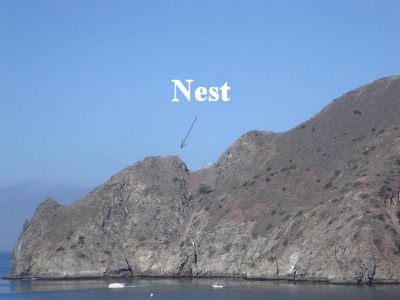
SoCal Lady's photo - June 24, 2007
©2007 SoCal Lady, used with permission, all rights reserved
Based on past experience, look for eggs in late February and early March, chicks in early April, and fledging from mid-June to early July.
California
Catalina Island
West End
adults K01(M) & Wray (F)
adults K51(M) & Wray (F) (brief fling mid-Sept 2010 - mid-Jan 2011)
adults K01(M) & Wray(F) (through fall 2013)
adults K01(M) & K87/Lightning(F) (fall 2013-April 2014)
adults K01/"Superman"(M) & K91/Thunder(F) (April 2014-fall 2019)
adults A61/Akecheta (M) & K91/Thunder (F)
This nest, established in 1991, is unusual in that it had three adults for a number of years. The female Dianna (K69) has wing tag on each wing and female Wray (no wing tags,but has a silver leg band) were brought from nests in British Columbia as chicks in 1986 and released together from the Sweetwater Hacktower on Catalina Island. Male K01 (sometimes called "Superman" ) was hatched at the San Francisco Zoo in 2000 and fostered into the Pinnacle Rock Nest; he replaced the previous male who disappeared before the 2006 nesting season at an age of 25. Dianna has not been seen since early in 2008, and there is hope she may have left to form a pair with an unattached male. According to Dr. Sharpe of IWS, Wray and the original male were a pair for a year before Dianna joined them, so she was the junior member of the trio. 22 chicks have fledged from this nest since 1991. Three of the five eggs removed for incubation in 2007 hatched, and the trio successfully raised female K72 ("Earth" ) and males K73 ("Wind" ) and K74 ("Fire" ). One of two eggs removed for incubation in 2008 hatched (though it was out of position for hatching and needed assistance to break out of its shell), and Wray surprised everyone by laying a third egg after the initial two were removed - which actually hatched naturally, although Dr. Sharpe put the chances of an egg from that pair surviving to hatch at less than 5% because of the contamination in the area. Both the incubator chick K65 "Miracle" and the naturally-hatched K67 "Surprise" are female. In 2009, both eggs were left in the nest, both hatched, and K98 "Faith" and K97 "Joy" (both female) fledged successfully, though K98 was found dead in the water 5 weeks later, perhaps while trying to fly to the mainland; K97's transmitter malfunctioned shortly after installation making her hard to track after she left the nest area; she was last seen on the island in late August 2009. The pair laid two eggs in 2010; both hatched and became K08 Dakota and K07 Aquila (both male); K08's transmitter was sending a mortality signal from the mainland shortly after he fledged, though he was never found and it might have been a transmitter malfunction (most eaglets don't try to fly so far so soon); K07 died a month after fledging, apparently drowned while trying to fly to the mainland.
As of January 2, 2011, K01 has not returned to the nest, and a new male K51 is courting Wray. K51 was hatched at the San Francisco Zoo in 2005 and fostered into the Pinnacle Rock Nest, and starting visiting the West End nest in September 2010. Wray at first chased him off, but over time has appeared to accept this young male - though he does need to work on a few technical details if they are to have chicks this year. K01 returned on January 13, and K51 hasn't been seen since then, though he may have returned to the outer islands; K01 was alone on the nest until January 23 when Wray joined him, and they immediately started acting like an established pair. They laid three eggs, all of which hatched; K12(F)/Aahana, K13(M)/Alerio and K14(M)/Prince Harry all fledged successfully, and K12 and K13 were still on the island as of the end of August; K14/Prince Harry's body was found in the water between Santa Cruz and Anacapa on August 30th. Update - K12 was seen in Alberta in October 2011, and in Montana in February 2012 - quite the traveller!
K01 and Wray laid three eggs in 2012, and all hatched successfully. K01 has always been a great provider, but this year there were some spells when he had trouble bringing enough food for his growing family (a sign of a change in the marine life in the area?), and there was intense sibling rivalry at times, with the youngest chick getting the worst beatings and the least food. The youngest chick, nicknamed MeToo, managed to survive, but was so far behind in development that she could not get wing tags or a transmitter when the team arrived to band her siblings, so she got a second leg band, becoming Orange 5Z. She also got her own pile of fish - several forum members contributed fish to be delivered to the nest at banding, and she was tagged first and returned to the nest with its pile of fresh fish while the team processed the two older chicks. K27(F)/Athena, K24(M)/Megwich and 5Z/Ge-nii (MeToo in a native language) all fledged successfully, though K24 sadly drowned several months later, and K27's body was found in Saskatchewan on October; there have been no confirmed sightings of 5Z, but the IWS team has seen a fledgling without wing tags, so perhaps.... 27-year-old Wray and K01 laid 3 eggs in 2013, and K27 (M)/Newton, K29 (F)/Marthe and K28 (F)/Bella all fledged successfully. K28 was rescued from the water about 2 weeks after she fledged, and she and K27 were rescued again the following week; K29 wasn't as lucky - her body was found a week later, on a beach on the mainland. Bait was put out for several weeks in fall 2013 in an attempt to trap Wray, who was observed limping; as far as we know she didn't approach the site (though the team saw her grab a fish, do a poop shot and scratch her head on Oct 1 after the last bait drop, suggesting she was not debilitated, though they didn't see her walk); K28 and K38 from Two Harbors enjoyed the free food.
A non-breeding pair, K87(F)/Lightning (Two Harbors, 2009) and K88(M) (Twin Rocks, 2008) visited the West End nest in fall 2013; as of late October, K88 hasn't been seen for a while, but K87 has been spending time at the nest with K01. We suspect that K01 sent K88 packing - but it's up to Wray to deal with a new female; we are hoping that Wray is just taking a leisurely break from nesting - but are aware that a confrontation between Wray and K87 may have already occurred, and Wray may have lost to the younger eagle. 2014 was a year of transition - Wray was not seen, and K87 appeared to be claiming the nest, though she and K01 did not seem to be bonding well, either physically or in the more illusive sense of appearing to share space comfortably - but K87 was young and K01 was used to a different mate, so we thought perhaps they'd take a year off - when there was another switch in early April - when K87 was challenged by another young female, who turned out to be her older sister K91/Thunder, also hatched at Two Harbors in 2009; there seemed to be more mating between K01 and K91 than there was with K87 - but no eggs this year. However, things are looking promising for 2015!
2015 was a tough year for observers - and I think for IWS staff as well. It started out great - K01 and new mate K91 laid two eggs, and while it took K91 a while to get the idea of incubating, K01 filled in diligently, even incubating at night sometimes, which males don't often do; sadly one egg broke shortly before hatching, with a largely developed chick inside, though Dr. Sharpe said it didn't appear as large as expected, so may have died a few days before the egg broke; happily the second egg hatched successfully, and while the learning continued, K91 developed into a good mother; and then - something that had never happened before - when the chick was gently removed from the nest, she died in Dr. Sharpe's arms; a necropsy showed she had symptoms of acute septicemia (bacterial infection in the blood), which likely caused her death; she didn't get an official name, but was unofficially named Angel.
2016 was better - the pair laid two eggs, both hatched, and K62(F)/Tsering (long life in Tibetan) and K60(M)/George both fledged successfully. 2017 had some technical issues - the 400 pounds of batteries and solar array that run the closeup disappeared during a series of big storms - but the eagles could be seen incubating and then feeding with the overlook cam, and K73(M)/Pascoe (name is Cornish for child born at Easter) and K74(M)/Haku (Hah-koo) (name means a friendly greeting in Chumash) both fledged successfully. The pair laid two eggs in 2018; one hatched, and 40/A (F)/Aria fledged successfully. In 2019 K91/Thunder laid three eggs for the first time; all hatched and 33/A (F)/Waiola (Violet in Hawaiian), 26/A (F)/Wištoyo (pronounced "Wish-Toe-Yo", the Chumash word for Rainbow; rainbow in Chumash language means bridging past to future; this is to bring homage to the success of the IWS eagle restoration efforts on the Channel Islands) and 11/A (M)/Bravery all fledged successfully.
2020 was a year of change. K01/Superman was last seen in late November 2019 (he hatched in 2020 so was 19-1/2 when last seen), and as of the beginning of January, K19/Thunder was being courted by A61/Akecheta (hatched in 2016 from the Los Pinos nest on Santa Cruz); when he first appeared in late November, K91 would immediately chase him away quite aggressively, but over time she became more open to his advances, and they produced two eggs on February 20 and 23. Unfortunately, Akecheta was only 4 years old and had not figured out the Dad thing - and because he hadn't learned to incubate, ravens ate both eggs while Mom Thunder was off the nest. They had a second clutch of two eggs a month later, and the same thing happened again, though Akecheta did do some incubating the second time - but still tended to fly off when Thunder left.
2021 was hard - Dad Akecheta was still young, barely 5,
but did much better with the incubation thing, only leaving the eggs alone a couple of times; unfortunately ravens are very fast - and ravens got all three eggs when they were close to hatching.
Preview of 2022 - as of May 17, there are three large, healthy chicks!
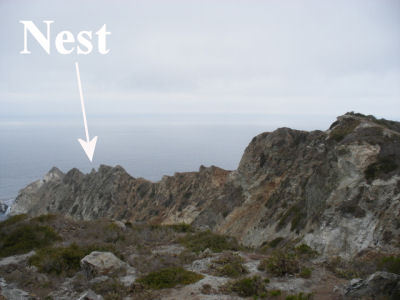
eaglegal's photo - July 6, 2006
Based on past experience, look for eggs in late February and early March, chicks in early April, and fledging from mid-June to early July.
California
Lake Casitas
Ojai
no cam
Note - I am adding this nest because what happened here in 2020 was very unusual - the female was injured in an attempted nest takeover shortly before their eaglet hatched; the intruding female disappeared the day after the hatch - and a young female appeared a few hours later and became a foster mom to the eaglet.
Big thanks to the Lake Casitas Eagles facebook group for the great documentation!
original adults CM1 & CF1 (fall 2010 - spring 2015)
adults CM1 and CF2 (K97/Joy) (spring 2015 - March 2020)
adults CM1/Mr. Majestic (M) and CF3/Hannah (F) (April 2020 -
The original pair was first seen in fall 2010; tried to breed in 2012 but may have been too young; fledged 2 chicks in 2013 (C1 & C2) and 1 in 2014 (C3).
In 2015, a female intruder took over the nest from CF1 and removed the two hatchlings (C4 & C5); the female who became CF2 was K97/Joy, a 2009 eaglet from the IWS West End nest; this was a very bittersweet year as observers mourned the loss of CF1 and her chicks, while those of use who had watched Joy grow on cam were pleased to know she survived and was successfully doing what eagles do.
adults CM1 and CF2 (K97/Joy)
The new pair fledged 2 chicks in 2016, 1 in 2017, 2 in 2018, and 1 in 2019 (C6 - C11)
2020 was another year of change. CF2/K97 and CM1 produced at least 1 egg, but as time for hatching approached, another female tried to take over the nest and was identified as A54, a 2015 eaglet from the IWS Fraser Point nest. The two females were seen fighting on March 23rd and K97 was seen for the last time at the nest on March 24; she was rescued March 30, but her wounds were too serious, and she died on April 5. In the meantime, a second female without tags was seen around 4 pm on March 28; A54 had been at the nest a few hours earlier, and has not been seen since then.
Eaglet C12 hatched on March 27, and we feared the intruding female would kill the chick - but there was a bit of a miracle - on April 2, the young female without tags (estimated to be 4 years old) was seen on the nest while the male fed a chick - and ate some food but did not threaten the chick. They began acting like a bonded pair - and the new female became a foster mother to the eaglet. The observers named the new female Hannah in honor of photographer John Hannah, a member of the observer group who died of cancer on April 2, and named eaglet C12 Bundle of Joy in honor of his/her mother K97/Joy. Within a week or so Hannah was bringing food, feeding and brooding the eaglet, and apparently spending the night on the nest, as females usually do. Bundle fledged successfully, and was still being seen in the area in late August, as was foster mom Hannah.
Hannah and male CM1 (now named Mr Majestic) appeared to have at least one egg in 2021, but there was no indication of a hatch; there are great observers there, but without a cam looking into the nest, we don't know what happened.
California
San Clemente Island
Bald Canyon
adults K76/Tuqan (M) & A32/Chinook(F)
2015 was the first year that chicks were banded here, but the size of the nest suggests it had been used before. K76 is a 2007 chick from Twin Rocks (who visited British Columbia in 2010, before returning to the island)s; he was initially seen on San Clemente in 2014. A32 came from a nest in Alaska as a chick in 2004 and was released from a the North Hacktower; she spent a couple of years (2007-2009) as part of a non-breeding pair in the Thompson Reservoir area now known as Middle Ranch, and was first seen on on San Clemente in 2010. The new pair were seen carrying nesting material in June 2014 - and in 2015, they raised two chicks orange 5/D(M)/Ethan and orange 5/M(F)/Koko.
This nest got a camera for 2016, and viewers were able to watch the pair raise two chicks - but unfortunately the team wasn't able to access the island during the period when the chicks could be banded, and the antennas malfunctioned before fledging, so we can only hope that both chicks fledged safely - and perhaps we'll see some unbanded young adults over the next few years. 2017 was better technically, and we saw both eggs being laid, and saw orange band 01/A (F)/Keena (Irish for brave) and orange band 15/A (M)/Wrigley fledge successfully.
There were two eggs laid in 2018 and both got leg bands - 49/A (M) and 22/A (M); shortly after banding younger chick 22/A fell from the nest; he wasn't injured, and happily the IWS team was able to return him to the nest; a few days later, 49/A appeared to be in distress and having seizures and died on June 9; 22/A was named Julian and fledged successfully. The pair laid two eggs in 2019, and 38/A (F)/Zephyr and 74/A (F)/Te-Waste-Winyan ("Tea") fledged successfully; male K76 was named TuQan in 2019.
The IWS team wasn't able to visit the island in 2020, but a boat survey team determined that there was a new nest and the pair was raising two chicks; they could not be banded, but were named Quinn and Dakota; no info re fledging. The pair laid 2 eggs in 2021, both hatched and were banded as 00/D (M)/ Sharpe and 58/D (M)/Makalo; both were seen on the nest around the time they would be expected to fledge, so it's assumed they fledged successfully.
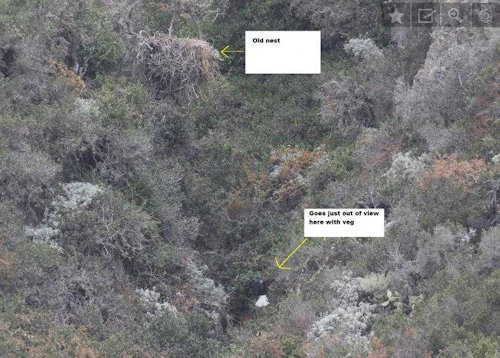
IWS photo - June 2014
California
Santa Cruz Island
Baby's Harbor (aka Lady's Harbor)
no cam
adults A68(M)/Braveheart & A27(F)
I initially had some confusion between this nest/territory and Hazards/Cueva Valdez, but think I now have it sorted out. This is another new nesting pair for 2015. A68/Braveheart is one of the 2010 chicks from Pelican Harbor. A27 came from Alaska as a chick in 2004 and was released from the South Hacktower; she was the female at Sauces Canyon from 2010 though 2012, raising 4 chicks during those years, and lost a territorial battle partway through the 2013 season (we all breathed a sign of relief when she was seen 6 weeks later as she had looked very bedraggled the last time she was seen on camera at Sauces); she was seen spending time with A68 at Baby's Harbor in the spring of 2014, and they nested there in 2015 and successfully raised A56(M)/Phoenix. They have continued to do well, fledging A66(M)/Jim and A99(F)/Corazon in 2016, and fledging A13(M)/Lucky and A14(M)/Andor (name is Norwegian form of "Eagle of Thor") in 2017.
The pair had one egg in 2018 and the chick got leg band 58/A (F) Arleen; the fledge date wasn't noted, but it sounded as if it fledged successfully. They had two eggs in 2019, and raised 43/A (F)/KayKay and 25/A (M)/Bartow (after Rick Bartow). Female A27 was named Meemaw in 2020; they were seen in their territory in late February, but there was no report of whether or not they nested. There were more surveys of the territory in 2021, and the pair was seen but didn't nest.
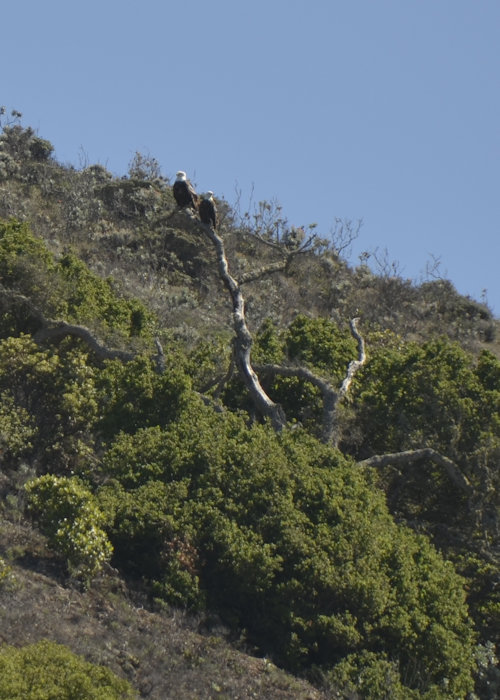
IWS photo - April 9, 2014
California
Santa Cruz Island
Cueva Valdez
/
Hazards / Baby's Harbor / North Shore
no cam
adults A00(M) & A16(F) (pre 2016)
adults A00(M) & A74(F)/Karana (2016)
adult (untagged/banded - maybe A00) and 4th year A98 (F)
Male A00 (produced by the San Francisco Zoo in 2002 and released from the North Hacktower, Santa Cruz) and female A16 (removed from a nest near Juneau, Alaska, in 2003 and released from the South Hacktower, Santa Cruz) have been a pair since 2007 and may have done some work on a nest, but haven't laid any eggs yet. 2010 was a great year for this pair - they laid at least one egg in a nest at Baby's Harbor, and successfully raised male A72. This pair apparently likes to move around because the built a new nest for 2011, moving from the Cueva Valdez/Baby's Harbor area to Hazards Canyon; they laid at least one egg, and A76(F)/Hutash fledged successfully and was still on the island as of mid-August. In 2013 they laid at least one egg, and the eaglet A83(M) was a healthy feisty chick when banded on June 9, but the IWS team noticed that he looked lethargic when they checked the nest July 5; he looked more active on the 6th, so they stayed away on the 7th to reduce stress on the adults - and when they checked on the 8th, he was on the ground under the nest, weak but alive; they brought him to the mainland for treatment, but it wasn't enough; as is often the case, even though they performed a necropsy, they could not determine a cause of death. The pair moved to a new nest for 2013, and while it was challenging for the crew to observe, we do know they laid at least one egg - and successfully fledged A88 (F)/Aira. The pair again laid at least one egg in 2014, and when the crew checked the nest in May, they found an approximately 6-week-old chick on the ground under the nest; it looked healthy and was being fed and defended by the adults, who had brought down some nesting material, and the crew didn't have gear to climb the tree, so after a quick check, they left it there and returned a week later, banded the chick (no wing tags - the chick was too small) and put her back in the nest; Silver Band (F)/'alow (Chumash for 'White Cloud') fledged successfully. The pair laid at least one egg in 2015, but it or they didn't hatch - hoping for better news in 2016.
IWS crew reported in April 2016 that the nest had failed, and said A-00 had paired with a new young female, who was eventually discovered to be A-74 Karana (Pelican Harbor 2011).
2017 was even more confusing; there was a male who was banded but did not have wing tags (and perhaps it's still A00 and he's lost them), and he appeared to be with 2014 female A98 - who might be either Glory from Fraser Point or
Malibu from Pelican Harbor as both accidentally were given the same number; they didn't nest - perhaps she was still too young to lay eggs. 2018 may be interesting....
As far as IWS could determine, the pair did not nest in 2018 - and the female was seen soaring with a golden eagle, who might have disrupted their nesting. Both bald eagles were seen during the February 2018 survey, but on March 4 the team found A98(F) with a golden eagle, and as far as we know, the bald eagle pair didn't nest. They did not use their old nest in 2020 and no new nest was discovered. The IWS survey team could not confirm a pair in the territory in 2021 though they did see at least one golden eagle and a sub-adult bald eagle in the area.
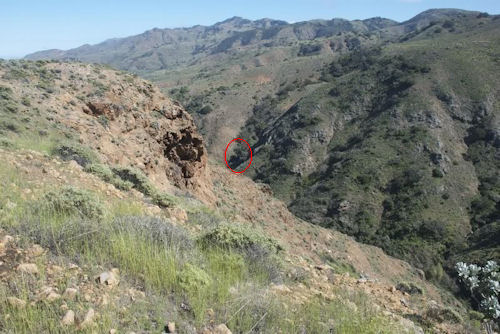
Kim of IWS Crew's photo - March 29, 2011
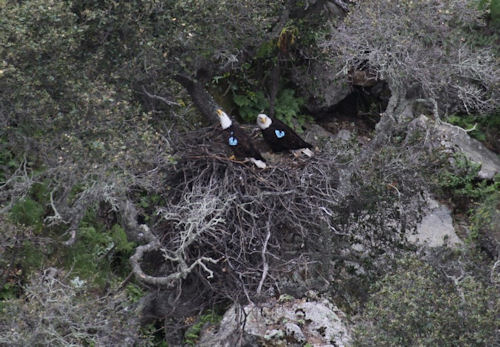
Eagle Guy's photo - April 6, 2011
California
Santa Cruz Island
Fraser Point
no cam
adults A40(M) & possibly A49(F) "Cruz" (2010)
adults A64(M)/Spirit and A49(F)/Cruz (2012 - July 2021)
Male A40 (produced by the San Francisco Zoo in 2005 and released from the South Hacktower on Santa Cruz) and female A24 (removed from a nest near Juneau, Alaska, in 2004 and released from the South Hacktower on Santa Cruz) were seen together in the Fraser area in the spring of 2009, and it was hoped they'd develop into a breeding pair. Then in February 2010, A40 was seen with a different female, A49 "Cruz" (hatched in 2006, becoming the first naturally hatched eagle on Santa Cruz in 50 years).
This is potentially a new pair and it's not clear if they're ready to nest yet - though Cruz's mother A26 was only four when she laid the egg that became Cruz. The pair did not nest in 2010 - perhaps in 2011. Did not nest in 2011, and A40 is now the male at the Sauces nest; A49/Cruz was seen near Christy Beach in August 2011.
There was a new pair here in 2012 - A49/Cruz and A64/Spirit! As mentioned above, A49 hatched at the Pelican Harbor nest in 2006 - and A64 hatched at the Pelican Harbor nest in 2008, so they are siblings - but A64 was removed from the island for rehab after being attacked on the nest by a juvie when he was about 6 weeks old. He was brought back to Santa Cruz and released from a hacking tower, but I do wonder if they would have become a pair if he'd been with his parents throught fledging and the month or so afterwards. I've seen speculation that adults can recognize family members by their calls, but A64 may not have learned the family "lingo" before he was taken to rehab. The pair laid at least one egg, and a chick was seen, but sadly did not survive. It's not unusual for a young pair to have their nest fail initially, so I'm keeping my fingers crossed for better luck in 2013.
2013 was a landmark year - A49 and A64 laid two eggs, one hatched, and A89 (F)/Sapphire fledged successfully, becoming the first offspring of wild-fledged eagles to fledge on the Channel Islands since the species disappeared from the Channel Islands in the 1950s and 60s. The pair laid two eggs in 2014, both hatched, and A98(F)/Glory and A97(M)/Maxiwo ('bald eagle' in Chumash) fledged successfully (as a footnote, the number A98 was accidentally also given to A98(F)/Malibu from Pelican Harbor - who is Glory's aunt!). The pair again laid two eggs in 2015, both hatched, and even though the younger was significantly smaller and behind in development, both A54(F)/Chanita and FWS band 709-03074(F)/Takoda fledged successfully. (The second eaglet was too young or undeveloped for wing tags and IWS doesn't have permission to put colored leg bands on eagles in Ventura or Santa Barbara Counties where the northern Channel Islands are located, so it only got the official FWS leg band.)
Well - IWS installed a cam for 2016 - and the pair was disrupted by a golden eagle in the neighborhood and didn't nest; we saw A49 at the nest regularly, and the golden occasionally, but hadn't seen A64/Spirit since spring 2016 - and I am keeping fingers crossed that he'll pop up here or at another nest, as I saw him hatch, and he's near and dear to my heart.
Good news in 2017 - A64 & A49 have a new nest! They moved to another canyon to get away from the golden eagle - and it looks as if it's working! The IWS crew thought there were 2 or 3 eggs, but didn't want to get close enough to be sure for fear of calling the nest to the attention of the golden eagle - and there were three healthy chicks on banding day - A02(M)/Henry, A03(M)/Theos (Greek for god) and A04(M)/Barrett (in honor of a friend). The pair again laid 3 eggs in 2018, and leg banded eaglets 35/A (F)/Nellie, 44/A (M)/Soar and 52/A (F)/Atsa (not necessarily in hatch order) fledged successfully.
There were again three eggs in 2019, and orange leg banded 55/A (M)/RobertAlan (named for the donor's father), 45/A (M)/Moksha and 34/A (F)/Trey fledged successfully, although there was a bit of excitement when one of the chicks fell off the nest when about a month old but was able to be successfully returned later the same day. They moved to a new nest in 2020 and were seen to be incubating but Covid restrictions meant there was no additional info.
2021 was a busy year. Spirit and Cruz used the same nest as in 2020 and successfully raised two eaglets - 10/D (M)/Saber and 19/D (M)/Gregor; one of the chicks disappeared from the nest around May 29 but could have been on the ground under the nest; the other one fledged June 26. Then some sad news - Dr. Sharpe reported on July 21 that a kayak guide had found A-64/Spirit floating dead in the ocean on the eastern edge of the Fraser Point territory; there was no obvious trauma and they did not recover the body. Rest in Peace, Spirit.
As you may remember, Cruz and Spirit
abandoned the nest with a camera after the 2019 season - and this year it looks as if a new pair is moving in - male A66/Jim hatched at the Baby's Harbor nest in 2016 and female A98/Glory hatched at the original Fraser Point nest (about 2 miles away) in 2014. (Two eagles were accidentally tagged A98 in 2014 - they managed to zoom in on the leg band to confirm that this is Glory.) As of February 27, Jim is around but Glory didn't stay - and Jim was seen on the cam with Cruz! Per the end of season summary, several other females visited Jim, including HP (Sauces Canyon 2018) on March 8 (and maybe once earlier), Cruz on March 23 (when she had eggs at the new nest), and Saucy (Sauces Canyon 2018) on May 11 (Jim wasn't there at the time). No eggs, but an interesting year. (Editorial note - if it turns out that both nests are active going forward, I'll probably move this paragraph into a new entry.)
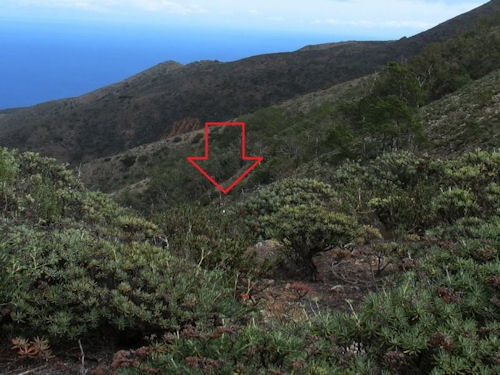
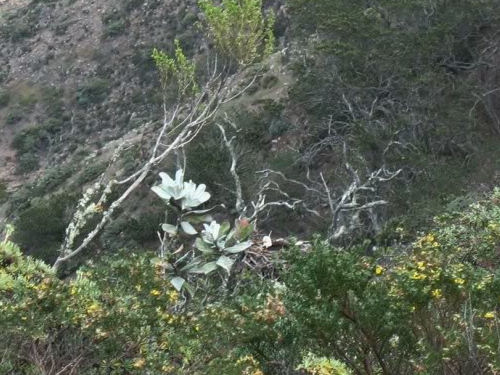
Helen of IWS Crew's photos - February 29, 2012
California
Santa Cruz Island
Fry's Harbor
no cam
adults A46(M) "Stephen Jr." & A24(F) (2010-2014)
adults A46(M) "Stephen Jr." & unbanded female
Male A46 (produced by the San Francisco Zoo in 2006 and released from the North Hacktower on Santa Cruz) and female A24 (removed from a nest near Juneau, Alaska, in 2004 and released from the South Hacktower on Santa Cruz) were seen together in mid-March 2010; A24 was formerly the mate of A40 at Fraser.
This is a new pair and it's not clear if they're ready to nest yet. This pair also did not nest in 2010. Still together in the area at least some of the time in 2011, but didn't nest. The pair finally nested in 2012; only one egg was seen and they were incubating it as time for a hatch approached, but sadly the next time the nest was checked, the egg was gone and there was no chick. This was their first time nesting, and we hope they'll have better luck in 2013. A46 and A24 were seen together in 2013, and worked on a new nest, but did not lay any eggs - maybe next year. At least one adult was seen in the territory in 2014, but they didn't nest. Sad news at the end of 2014 - A24 was found dead on a beach on Santa Cruz in early October; no additional information was provided. Here's hoping A46 finds a new mate and has a good year in 2015.
A46 was seen with an unbanded female in 2015, and they appeared to be incubating, but the nest subsequently failed; it's not an easy area for viewing, so there are no additional details. They produced at least one chick in 2016, but the nest was when checked empty several weeks later. And in 2017 they produced orange band 09/A (M)/Leo! The pair produced at least one egg in 2018 and there was one chick when the team visited the nest but it was considered too old to be safely banded, so no number or name. We don't know how many eggs were laid in 2019, but the pair fledged two eaglets, 36/A (M)/Abraxas (the name of a talking raven in a children's story called "Die kleine Hexe" - The Little Witch) and 48/A (M)/Wayne.
The pair moved to a new nest in 2020, with no trail cam and only one site visit, so we know they had eggs, but not what happened after that. There was at least one egg and at least one chick in 2021, and it's assumed that 56/D (F)/Jem fledged successfully.
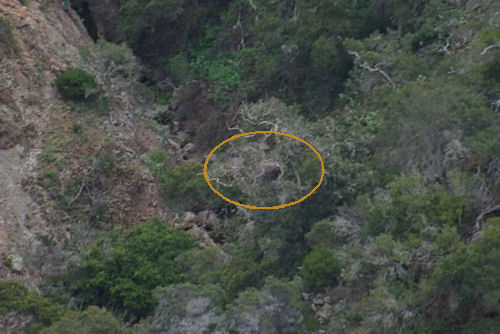
Kim of IWS Crew's photo - early March 2012
California
Santa Cruz Island
Los Piños (aka Willows but didn't nest there)
no cam
adults A45(M) & A51(F) (2009-2014)
adults unknown male (maybe A45) & A51(F)
Male A45 (produced by the San Francisco Zoo in 2005 and released from the North Hacktower, Santa Cruz) and female A51 (produced by the San Francisco Zoo in 2006 and released from the South Hacktower, Santa Cruz) are known as the Willows pair (after the are where they were seen as a non-breeding pair in 2009, 2010 and 2011) - but they moved in 2012, and established what became known as the Los Piños nest. They were seen incubating in late March, but sadly the nest was empty in early April. We wish them better luck in 2013. The pair moved to a new nest in 2013, and laid at least two eggs, though the IWS crew only saw two chicks once (the open countryside around the nest meant they had to observe from quite a distance); A87 (M)/America Strong fledged successfully. The IWS crew believes the same pair nested in 2014, though A45 has lost his wing tags so is harder to identify; they appeared to be incubating for a while, but unfortunately the nest failed.
No one nested here in 2015, and the IWS crew found female A51 at Smuggler's Harbor when they went there to band the chick - but couldn't identify the male, so it could be A45 or it might be A58, who had been the male at Smugglers. It will be interesting to see what happens here in 2016. No new news as of fall 2017. (see below for updated information)
In 2018, the territory previously known as Smugglers Harbor or Cove was renamed as Los Piños because there's now a pair nesting nearer the actual harbor so they're now considered the Smuggler's pair. The adults here are an unknown male who might be A45 and A51(F); A45 was with A51 at Willows (and yes, I'm confused too). This pair fledged A53(F)/Zoe in 2015, A61(M)/Akecheta (fighter in the Sioux language) in 2016 and A05(F)/Tama (name means Thunder - native American origin) in 2017; until the IWS crew realized there were two pairs in the area, they considered those chicks to be from the Smuggler's nest, but corrected that in 2018. The pair successfully raised two chicks in 2018, with leg bands 21/A (F)/Sunny and 54/A (M)/Franklin. The pair laid at least one egg in 2019, and 32/A (F)/Lois Lane fledged successfully. There was no activity observed at the former nest as of February 26, 2020, when surveys stopped for the year. They had at least one chick in 2021, and 53/A (F)/Fay is assumed to have fledged successfully.
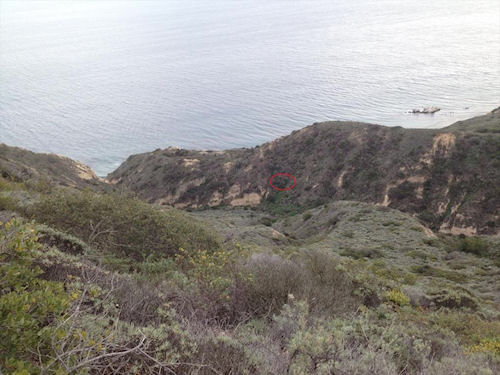
IWS Crew's photo - February 2013
California
Santa Cruz Island
Malva Real / Carl Peak / Grasslands / Carl/Maggie
no cam
adults K11(M) & A04(F) (2006-2008)
adults K11(M) & A17(F) (2009-2010)
adults K11(M) & A35(F) (2011-2016)
adults K11(M)/Xman & A71(F) (2017-2020)
adults K11(M)/Xman & A99(F) (2021-
The Grasslands nest was established in 2006 by male K11 (hatched at the Avian Conservation Center at the San Francisco Zoo in 2001 and fostered into the West End nest on Catalina Island) and female A04 (removed from a nest near Juneau, Alaska, in 2002 and released from the North Hacktower on Santa Cruz Island), and is one of the few known bald eagle ground nests in the lower 48 states. They had a successful first year, raising A60, the second chick hatched in the wild on Santa Cruz in 50 years (A49 Cruz at Pelican Harbor was the first), but have not repeated that success. The crew from the Institute for Wildlife Studies (which monitors nests on Catalina and Santa Cruz Islands) found a broken egg in the nest in 2007, and in 2008 two chicks hatched but did not survive. Female A04 also died, most likely of injuries sustained while defending her chicks, probably from another eagle. K11 was later seen with female A17, who was removed from a nest near Juneau, Alaska, in 2003 and released from the South Hacktower on Santa Cruz. They were seen building a nest in a tree in 2009, but did not produce any eggs. They still seem to be a pair, so we'll see what happens next. This pair did lay two eggs in 2010, but the nest failed - only shards were found in the nest a few weeks later. Female A17 was spotted on the mainland according to an update in March 2011; male K11 may have found a new companion (he's been seen with A35), but as far as we know, they didn't nest in 2011. A35 and a male we assume is K11 (he lost his wing bling) laid two eggs in 2012 - and successfully fledged A77(M)/Koa and A78(F)/Aurora. A pair that's likely to be A35 and K11 built a new nest for 2013 and were seen incubating for at least a month, but the crew never saw any chicks. The pair laid at least one egg in 2014, and A91 (F)/Shania ("on my way") fledged successfully; the location and the male's missing wing tags make it hard to know for sure that it's the same pair, or how many eggs or chicks there were. A35 and a male without wing tags who is probably still K11 had at least one chick hatch in 2015, but the nest failed shortly afterwards; the IWS team was only able to visit every other week, so have no details as to what might have happened. We're hoping for better luck in 2016. No 2016 nest was found.
In 2017 the IWS team reported that A71(M) (Sauces Canyon 2010) might be the new male in the territory; there were no additional reports. The pair laid at least one egg in 2018, but it either broke or didn't hatch. And 2019 was no better - they were incubating well past the due date, so another nest failure.
There was a trail cam set up for 2020, and the eagles here
successfully raised a chick! There were two eggs; one disappeared but the second hatched and the eaglet fledged successfully. But the bigger news is that A71 is indeed one of the adults here - and the blood test was wrong - she is a female (as Dr. Sharpe originally thought), not a large male! So she likely replaced female A35 in late 2016 or early 2017 - and the male here is still K11, who we thought had been replaced by A71 - what a wild ride!
There was a new female at the nest as of January 2021 - A99/Corazon hatched at Baby's Harbor nest in 2016, so she was only 5 years old as the nesting season began. The pair laid two eggs, both hatched, and 4/D (F)/Janntonne and 61/D (M)/Canen both fledged successfully.
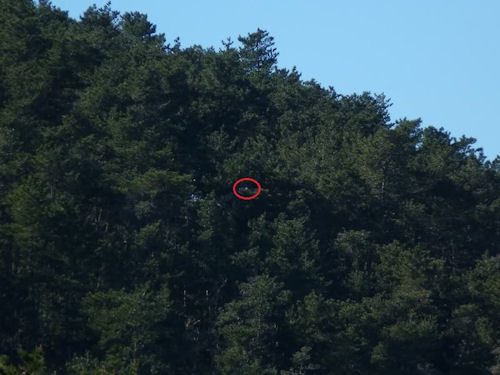
Don of IWS Crew's photo - February 2012
California
Santa Cruz Island
Pelican Harbor
no cam
in 2011
adults K10(M)/Pat & K26(F)/Nakoma
The parents were both hatched in the San Francisco Zoo (male K10 in 2001 and female K26 in 2002) and then fostered into nests on Catalina Island (K10 in the Twin Rocks Nest and K26 in the West End Nest). K26 laid two eggs in 2006 (one hatched, becoming the female A49 "Cruz," the first eagle chick to hatch in the wild on the Channel Islands since 1949; on Santa Rosa as of February 2009); two eggs in 2007 (one hatched, becoming male A63 "Limuw," who died about 7 weeks after fledging while scavenging roadkill in Nevada), and two eggs in 2008 (both hatched, becoming A65 "Skye" and A64 "Spirit" - both male; both were knocked from their nest by a juvenile eagle when they were about 6-1/2 weeks old, taken to the mainland for rehab and released from a hacking tower; Skye drowned after becoming entangled in a kelp bed; Spirit was on Santa Rosa as of February 2009). The pair also had two eggs in 2009; both hatched, but the chicks died shortly after hatching from unknown causes. K10 and K26 are a strong young pair, so we're hoping 2010 will be better. 2010 was indeed a better - the pair laid two eggs, which hatched to become A69 Malik and A68 Braveheart (both male); both fledged successfully. This pair moved to a new nest in 2011 - probably a good thing as their other nest had developed a distinct tilt; they built a nest in the Chinese Harbor area, then abandoned that and built a nest in a hard to reach part of the Twin Harbors area. They'll continue to be known as the Pelican Harbor pair because that was there first nest. They laid at least one egg (it looked like there were might have been two during a helicopter survey of hard-to-see nests but there was only one chick when the team arrived for banding; A74(F)/Karana fledged successfully and was still on the island as of mid-August. We're hoping for a cam on this new nest for 2012. A new cam was installed for 2012, and while one of this pair's two eggs broke after about 4 weeks, we watched the other hatch, and saw male A84/Marcus fledge. The pair apparently moved to a new nest for 2013, or at least were not seen working on any of their known nests; by mid-April they were seen together (so not incubating/brooding), so either they didn't nest or their nest failed. 2014 was better - the pair chose yet another new nest, so no cam, but successfully fledged A92 (M)/Liberty and A98 (F)/Malibu (as a footnote, the number A98 was accidentally also given to A98(F)/Glory from Fraser Point - who is a granddaughter of K10 and K26, and Malibu's niece!). As far as the IWS team could tell, the pair did not nest in 2015. Maybe next year....
They moved to a new location in 2016 and the IWS team reported that there appeared to be an egg or egg, but there were no additional reports. They had one chick on banding day 2017 - A09(F)/Tina (in honor of Tina Ehrenfeld). They had at least one egg in 2018, and the chick received leg band 31/A (M)/Carson. There were two chicks seen in 2019, but only one remained by banding day; 18/A (M)/Makya (Hopi for Eagle Hunter) fledged successfully; female K26 was named Nakoma in 2019, meaning great spirit/great warrior. The pair moved to a new nest in 2020 and we don't have any additional information; the trail cam on their old nest showed that the nest had been partially destroyed, which is likely why they moved. They raised two chicks in 2021; the eaglets weren't banded because the tree was unsafe to climb, but were named, and Dannie and Shasta both fledged successfully.

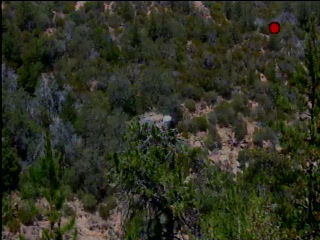
JudyB's s'caps - June 8, 2007 - banding day

LakeMaMa's s'cap - April 23, 2008
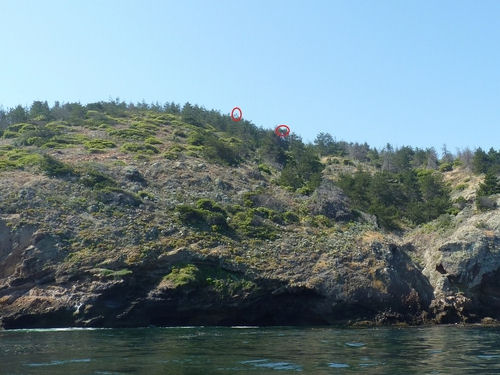
Don of IWS Crew's photo - May 3, 2011
(new nest in circle on right - adult in circle on left)
Based on past experience, look for eggs in the first half of March, chicks in mid-April, and fledging in late June or early July.
California
Santa Cruz Island
Sauces
adults A28(M) & A27(F) thru 2010
adults A40(M) & A27(F) thru Feb 2013
adults A40(M)/Jak & A48(F)/Audacity
The Sauces pair consisted of male A28 (removed from a nest near Juneau, Alaska, in 2004 and released from the South Hacktower on Santa Cruz) and female A02 (produced by the San Francisco Zoo in 2002 and released from the North Hacktower on Santa Cruz). They nested in 2008 and laid at least one egg, but the nest failed. They tried again in 2009, laid eggs, were seen incubating - but were found away from the nest around the time the eggs would have been expected to hatch. Then in July 2009, IWS received a report that A02 was found dead in Pozo, which I think is quite a ways inland on the mainland. It looks as if A28 has paired up with female A27 (also removed from a nest near Juneau, Alaska, in 2004 and released from the South Hacktower on Santa Cruz), and they're working on a nest for the 2010 nesting season. This pair laid two eggs in 2010; only one hatched, and it became male A71, and fledged successfully. There was a bit of a shift in this pair for 2011, and male A28 was replaced by male A40 (produced by San Francisco Zoo in 2005 and released from the South Hacktower on Santa Cruz; spent time with A24 then with A49 at Fraser before coming to Sauces); the new pair laid two eggs, one of which hatched to become A73(M)/Dreamer, who fledged successfully and was still on the island as of mid-August (the second egg didn't hatch). This pair saw both of their eggs hatch for the first time in 2012, and successfully fledged female A82/Phoebe and male A81/Buster.
2013 was a year of painful change at Sauces - A40 and A27 laid two eggs near the end of February, then appeared to be on alert in early March; observers saw A27 on the nest briefly the morning of March 4th, looking bedraggled and possibly injured; she did not return to the nest again. A40 tended the eggs around the clock for a couple of days, then began taking time away from the nest; he was away for several hours the morning of March 7, and ravens came and took the eggs. A49 (the female at Fraser Point) visited the nest briefly, but by mid-March A48 (F) (produced by the San Francisco Zoo in 2006 and released from the North Hacktower on Santa Cruz) was being seen regularly at Sauces Canyon, with A40. Happily the crew saw A27 near Pelican Harbor in late April, so she has recovered from her likely fight with A48. 2014 may be an interesting year here.
2014 was an unlucky year. The new pair laid at least one egg in mid-February and incubated faithfully for about a week, then stopped tending the nest, suggesting that the egg or eggs had been lost; they did try for a second clutch in mid-March, and within minutes after A48 laid the first egg of that clutch, A40 came in with a big stick, which landed on her just after she turned the egg - and in the confusion, the egg apparently broke, and she didn't lay any more. We're hoping they'll do better in 2015. We think the pair laid two eggs in 2015 (the nest was too deep to see, but A48 appeared to be in labor twice at the usual interval), but the nest failed March 15 when it appeared that the egg had broken; Dr. Sharpe said that from what could be seen, it was likely that the egg was either non-viable, or had stopped developing early in the process; we don't know when the other egg disappeared. They do seem very dedicated, and we're hoping for good news in 2016.
2016 was a good year. The first of their three eggs broke a few days after it was laid, but the other two hatched successfully, and A62(M)/Isleno and A63(M)/Whisk fledged successfully.
2017 was not a good year, though it is a testament to how strong and how dedicated to reproducing eagles can be. First egg broke the day after it was laid. Mom A48 wasn't hatched on the islands, but fledged there, and I wonder if she picked up some of the contaminants that made it necessary for eggs from the islands to be removed from the nests and hatched in an incubator during the early years of the eagle restoration project.
Their second egg broke 2 hours after hatching;the third egg
broke in less than 45 minutes.
Dr. Sharpe from IWS said that he thinks there is something wrong with A48's shell production, and noted that
"DDE will eventually decline in the body if they aren't taking in more in their diet" - so I figured we'd keep fingers crossed for next year - but she wasn't done.
Fourth egg laid and broke - she's trying so hard - my heart goes out to her.
Then a fifth egg - the most I've ever heard of in a single clutch - also broke.
First clutch eggs laid Jan 31, Feb 3, Feb 6, Feb 9 and Feb 12.
March 3, less than a month after her fifth egg, A48 began a second clutch; we had hopes, watching the egg remain intact through a switch to Dad A40 then back to Mom - but it was confirmed as broken at 6:08 am, about 16 hours after it was laid (it may have been broken an hour earlier - brief glimpse was inconclusive).
She waited 6 days, and laid another egg on March 9, and then a second on March 12 - and we all hoped so much - and both broke March 14; one looked more collapsed or crumbled than cracked, suggesting at least one had the soft shell we've all suspected.
She's such a strong female - and I'm glad she managed to lay 2 eggs that hatched last year so her strength can be passed on.
2018 was better - she laid three eggs, all hatched, and the chicks with leg bands 19/A (F)/Saucy, 51/A (M)/Corsair and 08/A (F)/HP all fledged successfully. 2019 was a step backwards - she laid three eggs and the first two broke just before the third was laid - but the third produced orange 41/A (F)/Kaiannika (the name is a combination of names of the donor's daughter and granddaughter) who fledged successfully. The pair laid 4 eggs in 2020, and all of them broke, with the fourth one lasting the longest - 3-1/2 days. Slightly better news in 2021 - she laid three eggs and two of them broke - but the third one hatched, and 13/D (F)/Dina fledged successfully.
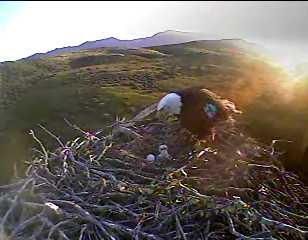
JudyB's photo - April 10, 2011
California
Santa Cruz Island
Smuggler's Cove
no cam
adults A58(M) & maybe A57(F)
A57 & A58 (both hatched at the San Francisco Zoo in 2006 and released from hacktowers) have been seen together since 2013 and we thought 2015 was their first year nesting – but the nest IWS thought was theirs actually belonged to the Los Piños pair (see above). In 2017 the IWS crew discovered an untagged fledgling with a parent whose tags were missing - and they'd tagged the Los Piños chick, so realized there was a second nest in the area; after more research, they found the second nest and realized that A51 (the Los Piños female) had not changed nests or partners and this was a totally different pair, closer to the cove.
The pair fledged at least one chick in 2017 before the nest was discovered. They had at least one egg in 2018, but sadly the nest failed. More bad luck in 2019 - the nest fell from the tree close to the time the eggs should have hatched, so no chicks. There was no activity seen during the survey in February 2020. They had at least one egg in 2021, but the nest had failed by the middle of May.
Note - this picture is probably Los Piños - will find picture of Smuggler's soon.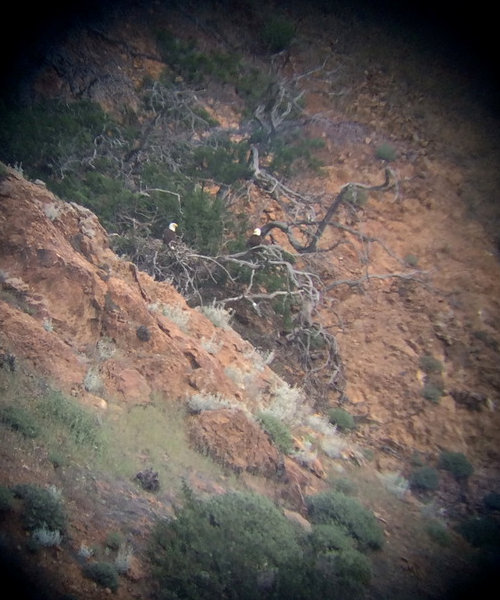
IWS photo - March 2015
California
Santa Cruz Island
Yellowbanks
no cam
adults A21(M) & A11(F) (2008-2010)
adults A21(M) and A48(F) in 2011
(briefly)
adult A48(F) in 2011
Male A21 (removed from a nest near Juneau, Alaska, in 2003 and released from the North Hacktower on Santa Cruz Island) and female A11 (removed from a nest near Juneau, Alaska, in 2002 and released from the North Hacktower on Santa Cruz Island) established a territory on the south shore of Santa Cruz Island in 2008.
They were a non-breeding pair in 2009 and 2010, then moved to Anacapa and became the Oak Canyon pair (see above); A21 was seen with A48 at Yellowbanks before settling on Anacapa with A11.
A48 apparently successfully challenged A27 in March 2013 to become the new female at the Sauces Canyon nest; I'm not sure if there's anyone left in the Yellowbanks territory as of October 2013. No additional news in 2014 or 2015.
California
Santa Rosa Island
East Point
no cam
adults A72(M) & A89(F)/Sapphire (seen 2018 but didn't nest)
adults A66(M) & unknown female (2020)
adults A02/Henry & untagged subadult female (2021)
This is a new territory found in March 2018, and may be the first year nesting for this pair. A72(M) hatched on the Cueva Valdez (aka Baby's) Nest in April 2010; A89/Sapphire (F) hatched on the Fraser Point Nest in April 2013, the first young produced by a pair of wild fledged eagles on the Channel Islands since the species disappeared from the Channel Islands in the 1950s and 60s.
Unfortunately they didn't nest in 2018, and were not seen during the March survey in 2019.
A pair was observed in the territory in February 2020, and the male was identified as A66, who hatched in the Baby's Harbor territory in 2016; there were no further surveys that year so we don't know if they used the nest they were building.
Male
A02/Henry (hatched at the Fraser Point nest in 2017) was seen with an unidentified subadult female in 2021; they visited the nest site from 2020, and I think they may have worked on a different nest, but there were no reports that they actually nested.
California
Santa Rosa Island
Lopez
no cam
adults K36(M) & A43(F)
adults A39(M) and A43(F) 2011- 2014
adults A69(M)/Malik and A43(F) (2015 -
The nest built by male K36 (produced by the San Francisco Zoo in 2003 and fostered into the Two Harbors nest on Catalina) and female A43 (produced by the San Francisco Zoo in 2005 and released from the North Hacktower on Santa Cruz) in the Johnson's Lee area of Santa Rosa Island was discovered by an IWS team in March 2010, and the National Parks Service team on the island reported they appeared to be incubating as of early April. We don't know how many eggs they laid, but one hatched, and was reported as the first known eagle chick to hatch on Santa Rosa in 60 years (but see Trap Canyon below); the chick became female A70, and fledged successfully. Male K36 was replaced by K39 for the 2011 nesting season. This nest was one of the heartbreakers in 2011 - they laid two eggs, one hatched, and then a branch broke, causing the nest to fall to the canyon below; the two-week-old chick died in the fall. We're hoping they rebuild in a safer location in 2012. The pair rebuilt their nest for 2013, and hatched two chicks; one died at 2-3 weeks of age (the remains were found under the nest at banding, so it might have been blown out, or pushed out during sibling rivalry), and female A-79/Kaya-B fledged successfully. K39 and A43 again laid two eggs in 2013, and successfully fledged A85 (F)/La'i and A86 (M)/Azul; sadly A86 was found dead near a beach on the mainland about a month after he fledged. 2014 was a year with a happy surprise - the IWS crew had been able to see a chick in the nest from their distant viewing point, and happily still saw a chick after part of the nest collapsed after heavy rain in early April - but when the arrived to band the chick, they found a second healthy chick on the ground near the base of the tree, doing fine, against all odds; A93(M)/Davy and A94(M)/Connie fledged successfully (the grounded chick A93 was returned to the nest after banding).
The IWS crew had a different sort of surprise on banding day in 2015 - male A39 had been replaced by A69/Malik, who hatched in 2010 at Pelican Harbor and had been seen on San Miguel Island in 2012. The new pair had at least one egg, and observers thought they saw two chicks, but there was only one there on banding day, and A50(M)/Nimoy fledged successfully. (As an aside - I just realized that A69/Malik and his younger brother A68/Braveheart were both successful first-time dads this year as 5-year-olds - perhaps taking after their parents who first nested successfully in 2006 when male K10 was five and female K26 was only four.)
A69 and A43 had one chick at banding day 2016 - A65(F) fledged successfully. The 2017 female did not have wing tags, but may still be A43; the nest the pair used in 2016 had collapsed, but the team finally found their new nest, and A07(F)/Eva (name means full of life or mother of life) was banded successfully; the team didn't see her after she fledged, but the female's behavior when they were in the territory suggested she was guarding a fledgling. Two chicks received leg bands in 2018, orange band 05/A (M)/Pekelo and 29/A (gender not reported)/Phoenix. There was at least one egg in 2019, but the nest subsequently failed. The pair laid two eggs in 2020; both hatched, but sadly one chick died when about a month old and the other, not banded but named Justice, died at about two months, both from unknown causes. The pair laid three eggs in 2021 and two hatched; sadly one died when about a month old (one looked much bigger on a trail cam picture a few days earlier, so I'm guessing it's the younger that died); the remaining chick was banded as orange 17/A (M)/Maestro and fledged successfully.

California
Santa Rosa Island
Sandy Point
Mud Tank
no cam
adults A60(M)/Maxiwo & ?
New pair found nesting on the ground in 2020; one has wing tags, but not identified as of 2/12/20; the male might have hatched from Grasslands/Malva Real nest in 2006 - which was a ground nest (my records show the 2006 chick was A60). The territory had originally been known as Sandy Point and was renamed as Mud Tank in 2020 to avoid potential confusion with the Sandy Point Peregrine Falcon territory. The park service reported there was an eaglet on the nest in 2020, but there's no additional information. The male was confirmed to be A60 in 2021; he was also named Maxiwo (side note - A60 was the second natural hatch on Santa Cruz Island since 1949; A49/Cruz was the first); the pair laid at least two eggs and produced two chicks, which were banded as 17/D (F)/Perse and 20/A (M)/DJ; there were no followup visits so no information about fledging.
California
Santa Rosa Island
Trap Canyon
no cam
adults A08(M) & A22(F)
Male A08 (removed from a nest near Juneau, Alaska, in 2002 and released from the South Hacktower on Santa Cruz) and female A22 (produced by the San Francisco Zoo in 2004 and released from the North Hacktower on Santa Cruz) built a nest on Santa Rosa in 2008, but their eggs didn't hatch; they were collected and found to be infertile. They laid an egg again in 2009, and again it didn't hatch. [It was removed for testing - need to look for results.] We're hoping for better luck in 2010. 2010 was a great year for this pair - they built a new nest, and by the time the nest was found, they had a chick - who became male A67 and was actually the first known chick to hatch on Santa Rosa - once he was discovered; he fledged successfully. This pair laid at least one egg in 2011, but the nest was found to be empty a month later; hopefully they will have better luck in 2012. The pair moved to a different, equally inaccessible nest for 2012 and again raised one chick, who became female A80/Rosa and fledged successfully. In 2013 the pair moved back to a site near the 2010 nest, with no place for the crew to see it well without frightening the birds off the nest; they were able to see a chick, but sadly the nest was empty a month later, except for downy feathers that were all that remained of the chick or chicks. 2014 was better - A95(F)/Ynez and A96(M)/Kanoa fledged successfully. The pair laid at least one egg in 2015 and were seen to be incubating, but either the egg(s) didn't hatch or they lost the chick(s) shortly afterwards. Keeping fingers crossed for 2016.
2016 was a good year here - two chicks hatched, and band orange A??(M) and band orange A00(F) fledged successfully (they were too small for wing tags on banding day so got colored bands, and one of the banding team remembered the female chick's number, but they couldn't remember the male's and I haven't seen any official report). The pair laid at least one egg in 2017, but the nest subsequently failed. There was at least one egg in 2017, but when the team visited in April, they found the nest had fallen from the tree; they did not see any sign of chicks in the debris. There was at least one egg in 2019, and 28/A (M)/Elos (named by grandson of donor for Eagle Lord of the Sky) fledged successfully. The pair used a new nest for 2020; an initial report said there were two chicks but only one was mentioned in the end of the year summary, and the unbanded eaglet named Erin likely fledged successfully as they were spotted more than three months after hatching.

Don of IWS Crew's photos - May 16, 2012
(used with permission - click to read the rest of the story)
California
Humboldt Bay
adults Mr. and Mrs. HBE
The Humboldt Bay eagles, known only as Mr. and Mrs. HBE, are approximately 12 years old have been nesting together since 2006. They have successfully raised at least six eaglets. Their nest is about 95-100 feet up in a Douglas Fir, and they've been using it for about 4 years. 2013 was their first year on cam, and they laid two eggs and successfully fledged Kyle (F) and Stormy (F). They again laid two eggs in 2014, and E1(M)/Angel and E2(F)/Mist both fledged successfully, though both chicks were discovered at banding to have what was described as a mild case of avian pox; they were seen on the nest for at least 6 more weeks, and in the area for a bit after that, and seemed to be doing well. The pair laid two eggs in 2015, and Hoolet(F) and Nugget(M) fledged successfully.
The pair had a new nest out of cam range in 2016; there was talk of a cam for 2017, but the new nest was out of range.

cococat9's s'cap - April 25, 2013
California
Turtle Bay
CalTrans
adults Patriot (M) and Liberty (F) thru early 2013
adults Spirit (M) and Liberty (F) thru January 2019
adults Guardian (M) and Liberty (F) (2020 -
The California Department of Transportation tried to relocate this nest in 2008 because of major highway construction planned for the area, putting a large cone in the nest to keep the eagles from nesting. The eagles had other ideas. People rallied around, and eventually the highway department removed the cone, and the eagle couple - named Patriot (M) and Liberty(F) - successfully fledged two eaglets (named Freedom and Conehead) in 2008, for a total of five eaglets in three years. They laid three eggs in 2009; all hatched, and the three eaglets (named Freedom, Hope and Spirit in a contest sponsored by local media) fledged successfully. They laid three eggs again in 2010, and the eaglets (Peace, Shasta and Justice) fledged successfully. They laid two eggs in 2011, and the eaglets (nicknamed Stormy and Windy) fledged successfully. Patriot and Liberty built a new nest for 2012, so there was no camera, but the great team of ground observers reported that there were two eaglets (nicknamed Shasta and Lassen), both of whom fledged successfully.
2013 was not a good year at Turtle Bay. Patriot and Liberty laid three eggs, one of which collapsed or disappeared within a few weeks. The remaining eggs were left uncovered for hours at a time as the resident pair dealt with an intruder. After a very stressful week, Liberty resumed incubation - but we didn't see Patriot stopping by to take over so she could have a break. To add to the difficulty in viewing, the cam was locked in a position that only showed the eggs and the feet and lower body of the adults - not a great way to tell who is who. Amazingly, both remaining eggs hatched. And sadly both tiny chicks were killed and eaten by a new male who was trying to take over the nest. Because he appeared young, and because he had only shared in the care of the eggs for about a half hour before the second one hatched, he almost certainly didn't have the nesting hormones in place - but it was incredibly hard to watch. And that wasn't the end of the bad news. A couple of months later, Patriot returned, and died while fighting with another eagle near the nest.
As of October 2013, Liberty has chosen a new mate, named Spirit by observers of the cam and others who care about the eagles, and we are hoping for a much better year in 2014. Liberty and her new mate Spirit laid three eggs in 2014, but sadly all three broke within a month or so of being laid; creating fertile eggs takes a bit of skill, and Spirit has been working on that - so I'm hoping for chicks in 2015.
2015 was a great year - they laid three eggs, all three hatched, Spirit was perhaps surprised - but quickly adapted and became a great Dad, and Pi, Paddy and Poppy all fledged successfully!
Well, the Friends of the Redding Eagles had a wildly successful fund drive and raised money to install two high def cams with sound for 2016 - but Liberty and Spirit had other ideas, and built a new nest at a nearby golf course; there was no publicly accessible viewing spot, though the golf course did work with local observers to allow occasional access and also reported activity at the nest - and Birdie and Bogey fledged successfully.
2017 was another year of changes. The adults returned to the golf course, worked on their nest, and we think laid at least one egg - and then the nest came down February 11 as a result of a series of bad storms; one of the people at the golf course thought he saw pieces of egg shell amid the debris, and Liberty does usually lay her eggs in the first part of February. They appeared to check out an old hawk's nest - then in February 17 eaglewoman confirmed they were near the Turtle Bay nest - and that's where they laid what we think is a second clutch in early March. Unfortunately, there were a lot of issues with cameras (including the electrical equipment at the base of the tree being submerged - and replaced - twice when heavy rain necessitated releases from an upstream dam) and they were not on consistently until May 1, but our intrepid observers reported that they appeared to be incubating on March 10, and appeared to have a chick on April 18 (the cams showed two eggs but the other didn't hatch); the chick was named Solo about a week after the cams came back. We had hoped that the rest of the nesting season would go smoothly, but that was not to be. There were record high temperatures for at least a week starting in mid-June (when chicks who hatched in the first part of February would be fledging, and able to follow the parents to the cooler spots by the river), and it proved too much for Solo; he lost his footing while branching on June 24, and was found and rescued the next morning, but died shortly afterwards; he was seriously underweight and almost certainly very dehydrated. There was a necropsy, and no diseases or toxins were found, which was good news for the adults and the chicks we hope they have in 2018. Spirit and Liberty built a new nest at the golf course for 2018 and sucessfully fledged two eaglets, River and Sky.
As of February 17, 2019, there had already been a lot of activity; Liberty & Spirit chose an old hawk nest at the Riverview golf course for their new nest, and fixed it up nicely - but then Spirit disappeared; the last confirmed sighting was January 26, with Liberty on what local observers call the Christmas Tree; by February 11, Liberty was being seen consistently with either an older subadult or young adult (not quite sure where the dividing line is) and they were mating and acting like a pair; then on February 12, their new nest came down in a record-breaking snowstorm; it landed upside down, so we don't know if there was an egg or eggs yet, but observers thought Liberty looked ready. They were subsequently seen near their former nest at Turtle Bay but did not nest again. Liberty's new mate was named Guardian.
In 2020, Liberty and new mate Guardian nested in the original nest Liberty and Patriot had built in 2011; the cams were no longer functioning, but ground observers reported seeing two eaglets (the younger one sadly was only seen once), and the eaglet named Hope fledged successfully and was seen in the area with the adults for about a month after fledging.
A new camera was installed at the Turtle Bay nest for the 2021 nesting season (big thanks to Terri/Eaglewoman and the Friends of the Redding Eagles!) - and happily the eagles chose to use that nest! They laid three eggs and all hatched, and were named Honor, Glory and Rebel by a poll of viewers. All three fledged successfully, if a bit non-traditionally. It was very hot in late May/early June as the eaglets turned 10 weeks old, frequently going above 100F/38C. Oldest eaglet Honor (who had never branched) had a very intentional fledge on June 3rd (74 days old). The following day, youngest eaglet Rebel left the nest as well, possibly slipping while trying to branch (the angle of the cam made it hard to be sure); Rebel was 72 days old. Happily local observers found both of them on the ground with an adult perched above; they landed near the river, and were able to have a drink of water. Middle eaglet Glory apparently liked having the nest all to his/her self, staying there another two weeks before fledging on June 18 (88 days old). All three fledglings were seen together perched beside the river on June 22, and all were seen through July 5 (at least two a couple of weeks longer). A happy year in spite of the challenges of the very hot weather.
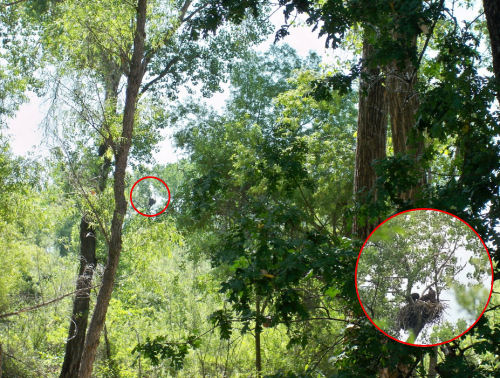
Three Eaglets at the Nest, June 3, 2009
©2009 Donna Sylvester, used with permission, all rights reserved
Based on past experience, look for eggs in early to mid February, hatching in mid March, and fledgling in mid to late June.
Colorado
Fort St. Vrain
as of 2019, male has one band on left leg, female has two bands
male with band on right leg, female with bands on both legs (2021-
There are four cams on this nest, two overhead and the other two looking from the side; the intent is to have one of each online, with the other as backup, but both overhead cams failed early in the nesting season; they streamed both side view cams for a while, but are now down to one sideview cam. They are continuing to try to add sound, but still haven't succeeded at that. The cam is solar-powered, so will be shut down from dusk to dawn to conserve power and might be a bit uncertain on very dark days. There are also photos for the day saved in four-minute increments, so you can see what has happened in the previous 24 hours. The cam is often offline during the fall and winter, and is back online in February.
This nest is at Xcel Energy's Fort St. Vrain Power Station in Platteville, Colorado. Local time is Mountain time. The nest is 6 feet wide and 5 feet deep, and has been active for years. The camera was installed in 2003. This pair successfully raised 3 chicks in 2008, 2 in 2007, 3 in 2006, and 2 in most of the previous years that they've been watched. The nest failed quite tragically in 2009, when their three eggs hatched in late March, but all three chicks died April 17; apparently one of the parents was lost or incapacitated around April 14, and the remaining parent wasn't able to keep the eaglets warm and fed during a bad wind/rain/snow storm; a second adult was seen shortly thereafter, leading to speculation that one of the adults might have eaten a poisoned prairie dog and been unable to function for a few days. It appeared that there was a new female in 2010, possibly a relatively young adult as it looked as if there were a few brown feathers remaining in her head; the male appeared to be the same as last year, though it is hard to tell. Both eagles are banded, but the cam resolution isn't great enough to see numbers on the bands. The pair laid two eggs in 2010, and both chicks fledged successfully. They laid three eggs in 2011, two of which hatched, and both eaglets fledged successfully. 2012 was a very sad year at this nest - they laid three eggs, and all hatched - but one chick got stuck near the edge of the nest when it was 6 days old and died from exposure; the male did arrive during the night to brood the chick while the female brooded the other two at the center of the nest, but it was probably already too late. The remaining chicks died when they were a little over 2 weeks old when the adults were unable to keep them warm and dry during a severe wind/rain storm. We're hoping for a much better year in 2013.
Well, things were slightly better in 2013 - the adults again laid three eggs, and they all hatched. Sadly two of the chicks were lost in mid-April as a result of a large snowstorm, which deposited over a foot of snow on the nest when the chicks were only about two weeks old. The remaining eaglet was renamed "Survivor" by those watching the cam, and fledged successfully. As of November 2013 we're not sure if there will be a cam next year - the nest tree is near the banks of the St. Vrain Creek and is in the area that was flooded in the historic flooding in Colorado from September 10 to September 13. The nest tree is still standing, the nest looks OK and both adults have been seen - but the camera equipment and the solar panels were covered with 5 to 7 feet of water. The weather was still an issue in 2014, but not as severe as the previous year; the pair laid three eggs, all of which hatched; the middle chick ("Argos") died when he/she was a little over a month old, after a week or so of wheezing and difficulty breathing; the other chicks ("Amara" and "Ajax") fledged successfully, though the younger Ajax was observed wheezing occasionally.
2015 was another challenging year here. The pair laid three eggs, and all three hatched, but the youngest D30 died at four days old after ending up outside the nest bowl, perhaps injured or maybe just stuck as the temperature fell, and then there was a bad storm when the remaining chicks were about 3 weeks old, and they didn't both fit under Mom and the one who was more exposed didn't make it (we think the younger, but can't be sure); the remaining chick (nicknamed "Aspen") fledged successfully.
More sad news in 2016 -
the pair laid three eggs and all hatched, but the nest area had a bad storm with cold heavy rain the night of April 15-16, and though both adults tried to shelter the 16 and 19 day old chicks, they could not keep them dry, and all three died. Rest in peace, little ones.
2017 was better - they again laid three eggs, two of them hatched - and those chicks fledged successfully! The pair laid three eggs in 2018, and FSV36, FSV37 and FSV38 fledged successfully. There were three eggs again in 2019, two hatched, and FSV39 and FSV40 fledged successfully. Xcel stopped streaming the cams early in 2020 to conserve bandwidth for essential functions, but provided reports so we know there were three eggs, two of which hatched; one chick was lost in a spring snowstorm (probably younger FSV42), but it was reported that FSV41 fledged successfully.
The cams were back for 2021 and observers noticed the male had a band on the right leg while the previous male's band was on the left leg, so there was a switch at some point; the pair laid three eggs but one broke when a chunk of ice fell on it from a branch overhead; the other two hatched, but older FSV43 died of unknown causes after a day and a half; FSV44 fledged successfully and was captured after fledging, banded, and equipped with a tracking tag; they determined that he was male.

tomihawk's photo - July 20, 2007 - from BirdCam Forum
Based on past experience, look for eggs in the first half of March, chicks in mid-April, and fledging in early July.
Colorado
Standley Lake
Dad and Mom (thru 4/6/20)
Dad and F420 (4/22/20 - )
This pair has been nesting in the Standley Lake Regional Park in Westminster, Colorado, since 1993, and have produced 2 eaglets each year since 1996 - and three in 2015. The adults built a new nest in a tree near their original nest after the 2016 nesting season, and the camera system was installed in the fall of 2016 between the two trees; it's a solar-powered system, so there is no night view.
2017 was a great year to begin watching this pair - they had three eggs, all three hatched - and while the cam had issues so we couldn't see the actual first flights, all three fledged successfully. There were three eggs in 2018; one hatched, and 1-18/"Scout" fledged successfully. The cam was offline during the 2019 nesting season; local observers reported that one chick fledged.
2020 was a challenging year - a female intruder began attacking the nest on the afternoon of April 6 (day 36 for the first egg); an adult with injuries was seen on the morning of April 7 but it's not clear if it was the resident female or the intruder; as of April 12 the resident female has not been seen or found and the male is incubating the eggs by himself and defending the nest as best he can from the "floater" (a more polite name for a nestless eagle who is trying to find a nest and mate); one egg hatched and the male brought food to the nest and ate some (too soon to feed the chick) - and the floater female came in and claimed the rest of it; sadly but not unexpectedly, the chick died on two days after hatching, probably in its sleep from a combination of cold and lack of food; rest in peace, little one. Dad stopped incubating the remaining eggs shortly after the chick died, and he and the new female began to become comfortable with each other; they mated on April 22 and then did some work on the nest, beginning to develop a pair bond; park staff are calling the new female F420 because she arrived in April 2020.
2021 was another sad year; the new pair had two eggs and at least one hatched (some observers thought they had briefly seen a second chick); and then the nest tree fell down when the chick was about 5
weeks old, and sadly SL1 did not survive.

posted by golden1 on Hancock Wildlife forum
Eggs are usually laid in the first two weeks of February; eaglets hatch in March and fledge by mid June.
Dist of Columbia
Nat'l Arboretum
Washington
adults Mr President (M) & The First Lady (F) (2014 - Feb 2021)
adults Mr President (M) & Lotus (Lady of the US) (F) (May 2021 - )
an American Eagle Foundation nest
In 2014, this pair Bald Eagles chose a tulip poplar tree for their nest in the Azalea section overlooking the Anacostia River high above Mount Hamilton at the U.S. National Arboretum in Washington, DC. The beautiful National Arboretum is operated by the United States Department of Agriculture. This is the first Bald Eagle pair to nest in this there since 1947. They fledged one eaglet in 2015 after which the American Eagle Foundation went together with the National Arboretum to install 2 HD cams near the top of the nest tree. The cams are totally powered by a solar array. This solar array was built by Alfred State College, SUNY College of Technology and was partially funded by the Department of Energy and Environment.
The pair laid 2 eggs in 2016, and successfully fledged D2/Freedom and D3/Liberty. They again had two eggs in 2017; the chicks were named DC4/Honor and DC5/Glory - and Glory provided some excitement when he or she fledged prematurely and took 5 days to make his/her way back up to the nest - and then fledged for real two days later, followed by Honor a few days later. There were two eggs in 2018 and both hatched; DC6/Victory had an accidental fledge but was able to return to the nest and began flying for real about a week later; DC7/Valor wasn't as lucky - he slipped from a branch during the night and was seen flying near the ground but didn't return to the nest and was found on the ground a few days later and taken for an exam which showed he was severely underweight and anemic, and he tested positive for West Nile virus; he did not respond to treatment, and was humanely euthanized on August 7. Rest in peace, young one.
2019 was an unusual year; I didn't see any reports of major disruptions, and the pair worked on their nest and mated as usual, but they never laid any eggs. There were no eggs again 2020 either; there were other eagles around which may have been a factor. No eggs again in 2021, and I believe that the last sighting of The First Lady was February 14; as of May 2021, it appeared that female TFL had been replaced by a younger female who still has some dark feathers on her head; she was initially called V5 (Visitor 5?), and on December 26, 2021, she was given the name Lotus (for Lady of the United States).

© 2016 American Eagle Foundation, EAGLES.ORG
Look for eggs in February, chicks in March, fledging in June-July.
Dist of Columbia
Police Academy
Washington
no cam since 2020
adults Justice (M) & Liberty (F)
sponsored by Earth Conservation Corps and
MPDC
2016 is first year on cam for this pair; they have been nesting at the Metropolitan Police Academy in the southeastern part of Washington DC since 2005. They had two eggs in 2016, and the chicks named Mary and Jimbo fledged successfully. They also laid two eggs in 2017, one hatched, and Spirit fledged successfully. The pair again laid two eggs in 2018, and ECC3/Honor and ECC4/Courage fledged successfully.
2019 was a confusing year. Justice disappeared February 9, just before Liberty laid her two eggs; there were several suitors, and the eggs were left alone a lot - then on February 27 Justice returned and chased off the current suitor; a raccoon eventually ate the non-viable eggs. As of April 27, Justice hadn't been seen since April 10, and there's a new male being called M6 who is around a lot courting Liberty. I didn't follow the nest and haven't found a lot more details; as of November 2019 the cam was down and the cam operators reported that they were working on it and there were two eagles in the area they thought were Liberty and Justice.
There were cam issues in 2020, and it sounds from reports on Facebook that Liberty did not use the nest at the Police Academy. I did not find any reports for 2021 and there is no cam for 2022.

Thanks to the Earth Conservation Corps and Anacostia Raptor Watch
for providing this different perspective on the nest - 11/30/17
Look for eggs in February, chicks in March, fledging in June-July.
Florida
Captiva
Sanibel Island
adults Joe (M) and Connie (F) (through January 2021)
adults Martin (M) and Connie (F) (March 2021-
an American Eagle Foundation private partnership cam
The current owners bought the property in 2017 and were told that eagles had been using the nest for about 8 years, since 2009 (there had been osprey there previously); they had 2 eaglets in 2018, 2019 and 2020; only one fledged in 2019, but both were successful the other two years.
I believe 2021 was the first year with a cam, and it turned out to be a sad, sad year. The pair laid two eggs; both hatched on December 14, 2020, and the chicks were named Hope and Peace; younger eaglet Peace died on January 14 after becoming less active for a few days (both eaglets had been checked December 28 when one of them was tangled in fishing line and were fine then); older eaglet Hope seemed to be doing well, but then tremors were noticed in her legs, and then blood was seen as had happened with Peace, and she died January 24. The bleeding suggested that the cause of death was rat poison, and a permit was obtained to recover Hope's body for a necropsy - and that confirmed that it was rat poison, and also noted that Hope was a young female; rest in peace, little eagles.
Male Joe disappeared shortly after the eaglets died, and a new young male was seen in the area, and was named Martin
by the cam owner in mid-March 2021.
This is an early nest, so the 2022 nesting season started in the fall of 2021, and young male Martin was defeated in a territorial fight in October; the new male was accepted by Connie, and named Clive by the landowner in mid-November, 2021. The pair laid two eggs but neither hatched, which is not unusual for a new pair. We're hoping for a better year in 2023.
Eagle Country
adults Nicholas (M) and Victoria (F) (through spring 2020)
2019 was the first year I discovered this cam; the pair laid two eggs and Dandy (short for Dandelion) and Spur (short for Sandspur) both fledged successfully. The pair was successful again in 2020 and eaglets EC3/Hickory and EC4/Mossy fledted successfully; the eaglets were named by the cam sponsor for the hickory trees and spanish moss that are abundant in the area.
Observers think that Nicholas and Victoria did not return in the fall of 2020, and as of early January 2021, there appeared to be a new resident pair - but then there was one female being seen, and several males, and that continued for a couple of months; the cam hosts turned the cam off at the end of March - and noted on Facebook that there was still not a bonded pair as of September 2021, and that the cam would stay off until it looked as if someone was actually nesting.
Northeast Florida
adults Romeo (M) and Juliet (F) through spring 2018
adults Samson (M) and Gabrielle (F)
Gretchen Butler, a volunteer with the Florida Audubon "Eagle Watch" program and the American Eagle Foundation "Eagle Nest Cam" program, has watched these eagles for the past five years, and was the driving force behind the installation of a cam in October 2013, in partnership with the American Eagle Foundation. The nest is 80 feet up in a tall pine tree, the location of which must be kept confidential as a requirement for installation of the cams. The pair has fledged 9 eaglets in the past five years - and we're looking forward to their first year on cam! They have great cams here - and 2014 was a great year; the pair laid two eggs, and NE1/Delilah and NE2/Samson fledged successfully. 2015 was also a good year - they laid two eggs and NE3/Noel and NE4/Nick fledged successfully. Two eggs again in 2016, both hatched, and NE5/Liberty and NE6/Justice fledged successfully.
There were two eggs again in 2017, both hatched, and NE16/Peace (M) and NE17/Hope (F?) were both doing well initially - until February 6, when 7-week-old Peace was observed to be entangled in monofilament; he was rescued four days laterand subsequently sent to the Audubon Center for Birds of Prey in Maitland, Florida, for further observation, treatment, and rehabilitation. He recovered well, gained strength, and was released near the nest tree on March 14; we hoped he'd return to the nest - but that didn't happen; perhaps he'd gotten used to life on his own. Hope also did something a bit unusual - she fledged March 2nd (at 10 weeks, 2 days - one of the earliest fledges I've seen), and spent time coming and going to the nest, and was last seen there March 10 (some chicks spend more than a week being fed at the nest - but others start hanging out with the adults then and exploring, especially when there isn't a sibling still being fed in the nest) - except - Juliet (who had been away from the nest since March 20) came in with a fish on April 7 - with Hope hot on her heels (errr, wings)! Hope looked great, and it was wonderful to see that she was doing so well as a fledgling! Two eggs in 2018, and NE18/Sky and NE19/Spirit both fledged successfully.
2019 was a tough year. Beginning around December 11, there were indications that there might be intruders in the area, and on December 13, Juliet was observed to have some injuries to her face, likely from a territorial fight. Things seemed to return to normal and she was healing well, though they seemed to be alert - and then Juliet disappeared; she was last seen on December 17. Romeo was amazing, incubating the eggs around the clock, with only brief breaks for food and to stretch his wings. Other females came by (one even tried incubating briefly), but his focus was on the eggs. They were left uncovered more than usual so we knew they might not hatch, and the first one didn't - but the second one began to hatch, with a pip confirmed the morning of December 24, at the outer end of the normal hatch window. I know we shouldn't assign human emotions to eagles, but it felt to me like a frustrating time for Romeo - as the pip got larger and the chick continued the hatch process, he brought food to the nest several times in preparation for the hatch (as males frequently do) - and each time, it was taken by the female who was spending time near the nest; she was in courtship mode and saw it as a food offering - which males frequently provide when a new pair is forming (or as part of the pre-nesting process, to show he'll be a good provider). By about 5 pm on December 25, the chick was almost out of the shell; the male had been gone for a while (likely looking for more food - from what I've seen, males are hard-wired to give priority to providing food for chicks because the female usually does more of the incubation) - and the female came to the nest and likely saw the new chick as another food offering, and killed it and flew off with it. Romeo spent the night on the nest, incubating the remaining egg. The next day, he was in and out of the nest quite a bit, looking tired when he returned and incubated for a while before flying off; and the last time, he didn't come back; he was last seen around 2:30 pm on December 26.
Several eagles (males and females) were seen at the nest after that, and an interesting twist here - one of the eagles showing an interest in this nest has been identified by long-time observers as Samson, one of Romeo & Juliet's chicks from 2013; one of the adults stepped on one of Samson's toes when he was a chick - and the same toe on this adult seems flattened a bit, as did the toe of the chick after the incident (it works fine - just looks a bit odd).
As of April 27, Samson and a female seemed to be bonding, and the female was named Gabrielle in the fall of 2019. We wish them good luck in 2020.
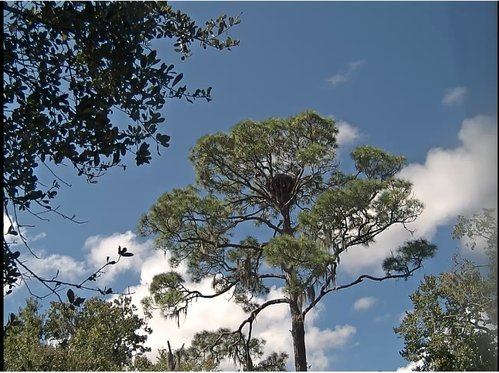
MaryF's screenshot - October 10, 2013
image courtesy of the American Eagle Foundation
Based past experience for this pair, look for eggs in November, chicks between mid-December and early January, and fledging in late February to mid-March.
Southwest Florida
adults Ozzie (M) and Harriet (F) through 2015
adults M15 (M) & Harriet (F)
This nest is in Fort Myers, Florida, on the property of Dick Pritchett Real Estate, which installed and operates the cams. The nest is about 60 feet above the ground, in a Slash Pine tree, and the eagles have been nesting there since building the nest in 2006-2007. 2013 was their first year on camera, and they laid two eggs, and eaglets E1/Hope and E/2Honor fledged successfully. 2014 was a challenging year - the pair again laid two eggs and both hatched, but there was serious rivalry when they chicks were 3-4 weeks old, and we feared we might lose the younger one; by 5 weeks old the rivalry had diminished and the younger E4 was catching up in size when observers noticed that older E3 seemed less active, and then stopped eating; E3 died when he/she was almost 6 weeks old, with the cause of death unknown; E4 fledged successfully.
2015 was a year of similarities - and of major change. As in the previous year, there was sibling rivalry, and after a few weeks, the older chick E5 became lethargic and died for no obvious reason. The younger chick E6 thrived - but when s/he was close to fledging, male Ozzie was found injured near a train with a broken clavicle, and went into rehab. It took a couple of days for Harriet to realize that food wasn't going to appear, and then she started providing for E6 - and once E6 fledged, s/he even brought some food in himself. While Ozzie was in rehab, a young male started spending time at the nest - and Harriet went from tolerating his presence to accepting him. When Ozzie was finally released after almost 6 months, Harriet and the young male who came to be known as M15 (male 2015) were not seen, and Ozzie spent some time at a frequent perch, and then flew off, not to be seen for a while. We suspect, but don't know, that he spent some time healing and getting his strength back - and then apparently he tried to get his nest back - and neither Ozzie or M15 were seen for a while. Ozzie surfaced first, injured and caught in a fence near the nest; the homeowners rescued him, and he went back to rehab, but sadly his injuries were too severe and he could not be saved. Rest in peace, noble Ozzie. And then we waited, fearing that M15 had also been lost - but happily he returned a week later, looking strong - and with Harriet's help, is learning to be a good partner. It will be interesting to see what 2016 will bring.
2016 was a good year, though it had its serious moments. M15 has become a great provider and Dad; there were a few times when food was scarce - and there was serious sibling rivalry especially during those times - and E8 got tangled in fishing line and happily was untangled and spent a couple of days in rehab and then was returned to the nest - but things generally went well during the nestling stage, and both chicks thrived. E7 fledged April 16 at about 11-1/2 weeks, but it took younger eaglet E8 a little longer, though he/she was confidently flying between branches and getting lots of food; s/he fledged May 3 at almost 14 weeks old. Then, around 3 in the morning on May 7, an owl apparently attacked the fledglings as they perched by the nest, knocking or scaring them off their perches; E7 returned the next day, but E8 did not and was not seen by the zoomers or the folks on the ground. He or she was eventually found on May 13 by three women affiliated with CROW (Clinic for the Rehabilitation Of Wildlife) who had been searching for him/her several times before. E8 was initially in critical condition and had surgery to put a pin in a broken leg, after which he slowly began to improve, and was moved to an outdoor flight enclosure by early July and was flying, perching and eating on his/her own; an infection that caused a setback improved and they were able to switch to less risky antibiotics to finish the job - and by August 15, they were preparing to release E8! He was released near the nest on August 18 and wasn't seen again - but that's not surprising as he would have left the area months earlier under normal circumstances. He was banded prior to release - band number is 62943763 and it's on his right leg.
2017 started with some unusual activity - Harriet laid her first egg November 22 - and two days later M15 covered it with grass, and it remained buried or partly covered until November 28, when Harriet dug it out and began incubating it along with her second egg (laid November 25); not surprisingly, the first egg didn't hatch - but the second egg produced E9 - who may have enjoyed being an only chick, and fledged accidentally but successfully after slipping from the side of the nest the morning of March 14 when 75 days old (earliest fledge since they've had a cam here); E9 was observed flying around the pasture, then up into nearby lower trees - and made it back to the nest the next afternoon; we were also able to observe the parents bringing food to him in the pasture - I've been told (and told others) that the adults will feed newly fledged (or unintentionally out of the nest) eaglets wherever they are, but we don't often get to see that on cam, so that was fun. E9 stayed in the area for another month and a half, before heading out into the world on May 2nd (17-1/2 weeks old, and about 10 weeks after fledging).
The pair laid two eggs in 2018, and happily E10 and E11 fledged successfully. 2019 was a similar year, and E12 and E13 also fledged successfully.
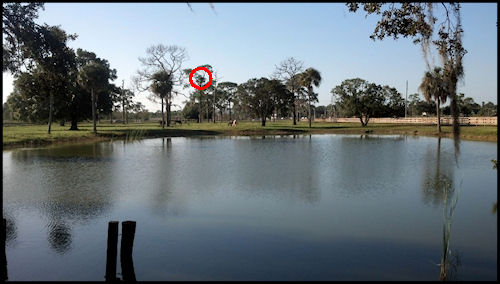
the nest as seen from just outside the Pritchett Real Estate office, September 2012
photo courtesy of Andy Pritchett
Based past experience for this pair, look for eggs in late November, chicks in early January, and fledging in late March.
Berry College
This nest is on the grounds of Berry College in northwestern Georgia. Eagles had been seen in the area - and built a nest in early 2012, though they did not nest. They returned in fall 2012, laid eggs late in the year - and successfully fledged 2 eaglets in April 2013. A camera was installed in the nest tree in fall 2013, along with an "approach" cam which provides a wider view of the tree, and the eagles flying in and out. There was an unexpected challenge here in 2014 - the female was seen to be limping in September 2013 and it was thought that her left leg may have been injured in a territorial fight with another female; in spite of that, she laid two eggs, one of which hatched, and B3 fledged successfully; the female's leg seemed stronger by the end of the nesting season, and I think it looked as if she was moving her toes a bit - so we're hoping for continued improvement in 2015. 2015 was a good year - the female looked stronger, she laid two eggs, both hatched, and B4 and B5 both fledged successfully. The pair again had two eggs in 2016, both hatched, and B6 and B7 fledged sucessfully and were seen in the area for at least another month. 2017 was a repeat - two eggs, two chicks, and B8 and B9 fledged successfully and were seen for another month learning to be eagles.
In fall 2017 it was noted that the female appeared to be having more trouble with her injured left leg - but she still laid two eggs in 2018; both hatched, but sadly one of the chicks (observers think the younger one B11) fell off the nest and died when about 10 days old; B10 fledged successfully. 2019 was another sad year - the female was still having issues with her left leg and the foot appeared twisted but she was still able to work on the nest; the pair laid two eggs and both hatched at 41 days, which is past the usual hatch window (perhaps because the female wasn't able to keep them as warm as usual?); the second chick, B13, never recovered rom the hatch process (which took about 3 days) and died the day after hatching; older chick B12 appeared either injured or stuck in the nest cup when s/he was a week old, and was confirmed to have died the next morning; the tiny silver lining here is that the loss of the chicks gave the female the summer to recover as best she can from the injury to her leg - here's hoping....
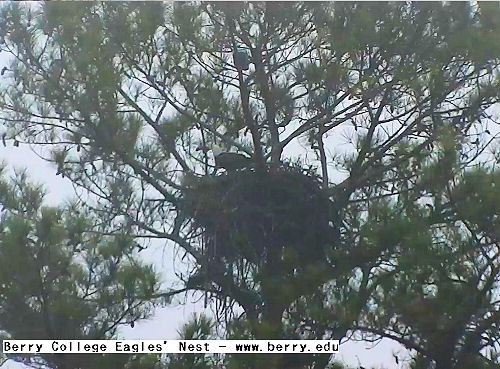
view from the approach cam, December 7, 2013
photo courtesy of Berry College
Based past experience for this pair, look for eggs in late December, chicks in late January, and fledging in mid to late April.
Upper Mississippi River Refuge
Fulton
adults Hope (F), Valor I (M) and Valor II (M) (through March 2017)
adults Starr (F), Valor I (M) and Valor II (M)
This nest is located on the Upper Mississippi River National Wildlife and Fish Refuge in Fulton, IL. According to records on the website, the pair has a mixed record. Their nest and eggs were destroyed by high winds in 2004 and 2005; one of the pair died in 2006 after flying into a powerline and the other adult abandoned the nest. A new pair formed and fledged 2 chicks in 2007, 3 in 2008, 1 in 2009, and 3 in 2010. They moved to a new nest in 2011, laid eggs but then abandoned the nest, and that tree blew down in June. They returned to their old nest in 2012 and laid two eggs which subsequently hatched, but the chicks were left alone for long periods of time, and both crawled near the edge and fell from the nest. As of fall 2012, they appear to have moved to a new nest, so they will not be online in 2013. 2013 turned out to be a good year for this nest - the Stewards of the Upper Mississippi River Refuge were able to install a cam that provided a long-distance view of the nest, and reported that two eaglets fledged successfully. There were three adults seen in fall 2012, and on February 21, 2013, when they were incubating there were two adults on the nest and a third adult came and sat next to them - so there may have been a mate exchange - or this nest may be one of the rare three-adult nests. Hopefully they will be able to install a camera nearer the nest for 2014 - but it is a remote location so that may be a challenge. The pair had a new nest in 2014 - no cam and observers were unable to see the nest. They fledged three chicks in 2015- and there is a cam for 2016! The new cam shows this is definitely a cooperative nest with one female and two males, and both males have mated with the female; the group monitoring the nest suspects it's been a 3-eagle nest since 2013, but couldn't confirm that until the 2016 cam went live. The trio had three eggs in 2016 and all hatched, but then the cam went down; the Stewards of the Upper Mississippi River Refuge saw one of the chicks flying in early June, and said they thought all had fledged.
2017 started off normally with the return of the three eagles; Hope laid three eggs, and two of them hatched; the chicks were called Stormy and Sunny. When they were a little over two weeks old, another eagle attempted to attack the nest, and was met off-cam by Mom Hope; observers reported hearing calls and flapping, and both males flew in and out of the nest several times, though generally one stayed with the chicks. When the noise settled down, things seemed more normal - an adult brought food, and then one of the adults settled down to brood the chicks; it had been raining, making it harder than usual to know who was on the nest, but we thought it might be Hope taking the night shift. The next morning was cold and rainy, making it even harder to know who was who. The adult on the nest focused on trying to keep the chicks warm and dry. The rain finally let up some - and the male who had been covering the chicks left. We learned later that two people from Fish and Wildlife had come to check beneath the nest, where it sounded as if the fight had occurred, to see if anyone needed to be rescued since the Stewards realized Mom Hope had not been seen since the fight; they did not find Hope or the other eagle, but their closeness to the nest spooked the males. The chicks huddled together, and it looked as if the smaller one stopped moving - we feared we'd lost Sunny, and knew Stormy was only slightly older, and still to young to be uncovered in the rain. The cam was turned off temporarily, and we all feared the worst - but then they posted that one of the Dads had returned and was warming the chicks, and followed up by reporting that both chicks had been fed. The cam came back up the next day - and we saw both eaglets, looking great. Hope never returned to the nest, but the males did a great job of caring for the chicks, including the nighttime brooding that a female usually does - and both Stormy and Sunny fledged successfully and were seen flying in the area before the cam went off for the season.
We had all wondered if Hope would return after a while - but as the new season begins, we are seeing the two males courting and being courted by a new female - so it seems that Hope has moved on, one way or another - and I'm looking forward to watching this new trio develop in 2018.
The new female was named Starr, and did a good job jending her two eggs with the support of the two Valors; it took a while for Starr to figure out how to feed her new chicks (which was fine because the Valors were experts!) - but she soon became a pro. There was some scary weather, but they came through it fine - and everything was going great, though the younger chick was bit smaller in spite of all the food brought to the nest - until around April 16 or 17, when the younger chick seemed to lose interest in eating. It was thought that he or she might need to expel a pellet - and some observers thought he did expel a big pellet about the time he stopped eating. Whatever the cause, he died either late April 18 or very early April 19. He was four weeks old. Rest in peace, little one. The older chick intentionally flew out of the nest on May 19, I believe in an attempt to escape the swarm of gnats or similar little bugs infesting the nest; the Stewards of the Upper Mississippi River Refuge who oversee the nest and control the cam are calling it a fledge - and it was definitely intentional - but the chick was less than nine weeks old and hadn't even branched, so I consider it more an attempt to get away from danger; observers reported hearing sounds like the eaglet made while being fed afterwards, and I'm hoping he landed on a branch that somehow lets him lie down because I have doubts about his ability to sleep standing at that age - but eagles do amazing things; high water levels and heavy undergrowth make it impossible for the Stewards or the wildlife folks to get close enough to see where the eaglet is without potentially scaring it into jumping to somewhere even more precarious - and the young one has great parents - so we were optimistic; the eaglet never returned to the nest, but we could hear her calling and believe from the sounds that the parents fed her away from the nest and she learned to fly and eventually left the area, as she would have done had she stayed longer in the nest. As an aside, the first chick hatched 10-14 days later than chicks in the previous two years; if she had hatched earlier, she might have been at the branching stage when the bugs got bad, and able to escape the worst of them that way.
Starr laid three eggs in 2019 - quite amazing for her second year on the nest - and all hatched successfully and were progressing well - and then the youngest eaglet was accidentally knocked off the nest when 9-1/2 weeks old by one of the older eaglets who was flying up to a branch; the eaglet could be heard under the nest, and local observers reported that he or she appeared healthy and was being fed by the parents. A number of observers believe the youngest returned to the nest June 20th, 2 weeks after the accidental fledge; the other two eaglets had fledged a couple of days earlier, and middle one had returned by then, but the oldest had not; I don't believe all three fledglings were seen together, and it's hard to ID fledglings, but observers thought all three were coming to the nest

Ferenz's screenshot - December 26, 2016
image © 2017 StewardsUMRR, JCWiFi
Based past experience for this pair, look for eggs in early February, chicks in mid-March, and fledging in mid-June.
Indiana
Notre Dame
South Bend
new cam for 2016, sponsored by Notre Dame Linked Experimental Ecosystem Facility (ND-LEEF)
The 2016 camera did not provide a great view of the nest - it was off to the side, and there were leaves - but it appears that there was one chick, and it fledged and was seen flying. There were plans for a new cam for 2017, but the view was similar for much of the season; the website reports that two eaglets hatched, but there doesn't seem to be much additional information. Happily the new overhead cam was installed in the fall of 2017 - so perhaps next year we'll be able to see more of the action! The pair had two eggs in 2018 and ND5 and ND6 fledged successfully. There were three eggs in 2019, and ND7, ND8 and ND9 all fledged successfully and were still being seen a month later.

My screenshot - original cam - nest without leaves or eagles - December 1, 2017
Based past experience for this pair, look for eggs in mid-February, chicks in mid-March, and fledging in mid-June.
Arconic
Davenport
(was Alcoa)
formerly Alcoa Davenport (pre-2017)
adults Liberty (F) and Justice (M)
According to records on the website, Liberty and Justice built their nest on the Alcoa site in 2009 and fledged 2 eaglets in 2010. A cam was installed for the 2011 nesting season, and the pair fledged one eaglet, named Freedom in a viewer poll. They raised and fledged three eaglets in 2012, named Faith, Hope and Spirit. The pair laid 2 eggs in 2013, and Glory and Honor fledged successfully. The pair laid two eggs in 2014, but one was broken, perhaps when when lots of other eagles were seen in the neighborhood, and an adult may have damaged it defending the nest; the other egg hatched, and the eaglet named Rudy fledged successfully. 2015 was a tough year here - the pair laid two eggs, but the first broke the day after it was laid, and the second egg disappeared shortly before time for hatching (my guess is that it wasn't viable as non-viable eggs seem to collapse around the time we're watching for a hatch); there was bad weather and intruder issues, so it's hard to say what might have happened. We're hoping for better luck in 2016.
2016 was an interesting and ultimately good year. They pair laid two eggs and hatched two chicks who were named Star (F?) and Sky (M?) and were banded and fitted with transmitters using cell tower technology (likely gender is based on measurements at banding - Star/#0709-04924 was 10.2 lbs and all her measurements were bigger than Sky/#0709-04920 who was 7.8 lbs). A line of bad storms went through the nest area on June 14, both chicks were apparently blown out of the nest, about 90 minutes apart (power was out, but their transmitters showed when they left the nest); they were 64 and 67 days old (~9.5 weeks), and had just started preliminary branching. A team from Fish & Wildlife checked the chicks, found them to be healthy, and put them in a tree with lots of branches; they stayed in the tree for a few days, then began exploring, probably with short low semi-flights, and perhaps little hop-flights up onto branches. The first eaglet (maybe Sky) made it back to the nest June 30; both were back by July 2; sort of a reverse fledge, and they did a lot of sleeping once they first got back, but were flying in and out within a few days. They remained in the area until August 19-20. Update - both are still checking in as of November 2017!
2017 was another good year - they laid three eggs, all hatched, Mercury/#0709-07307 (M), Gemini/#0709-07306 (M) and Apollo/#0709-07305 (F) all fledged successfully and are still checking in as of November 2017 (as are Star and Sky from 2016) - lots of maps on the Arconic site.
The pair only had one egg in 2018, on February 15 - and on March 16, Liberty was attacked on the nest by an intruder; the intruder was driven off, but Liberty systained some wounds, and the egg may have been damaged; the pair tended it on Saturday, but left it untended Saturday night, and it disappeared on Sunday; the egg (or part of it) has been seen since then, but it seems unlikely it's viable (though I've seen some very unlikely eggs hatch). It was reported that Liberty had some injuries to the feet and the head, but was eating, flying and hopping up to the branch, so hopefully OK. There was a technical issue with the cams on Tuesday, March 20, so no details but as of March 29, it appeared that the egg had been buried in the nest; Liberty appeared to be healing well, and both were working on the nest.
A Canada goose was on the nest April 9 and may have laid an egg; the eagles chased it off, but one of the eagles might have incubated it briefly. The goose came back a couple of times, but the eagles kept control of the nest.
2019 was a more normal and happy year - the pair laid two eggs, and Windy and Storm both fledged successfully; flooding took out the cam during the fledge window so we didn't see the fledge, but both were seen in the tree after the flood and both were seen returning when the cam was hooked up again.
Based past experience for this pair, look for eggs in mid-February, chicks in mid-March, and fledging in mid-June.
Decorah
adults Mom and Dad Decorah through mid-April 2018
adults Mom Decorah and DM2
This nest was featured on the Nature show "American Eagle" - and now you can watch it live! The nest is in Decorah, Iowa; the exact location is not publicized to protect the eagles. Local time is Central time. The pair has been observed since 2002, but 2009 was its first year online. They successfully raised three eaglets in 2009. This pair laid three eggs in 2010; the first two hatched two days apart - and the third hatched a full week after the first; in spite of the rather impressive difference in size and development between #1 and #3, all three thrived, and fledged successfully. They again laid three eggs and fledged three eaglets in 2011, and one of the fledglings was fitted with a tracking device - you can follow the travels of D1 here. This pair again laid 3 eggs in 2012, and successfully fledged D12, D13 and D14 (official numbering system set up starting with 12, to acknowledge that there are 11 known previous successful fledges from the nest); sadly both D12 and D14 (who got this year's transmitter) died from electrocution after coming to close to wires on electrical poles, D12 a few weeks after fledging, and D14 later in the fall. The eagles are building a new nest as of fall 2012, though still visiting the current nest occasionally. If they use the new nest, there won't be a nest cam in 2013, though one may be added in fall 2013. They did use the new nest in 2013, but thanks to a dedicated local observer, we know they laid at least 3 eggs, and D15, D16 and D17 fledged successfully.
The pair laid three eggs in 2014, and all hatched - and all fledged, though at a fairly young age, perhaps because of flies or gnats bothering them at the nest; unfortunately they had issues after fledging - D18 died after flying into a power line several weeks after fledging; D19 (F) was found in the road by local police a few days after fledging and didn't run when approached by Bob Anderson from the Raptor Resource Project, so he caught her and put her in a holding area overnight and provided lots of food; she was flying well by morning, so he outfitted her with a transmitter (D4 is her tracking designation) and released her near the hatchery with plans to provide supplemental food if necessary, and she and her transmitter were doing fine last time I checked in January 2015; D20 (M) was found with a broken wing a few days after fledging and taken to SOAR for assessment; the wing healed, but with calcification preventing it from moving as needed for flying so he can't be released - but will become an educational eagle at SOAR, where he will be known as Decorah.
2015 was a good year - and a lucky year - for the eagles. They again laid three eggs, all hatched, and D21, D22 and D23 all fledged successfully. Then came not exactly good news - but lucky in the timing - about a month after the last eaglet fledged, there was a severe thunder storm, and the comination of wind and lightning caused the tree to break and the nest came down; all three juvies and one adult were seen the next day, and the second adult was seen a couple of days later, so all survived the high winds - but a number of trees were damaged or blown down by the storm cell, which may make some challenges for the eagles as they rebuild. And there was more sad news for the Decorah family - Bob Anderson, the driving force behind the cams and the Raptor Resource Project that oversees them, passed away in July. I just checked the Raptor Resource Project blog and they built a starter nest new where the old nest came down, and they have pictures of the eagles working on the nest posted on their forum - so here's hoping we'll get to see them in 2016!
The eagles adopted the starter nest, laid three eggs, two of which hatched, and D24 (M) (banded on right leg) and
D25 (M) (banded on left leg) both fledged successfully; both eaglets were caught after fledging and equipped with transmitters. Sadly D25 was struck by a car and killed in September 2016. D24's transmitter stopped transmitting in July 2017; his last known position was in the Decorah area.
2017 was a good year - they laid three eggs, all hatched, and D26,
D27 and
D28 fledged successfully; D27 (F) was caught after fledging and fitted with a transmitter in August 2017, and is still transmitting as of November 2017.
The pair again laid three eggs in 2018 and all hatched; unfortunately the male eagle known as Dad Decorah was last seen on the nest at about 7:30 pm on Wednesday, April 18, just after a bad snowstorm when the chicks were 14-17 days old; the Raptor Resource Project and other people in the area searched extensively, but have not found any sign of Dad. Fortunately the nest is near a fish hatchery and there are fish running in the stream below - and observers actually saw Mom arrive at the nest with two large fish, carrying one with each foot! As of April 25, there is another male eagle in the area, being called UME for Unidentified Male Eagle, and Mom has been seen flying with him, but is not letting him near the nest - and I haven't seen any reports of his providing any food. People always said Mom Decorah was amazing and she proved it this year - D29, D30 and D31 all fledged successfully.
Mom Decorah had a couple of suitors after Dad disappeared in April 2018 and the one she seems to have settled down with is being called DM2, for Decorah Male 2 (DM1 was an earlier suitor who apparently didn't work out); the new pair laid three eggs for 2019, but sadly one of them broke after a few weeks (observers think the first one laid); there was no apparent reason, though there are many things it might have been. The other two hatched successfully. Older chick
D32 branched at 9:54 am on June 4 (61 days old) and had a slip/accidental fledge that evening while trying to go from one branch to another in the wind; D33 then tried branching but returned to the nest for the night; the next day D33 again went out on a branch and spent much of the day there, before slipping while trying to move around on the branch (59 days at time of accidental fledge); flies were bad in the nest, so it's possible that the chicks were spending more time on branches before they were quite strong enough to get away from the bugs.
D33 (F) was found later that evening and appeared a bit underweight but uninjured, and was taken to a local rehab to be evaluated and stabilized; they found that D33 had many bites from the gnats and was thin, anemic and a bit dehydrated. D33 progressed nicely at SOAR and she was moved to a flight pen with 3 other fledglings (including DN9 - see below) in late July to develop her flight skills; the pen also has wading pool where the youngsters can take baths - and practice grabbing thawed frozen fish from the water.
D32 (M) was found in the evening of June 7, 3 days after leaving the nest tree; D32 was also weak, underweight and anemic, with many black fly bites (same bugs, different names); after being stabilized, D32 was also brought to SOAR (Saving Our Avian Resources) on July 9; it was determined that one of the bones in D32's right leg was broken (the tibiotarsus) and the break was very near the ankle, making it difficult to treat, but the folks at SOAR gave it a try, and as of mid-August he seems to be progressing nicely; he is currently rooming with SOAR's educational eagle Decorah, a 2014 eaglet from the same nest who broke his wing soon after fledging and did not heal well enough to be released.
D33 and her 3 flight pen mates were soft-released on September 18, and all left shortly after the window was opened.
As of October 1, D32's leg is healing and he can use his foot, but he's still in rehab.
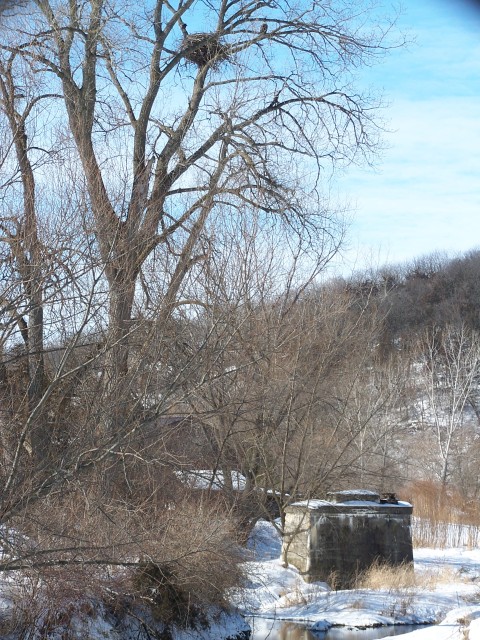
Nora in IA's photo - February 17, 2010
©2010 Nora in IA, used with permission, all rights reserved
"Here is the nest/tree from the bridge that you see east of the cam. Mom was sitting on the same branch as she was before when I was over there. The nest is above the stream right where two forks come together and form the one that goes under the bridge."
Based past experience for this pair, look for eggs in the first half of March, chicks in mid-April, and fledging in early July.
Iowa
Decorah North
adults Mr and Mrs North through 2018
adults Mr North and DNF
A new cam for 2016 from the Raptor Resource Project. The Decorah North eagles are nesting on private property north of Decorah. Their very large nest is located in a white oak tree in a scrap of forest bordering a valley and an excellent stream is located just across a field where cattle are pastured. According to the Raptor Resource Project, the nest we are watching now is the third nest built on this territory in six or seven years; it's not known if the same pair of eagles have been there all along.
The pair laid 3 eggs in 2016, and all three hatched. Youngest chick DN3 died May 11 when he/she was 18 days old; the older chicks had started their growth spurt and were much bigger so were able to compete more successfully for food, though DN3 was generally being fed - and there were a couple of cold damp days when the older chicks with their heavier down didn't need brooding during the day, but perhaps DN3 with less heavy down still did. Two weeks later, DN2, the younger of the remaining eaglets, died, apparently after eating something toxic brought in by one of the adults; the female appeared quite ill also, so it's surmised that she ate some of the food as well as feeding it to DN2; happily it appears that DN1 did not have take part in that feeding, and s/he and the male were not affected; DN2's body was retrieved from the nest for testing, and so that it would not be eaten by the adults or fed to DN1; the final autopsy on DN2 showed that the eaglet died as a result of Methomyl toxicity, although caffeine was also present, which suggests the illegal off-label use of a fly bait mixed with a soda like Coke or Pepsi to kill a pest like a raccoon - part of which was brought to the nest as food for DN2; the results of the autopsy were shared with appropriate wildlife agencies, and hopefully this tragedy will help educate people of the unintended consequences of using this very lethal poison. DN1 fledged successfully.
The pair laid three eggs in 2017 and all three hatched, but youngest DN6 died two days later when the cold wet weather shortened feeding times and created a need for more calories, and the much smaller chick couldn't compete and soon became too chilled to try. DN4 and DN5 both fledged successfully.
2018 was a sad year here. This pair only laid one egg initially, and it sadly broke or collapsed less than 3 weeks later; I couldn't help but wondering if Mom was lacking in some nutrient necessary for producing healthy shells. The pair surprised us with a second clutch, and both those eggs hatched, but sadly both DN7 and DN8 died on May 25 when they were 7 and 5 days old, apparently from a severe infestation of gnats aggravated by high temperatures. And then the nest collapsed at the end of August during a bad storm; apparently the supporting branches didn't break - the nest (which was soaked with rain at that point) slid off them as they were blown about by the winds. The Raptor Resource Project provided a starter nest to replace the one that fell - so now we wait to see if they use it next year.
There were more changes in 2019. The original pair were named Mr and Mrs North by the Raptor Resource Project; the original female was there during the summer, but when the cam came back online in the fall, observers realized the female on the nest did not look like Mrs North - and after a more in depth review, that was confirmed; RRP is calling the new female DNF for Decorah North Female, and ask that she not be called Mom North. The new pair laid two eggs and both hatched, but younger chick DN10 died within a day or so of hatching. DN9 branched on June 5 (66 days old); there were lots of flies/gnats on the nest pestering him/her, which might have encouraged the move out of the nest; the next day s/he again stepped to the branch and you could see the cloud of flies around him/her - and after a couple of minutes, s/he slipped from the branch; DN9 was initially found in the pasture under the nest; folks from the Raptor Resource Project did a quick assessment, found no injuries and observed that the adults were caring for and defending the eaglet, and left; the next day, having heard the report on D33 (see above), they returned and rescued DN9 for delivery to SOAR; she joined a group of 4 eaglets with D33 and made her way to the flight pen with the wading pool where they can practice grabbing dead fish out of the water and on to the big flight pen to strengthen their wings.
D9 and her 3 flight pen mates were soft-released on September 18, and all left shortly after the window was opened, with D9 leading the way.
Based past experience for this pair, look for eggs from late February through mid-March..
Maine I
Hancock County
The cam is located in coastal Hancock County, and is streaming video with sound. It has infrared for night viewing, although that may be turned off during the off season, and is a pan-tilt-zoom to allow closeups of the chicks when they're small.
The eagles have nested at this site since 1995 and raised 20 offspring, making them one of the most successful pairs in Maine when the cam first came online. They fledged two eaglets on cam in 2006 (a third chick was lost, likely due to sibling rivalry), but had tragedy in 2007 - the weather was brutal right after the chicks hatched and they lost them; they did not lay eggs in 2008 or 2009 (taking a year or two off after a nest failure is apparently fairly common). Eagles were seen at the nest regularly in 2010, though it's not certain if this is the pair from earlier years or if a change occurred at some point since the loss of the chicks in 2007; they did not lay eggs. The current pair actually laid two eggs in 2011, and we all had our hopes up for a successful season - but it was not to be; it's not clear quite what happened, but there was a bad storm shortly after the eggs were laid and the female (who might be relatively young) was gone for several days; when she returned she didn't resume incubating, and the male was unable to do it all, so the nest was eventually left untended and subsequently failed; there may also have been one or more other eagles in the area, adding to the stress. We are hoping - really hard - that they will finally be successful in 2012.
The pair nested in 2012 - and two chicks hatched! Unfortunately the younger one (nicknamed Geddy by the Maine forum) was lost to sibling rivalry when five weeks old in the wake of a major rainstorm; the chicks were alone during much of the storm (unusual for chicks so young), and food deliveries were few and far-between for several days afterwards. The older chick (nicknamed Eden) not only got all the food, but launched a series of brutal attacks on the younger chick, who eventually fell from the nest to his death. Although it appeared to some of us observing the cam that the adults spent less time on the nest than at most nests and the remaining chick had to self-feed more than usual after the storm, the chick fledged successfully. She (or maybe he) was still visiting the nest and occasionally being fed until September 26, roughly 10 weeks after fledging, and some observers were quite certain they heard her calling in the distance well into October. The adults began major work on the nest on September 28.
In a replay of last year, two chicks hatched in 2013, there was some bad weather, followed by a drop in food deliveries, which led to the younger eaglet (nicknamed Moxie by the Maine forum) not being fed; he died when he was six weeks old. There was not the level of attacks that we saw last year, perhaps because the eaglets were a week older than when this happened last year - or perhaps it's a difference in gender or personality. The older eaglet (nicknamed Willow) only attacked the younger one when necessary to make sure the younger one did not get any of the food. Moxie tried to be sneaky, and managed to grab and swallow the tail end of a fish - but it wasn't enough. It again appeared as if Willow was self-feeding much of the time after that, though one of the adults (likely Mom) did stop by occasionally to feed whatever had been delivered or could be found on the nest, which in time included Moxie's body. Willow fledged successfully in early July, and was last seen on the nest on July 31, though the cam was down frequently in August so we may have missed some visits. There were no reported visits in September.
For the third year in a row, the pair had two chicks, known as Big and Little - and this time they made it past 7 weeks before there was any significant rivalry - but the outcome was the same, but perhaps more brutal because Big was old enough to do some self-feeding, and appeared to be trying to kill and eat Little; Big subsequently fledged successfully. The cam was off-line from mid-August until December 30, and went down again 3 days later - so we don't know if there will be a cam for 2015. Well - the cam did not come back online, and in August BRI's spokesperson said they "do not currently have plans to reinstate the webcam program" - so maybe someday - but probably not. He did say that the eagles nested, but his source did not know if any chicks fledged successfully.

Sherri's s'cap - February 21, 2009
(The cam streams in color - this is an infrared shot taken shortly before the cam switched to color for the day; I think it gives a good sense of the nest's location in the tree.)
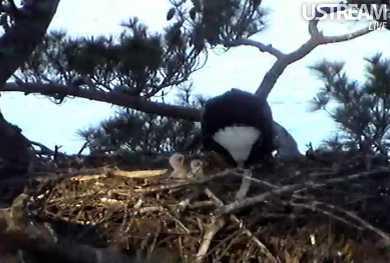
JudyB's s'cap - May 6, 2012
Before 2011, eggs were generally laid in the first half of March, with chicks in mid-April, and fledging in early July; more recently, eggs have arrived in late March, with hatching in early May and fledging in mid-July.
Maine II
Central Maine
The cam is located in central Maine, and according to BioDiversity Research Institute (BRI) the nest has been occupied every year since 2001 (and the territory has been used at least on and off for the last 30 or more years). 2009 was the first year there were cams on the nest. There are two cams, one looking at the nest from the side, and the other over the nest looking in. Both have night vision and constant 15-second refresh views; BRI was hoping to stream from one of the cams, but so far has not had much success with that, and the side view cam apparently failed just before the first egg was laid in 2010.
The pair successfully raised two chicks in 2009. The pair laid two eggs in 2010, and both eaglets fledged successfully. Unfortunately the nest tree fell over during a major wind/rain storm in November 2010; both eagles have been seen since the collapse, and indications are that they are starting a new nest. BRI is hoping to install a cam for the 2011 nesting season if the eagles choose a location where that can be done without disrupting the nest. No cam in 2011; it was reported that the eagles were seen, but it wasn't known if they raised any eaglets. No news since then.
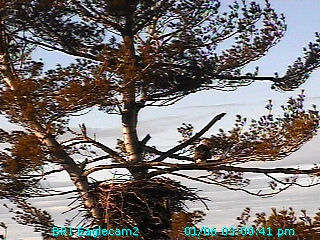
JudyB's s'cap - January 6, 2010
Based on other nests in the general area, look for eggs in the last half of March, chicks towards the end of April, and fledging in late July.
Maine III
(or 2B)
Coastal Maine
The cam is located somewhere Maine, and because it is on private property, BioDiversity Research Institute (BRI) has chosen to not be more specific than to say it's in coastal Maine. The cam has night vision, and appears to have sound, although that seemed to come and go. Note: BRI is calling this Eaglecam2 - which I find confusing as it's a different nest than Maine II, which was also called Eaglecam2.
2011 was the first year for this camera, and it came online in mid-April; one of the adults spent a lot of time sitting on the nest, but we never saw any eggs - don't know if they did have some and lost them, or what the pre-camera story might be. We're hoping to learn more about this pair - and perhaps see some chicks - in 2012. 2012 was another non-productive year at this nest - iIt appears that the male died around the middle of March, electrocuted when he flew into a power line, perhaps while chasing an intruder; a new male was seen on the nest shortly thereafter, with a dark spot on his head and some darker feathers in the tail, but he was quite inexperienced in his attempts to mate (even standing next to the willing female a couple of times while making all the right motions, but nowhere near the target area), so there were no eggs. We're hoping things will be better in 2013. The female looked as if she was getting ready to lay eggs several times in 2013, and spent quite a bit of time looking as if she was incubating - but no eggs were ever seen. Definitely unusual behavior, at least in my experience. The pair was seen occasionally in 2014, but did not nest. In 2015 the cam was online intermittently through April, when it went down for good; the eagles were seen working on the nest, but didn't lay any eggs, and BRI currently has no plans to reinstate their webcam program.

JudyB's s'cap - April 16, 2011
Based on other nests in the general area, look for eggs in the last half of March, chicks towards the end of April, and fledging in late July.
Maine
Sasanoa River
no cam
This is a pair of eagles that nest near me; even though dates will be approximate, I'm adding them to this table for my own reference purposes. Their nest is a bit unique in that it's on an osprey platform on a small island in the Sasanoa River. My normal viewing point is on a bridge about 3/10 of a mile from the nest.
We discovered this nest in 2010, and the pair fledged two chicks that year. We saw one healthy-looking fledgling in 2011 (and can't guarantee that there wasn't a second - the distance combined with our infrequent visits make it hard to be sure), and they again raised one fledgling in 2012. We occasionally saw eagles in the area in 2013, but they didn't nest on the platform, and we don't know if they nested elsewhere or if they took a year off. They were back in 2014, and again raised one fledgling. 2015 was a sad year - it looked as if they had eggs by the end of March (probably earlier), and it looked as if they were feeding a chick on April 19 - but the next few days were cold with lots and lots of rain - and when I visited on the 26th, both adults were perched on the side of the nest, but they were not brooding, and made no move to cover the nest when it began to rain again, so I think their chick(s) fell victim to the cold wet weather. As of December 2015, the eagles are around (they don't migrate), so I'm hoping for a better year in 2016. Unfortunately, this pair hasn't been getting any breaks - I'm pretty sure they had eggs in 2016, but don't think they hatched, and I wasn't able to get down to confirm that they were incubating in 2017 (though we thought they were) - but no chicks. The eagles didn't nest on the platform in 2018 or 2019, though they might have an alternate nest; they are still in the area.

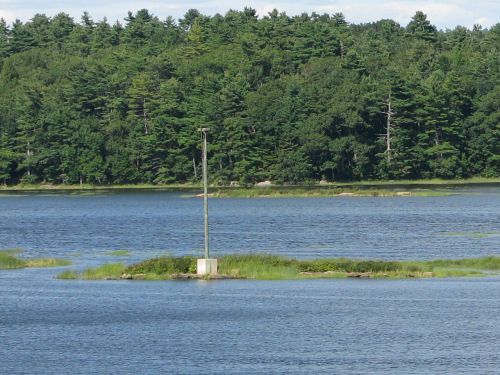
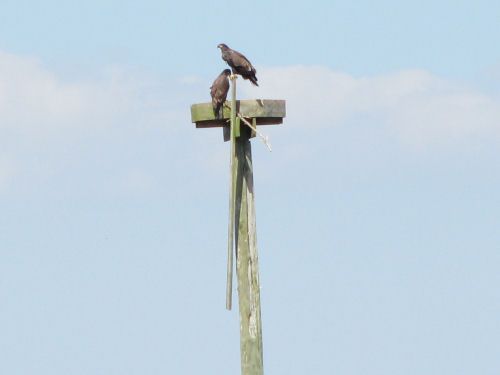
JudyB's photos - the closer shots are from 2010 and the view from the bridge is from 2014
Based on other nests in the general area, look for eggs in the last half of March, chicks towards the end of April, and fledging in late July.
Maryland
Blackwater Refuge
The camera has frequently updating still shots, and uses infrared technology to provide "night vision." It is generally offline once the fledglings leave until midwinter. It is also turned off from 11 pm - 3 am to reduce bandwidth expenses.
The nest is located about 80 feet up in the air in a tree in the Blackwater National Wildlife Refuge in Cambridge on Maryland's Eastern Shore. This is one of the first nests to have a camera, and has been online since 2005. The pair has successfully raised three chicks in 2005 and two in 2006, 2007, 2008, 2009 and 2010. They laid three eggs in 2011; all hatched and all three fledged successfully. 2012 was a very sad year at this nest; the pair laid two eggs which hatched successfully, but left the chicks alone more than usual, perhaps because food was scarce or because there were intruders in the area, and an adult eagle landed at the nest and attacked the 8-day-old eaglets while the adults were off the nest, killing the older one and fatally injuring the younger one. A new cam has been installed for 2013 - still transmitting as a refresh cam, but higher resolution - and we are hoping for a much happier year. The pair laid 3 eggs in 2013 and all hatched - but the third hatched 5 days after the second, and its smaller size combined with a bad storm may have set up a situation where it couldn't successfully compete for food, even though food was plentiful, and it died when about 5 days old; the two remaining chicks, named Talon and Soar, fledged successfully. The pair again laid three eggs in 2014; only two of them hatched, and Glider and Chaser fledged successfully.
2015 was a strange and ultimately sad year here; the pair laid three eggs, two of them hatched; all looked normal - and then the healthy-looking younger one died for no obvious reason when he or she was about 4 days old; the older chick continued to thrive - but when she or he was 2 weeks old, she was exploring the nest, and as it began to get cooler, the adult focused on incubating the remaining egg, rather than brooding the chick or trying to get her back to the nest - and the chick died, probably from hypothermia. We hadn't seen anything to suggest that one or both adults were new - but that seems very unusual behavior for an experienced pair. We're hoping for a much better year in 2016.
2016 was another strange year - there was a lot of snow the day the first of their two eggs was laid, and the egg was left alone a lot the next day, sitting on some pine needles in a snow-filled nest, so we wondered if it would hatch. Then about two weeks later, something appeared to upset the female the evening of February 9, and neither adult arrived to incubate; it was cold that night, with a dusting of snow; the adults incubated occasionally the next few days, then started spending much of their time on the nearby osprey platform. The abandoned eggs were eventually eaten by a vulture on Feb 25. A pair of eagles (which might not have been the resident pair) was seen in the area in 2017, and the resident eagles were seen as usual on the osprey cam before the osprey arrived - but no one nested in the nest with the cam. There were eagles in the area again in 2018, but no one used the nest with the cam - and there was no cam in 2019, as the Friends of Blackwater observed several nests at the refuge with the hope of putting cams in one of them for 2020.
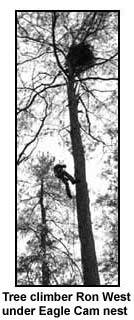
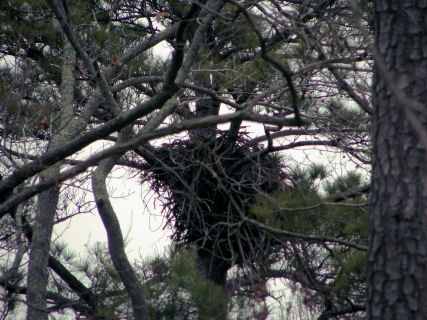
(photo of tree climber from Friends of Blackwater Eagle Web Log, all rights reserved;
closeup of nest © 2007 Paula Compton, used with permission, all rights reserved)
Based on past experience, look for eggs in mid to late January, chicks in late February to early March, and fledging in mid to late May.
Massachusetts
Barton's Cove
no cam
Barton Island is a small island in the Connecticut River, near Barton Cove, in Gill, Massachusetts. A female eagle originally raised and released at the nearby Quabbin Reservoir in 1985 paired with a male bird released in 1986, forming the Barton Island territory in 1989. The original male was subsequently replaced (in 1996?) by a male with leg bands indicating it came from New York State. The nest has produced one or two chicks most years since 1989, although there were three years that the pair was unsuccessful (1997, 1999 and 2001). They fledged two chicks in 2002, one in 2003, two in 2004, one in 2005, two in 2006 and 2007, and one in 2008.
The nest tree below collapsed at the end of the 2008 nesting season (eaglet and parents were fine).
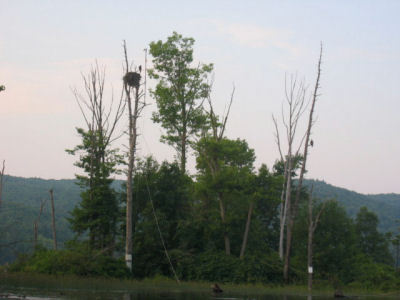
July 26, 2007 - 2 fledglings
© 2007 Sharon Feeney, used with permission, all rights reserved
They are now nesting in a red oak nearby, but they established their nest too late for a camera to be added for the 2009 nesting season. As far as we know, they didn't actually raise any eaglets in 2009 - though the nest is a long way from the nearest vantage point. The utility tried to get the cam operational for 2010, but they had a very small window to visit the island and the weather didn't cooperate; local observers reported that they did have one or more chicks, and a visit to band the chick(s) determined that there was one healthy chick and the remains of a second chick. We hoped there would be a cam in 2011 but that didn't happen; a local photographer reported that there were two chicks, both of which fledged successfully. There were no reports in 2012. The photographer saw three chicks in the nest in 2013, and later saw all three perched near the nest so all fledged successfully. Still no cam for 2014, but the local photographer saw three chicks fledge successfully. And in 2015, he reported that only two eaglets were seen, and both fledged successfully. Three chicks were seen in 2016, and all fledged successfully. Leaves made it hard for the photographer to see into the nest in 2017, but he confirmed two chicks and reported that both fledged. Pictures at https://squidmon.smugmug.com/
There are great pictures for 2018 and 2019 from a number of nests at the above link, but it's becoming more removed from the cam we once watched, so I'm dropping coverage of this nest, with best wishes for the adults and all the fledglings over the years.

February 14, 2009 - new nest (at far right above the white birch)
© 2009 Sherri Delaney, used with permission, all rights reserved
Based on past experience, look for eggs in early March, chicks in early to mid-April, and fledging in early July.
Michigan
Beulah
2016 is the first year for this eagle cam.
In partnership with the Michigan Department of Natural Resources, CarbonTV brings you 24/7 live streaming from a site near the Platte River State Fish Hatchery, which was established in 1928 as a satellite rearing station and converted to the state's main salmon hatchery in 1972. This facility raises coho and chinook salmon and is the main egg take station for coho salmon in the Upper Great Lakes.
The pair laid two eggs in 2016, both hatched, and Honor and Beulah both fledged successfully and were seen in the area for a month or so as they learned to be eagles.
They laid two eggs again in 2017 and both hatched - but sadly one of the chicks was accidentally dragged out of the nest bowl the day #2 hatched, and became stuck - and died of hypothermia overnight. Happily the remaining eaglet, named Spirit, fledged successfully.
The eagles likely moved to a new nest for 2018, and that nest still had not been found for 2019, and I've seen no indication that there will be a cam in 2020, so unless a cam (or consistent local observer reports) show up, I'm dropping this nest.
Based past experience for this pair, look for eggs in mid March.
MN Bound
2012 was the first year I became aware of this cam, although MN Bound did place a cam at different location attempting to view the nest last year; I haven't seen any reports on the success of the nest in 2011. The folks running the cam believe there was a new male in 2012, probably young as he had a black spot on his head, and initially had a band on one leg, though that apparently fell off (the spot remained constant). The pair laid two eggs, but sadly the younger eaglet (named Kirby) fell from the nest when he was 16 days old and did not survive; it appeared that he was standing on one end of a piece of skin, and when the adult moved the skin, he was tossed up to the edge of the nest.
The older eaglet, named Harmon, became stuck in the nest when he was a little over 3 weeks old; he was removed from the nest the afternoon of May 4 and taken to rehab to be cleaned and checked out (there were some puncture wounds (from sticks in the nest?) - and maggots), and fed; there were no serious injuries, so he was returned to the nest the afternoon of May 6, along with a supply of fish heads and tails. He was alone that night, and as a second night approached, the team made plans to remove him - when the adults suddenly appeared on the nest. The reunion was amazing - I've been watching eagles for a long time - and seeing both adults trying to feed him at the same time, and then Mom preening him - it was one of the most touching scenes I've ever witnessed.
2013 was a more peaceful year; the adults laid two eggs, and Harmony and Peace fledged successfully. The pair laid three eggs in 2014, a first since we've been watching, and all three hatched but sadly the youngest Skye died after a week, probably after getting chilled by a night of heavy rain; Arky and Dakota fledged successfully. There were just two eggs in 2015, both hatched, and Spirit and Scout fledged successfully, though we're not quite sure when because of cam issues. There were two eggs in 2016, both hatched, and Hutch and Henry both fledged successfully, though one (maybe Hutch) was blown out of the nest a couple of weeks before fledging, but made his/her way back to the nest by evening.
The pair laid three eggs in 2017; all three hatched, but sadly the eaglets named Freedom, Justice and Hope
died during bad weather while the cam was down when they were about 3-1/2 weeks old. Rest in peace, little ones.
There were two eggs in 2018, and M17 and M18 both fledged successfully.
Based past experience for this pair, look for eggs in early March, chicks in mid-April, and fledging in late June or early July. Unfortunately there was no cam and no updates in 2019, though they said they hoped to have an upgraded cam for 2020.
Minnesota
DNR
Minn-StPaul
original pair through December 2017
original female and several suitors in 2018
possible new pair in 2019
(female banded) through March
different new pair beginning in April 2019
2013 was the first year on cam for this nest, and the first eagle cam for the sponsoring Department of Natural Resources. Eagles in Minnesota typically lay eggs in March, but this pair laid three eggs around the beginning of January. Not surprising, considering how cold it is in Minnesota at that time of year, none hatched. One broke or collapsed February 25; the second broke and then crumbled on March 4; the third egg broke the morning of April 5; none appeared to have much if any content; the adults were tending the egg until the end (about 90 days). I wasn't watching so don't know if they were still incubating constantly or taking breaks towards the end.
In 2014 the pair again laid three eggs, this time waiting until mid-February; they went through some heavy snow while incubating, but all three hatched! Unfortunately, when the oldest chick was about 5 weeks old, viewers realized that he or she seemed to be stuck; DNR initially restated their non-intervention policy, but after further discussion with the relevant authorities, removed the chick from the nest; they reported s/he had a serious injury to the elbow on the right wing, possible injury to the right leg, and systemic infection; after additional tests and counsultation, the Raptor Center reported that the severe injury to its elbow with bone loss resulting in a lack of integrity to the elbow joint made it impossible for the eaglet to survive in the wild, and that type of injury is likely to cause ongoing discomfort, so the eaglet was humanely euthanized. The two remaining chicks fledged successfully.
The pair laid three eggs in 2015, starting in mid-January this time; all three hatched, but #2 appeared to come out of the side of the egg, rather than pecking around the circumference and pushing the two parts apart; we saw a pip in the second egg the morning of February 27, and it looked as if the chick was close to getting out of the shell as it got dark on March 1st - which is around 2-1/2 days, while most hatches take 36 hours or less. #3 hatched quickly and normally and was doing well initially (I thought better than #2, who seemed exhausted by the ordeal of hatching) - but the third day after the two younger ones hatched was very cold with few feedings (too cold to uncover the chicks for more than a few minutes at a time and the food on the nest was frozen solid), and by the next morning #3 was weak and was poorly positioned during the first feeding, and too week to push to the front for the second, and died later that morning; the remaining chicks fledged successfully.
The pair laid three eggs in 2016, all hatched - and all fledged successfully!
2017 was a repeat - three eggs, three hatches, three fledges - I like this!
2018 was not so happy; the resident male was last seen in mid-December, and several males were courting the female, and one was around long enough for her to lay three eggs between February 19 and 25, but disappeared shortly after that; as of mid-March, there seemed to be a consistent mate, and the female was continuing to tend the eggs, and while the male wasn't incubating, he did roll the eggs occasionally and tucked in his talons when he was around the eggs, as parent eagles normally do. Not surprisingly, none of the eggs hatched. 2019 was another non-productive year at this nest - as of May 3, there are no eggs here. As far as I can tell from various Facebook groups and other sources, the resident pair disappeared around March 30; there had been a raccoon visiting the nest, and other eagles in the area - either of which might have made the pair abandon the nest; there are local photographers who observe the eagles, and they didn't find another nest; it's also possible that the resident pair lost a territorial battle. A new pair of eagles arrived soon after the resident pair left, and are settling in, but they did not lay eggs.
The new pair from 2019, known as Sid and Nancy on Facebook, laid three eggs in 2020; all hatched, but the youngest was smaller and died when it was about 3-1/2 weeks old after a cold snap reduced the food supply; the other two fledged successfully, but we learned that the older one died several weeks after fledging when it flew into a power line.
There was a new male with quite a few dark feathers on the head in 2021, called Harry on Facebook; he and Nancy had two eggs, both of which hatched and fledged successfully (chicks 4 & 5 for Nancy, 1 & 2 for them as a pair). 2022 was another transition year - Harry and Nancy produced two eggs, both of which hatched (chicks 6 & 7 for Nancy, 3 & 4 for them as a pair) - but Harry was last seen on April 26 when the chicks were about a month old; food was scarce and there was some serious sibling rivalry, and the older chick pushed the younger one off the nest on April 30th, when it was 36 days old; the eaglet was rescued quickly but it was a long way down and the little one had a complex fracture and signs of internal trauma; the prognosis was poor, and the young one was humanely euthanized to alleviate suffering. The remaining eaglet was banded, appeared to be female, and was named Harriet in memory of Harry; she fledged successfully.
Based past experience for this pair and what's normal in the area, I don't know when they might lay their next eggs.
Missouri
Lake of the Ozarks
no cam
adults Elsie and Einstein through 2017
adults Esther and Einstein 2019
This cam, showing "Elsie & Einstein," the Lake of the Ozarks Eagles is located in Central Missouri. The pair built their first nest in that location in fall 2009 and hatched 2 eaglets in 2010, of which only one survived into the early summer. In 2011 they built another nest nearby, fortunately also within cam reach, and again hatched two eaglets, only one of which survived to fledge (we think the other fell from the nest during a very windy storm). The pair laid three eggs in 2012 - and all hatched and fledged! The nest was almost non-existent by the the time the chicks fledged, and was in a dead tree, so the cam owner built a large platform in the tree with the cam, and it looks as if the eagles will be nesting there for 2013. The pair laid two eggs in 2013, and Ozark and Star fledged successfully. The cam didn't look into the nest bowl in 2014, so we don't know how many eggs were laid; some viewers thought they caught a glimpse of a chick 41 days after they started incubating, but there were no further sightings. We're hoping for better luck for the pair in 2015.
No streaming camera in 2015, but pictures and videos were posted on the internet; the pair had three chicks but lost the youngest (Puddles) a few days after hatching; Jessie and Bo fledged successfully.
The eagles used an alternate nest in 2016, so we don't know how many eggs were laid; sadly, none hatched - so no chicks this year.
Elsie and Einstein had three eggs in 2017, and they all hatched, and the chicks were named Peanut, Ollie and Junior - and everything went well until the end of May when the chicks were 9-10 weeks old - and there was a horrific storm; the nest tree survived, thanks to the steel guy wires, but the youngest chick Junior was apparently blown out of the nest, and while searching for him, the cam owners found Mom Elsie with a badly broken wing. It was at least a minor miracle, but Junior was found several days later, doing well, and we think being fed by Dad Einstein, who was also doing a great job caring for the other two chicks in the nest. Junior made his way back to the nest a few days later, and all three fledged successfully, and there are pictures of them exploring the neighborhood. As of late November 2017, Elsie is still in rehab, getting stronger, but not yet able to fly - and she's a very strong eagle, so we are hoping for a full recovery, and for her return by spring.
2018 was a transition year - Elsie was improving in rehab and as of April 16 could do several laps in the medium flight cage (they'd like 10 laps in the big flight cage as one of the requirements for release); it sounds as if other eagles have been courting Einstein, but there are no eggs this year. In mid June, the Raptor Rehab Project announced that the damage to Elsie's wing was too great for her to fly as well as she would need to fly to survive in the wild, and reported that she would be placed with an educational program at the Mill Mountain Zoo in Roanoke, VA; she was initially going to be sharing space with a male eagle, but he has apparently passed away and her new companion may be female; the Mill Mountain Zoo reported that they were creating a new space for the eagles, so I'm hoping this will be a good place for her.
And by fall, Einstein had chosen a new partner; she is being called Esther, and is taking an active role in preparing the nest.
Einstein and new mate Esther laid two eggs in 2019; both hatched, but younger chick Skittles died at about 2 weeks old after being attacked in the nest by a black snake; the cam owner added a baffle to the post holding the nest, so hopefully snakes won't be an issue in the future; older eaglet Puddles fledged successfully. The cam is being removed at the end of the 2019 nesting season - the owner has sold the property and is leaving - so I don't expect any future updates.
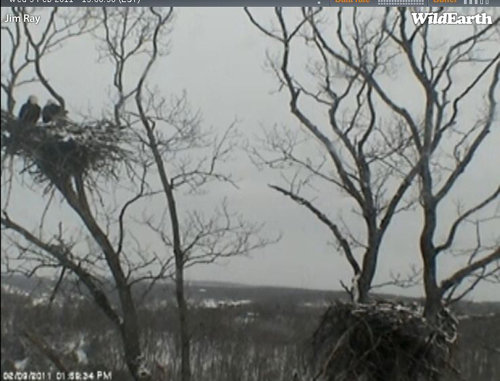
Tweet Dreams's s'cap - February 9, 2011
Based on past experience, look for eggs in mid February, chicks in late March, and fledging in mid June.
Montana
Clark Fork River
no cam
This nest on the Clark Fork River near Missoula, Montana, came to our attention in 2011, when local observer Sue Erickson reported that they were raising four chicks! She said that multiple chicks were the norm (they raised 2 in 2007, 3 in 2008 and 2009, then 2 in 2010) - but raising four is very unusual - and all four fledged successfully. They raised three chicks in 2012. No info reported since 2012.
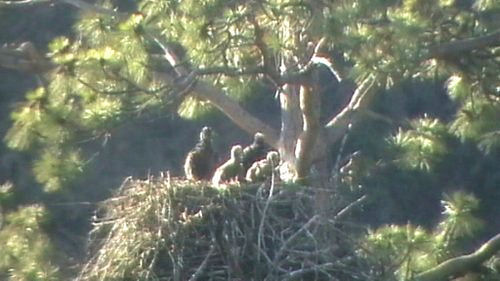
Sue Erickson's photo - May 12, 2011
©2011 Sue Erickson, permission requested, licensed under a Creative Commons Attribution-Noncommercial-Share Alike 2.5 Canada License.
Based on past experience, look for eggs in early March, chicks in early to mid-April, and fledging in mid July.
Montana
Libby Dam
no cam
Libby Dam is located on the on the Kootenai River in northwestern Montana. The nest, also known as the Souse Gulch Eagle Nest, was established in 1996, with the first eggs in 1997. From 1997 through 2008, the pair fledged 21 eaglets, including two in 2007 and two in 2008. They laid two eggs in 2009 and both hatched, but the younger chick died when it was almost 3 weeks old (not easy to guess why on a refresh cam); the older chick fledged successfully. The pair laid two eggs in 2010; only one hatched, and we believe it fledged successfully; the chick was not seen at the nest after fledging, but the adults were only seen once or twice in the two weeks before the cam was turned off, leading us to believe/hope that they and the chick were based somewhere nearer the water. In 2011 they again laid two eggs, one of which hatched and fledged successfully; the chick was seen returning to the nest for a week or so, after which the cam went down. We know that two eggs hatched in 2012, but the cam was down for a couple of weeks right after they hatched, and there was only one chick when it came back up; it went down for god shortly thereafter - the remaining chick was looking great, but we don't actually know if she fledged. We do have good news for 2013 - the Army Corps of Engineers, which runs the cam, has announced that they're installing a new cam for the upcoming nesting season. Well, the hoped-for camera hasn't appeared yet - but the ranger at the site reported that there were two chicks in 2013, and both fledged successfully. Still no cam online for 2014, but the ranger reported that they had two chicks and both fledged successfully. The pair did not use their nest in 2015, and rangers on site didn't notice another nest but also didn't actively look for one. No nesting activity was observed on the nest with the cam in 2016.
However, in 2017, it was reported on Facebook that there were two eggs laid, both hatched, and both chicks fledged successfully and were seen returning to the nest from time to time.
I did not find any information about this nest for 2018; I posted on Facebook asking about the nest in 2019, and was told that the cam is sort of working in the information center and it looked as if the eagles were nesting, and the rangers would try to post a picture if there were chicks; I didn't follow up, and they didn't post anything, so I'm dropping this cam.

JudyB's s'cap - June 20, 2008
Based on past experience, look for eggs in mid to late March, chicks in late April, and fledging in mid July.
New Jersey
Duke Farms
male is banded A59; female is not banded
"Duke Farms is a 2,700-acre estate in Hillsborough, New Jersey, and is owned and supported by the Duke Farms Foundation. The mission of Duke Farms is to be a model of environmental stewardship in the 21st Century and inspire visitors to become informed stewards of the land. This Eagle Cam was installed to provide researchers with an opportunity to monitor a pair of nesting Bald Eagles without any disturbance to the birds. It is being shared with the public to provide viewers with a glimpse of wildlife in its natural environment." (© 2009 Doris Duke Charitable Foundation. All rights reserved.)
2009 was the first year we watched this pair, and the site doesn't provide any history on them. They successfully raised and fledged three chicks in 2009, with both parents sometimes feeding at the same time from different areas of the nest, making it easier for the smallest to get a share. They laid two eggs in 2010, and both chicks fledged successfully. They laid 3 eggs in 2011; 2 hatched and both chicks fledged successfully. The cam was offline for the 2012 nesting season; a biologist with a spotting scope reported seeing a chick, and reported it fledged successfully; given the challenges involved in occasional, long-distance observation, I think it's not certain that there was only one chick. A new cam was installed for 2013, providing a side view of the nest; at least 2 eggs were laid, and two eaglets fledged successfully; there was some excitement at the nest this year - a hawk landed on the nest the day before the eggs hatched - while one of the adults was incubating. There was a brief, very fierce battle, and the adult killed the hawk - and we all held our collective breath until we saw the chicks, because the cam view didn't let us see if the eggs were damaged during the fight.
The pair laid three eggs in 2014; the cam went down shortly before the chicks were expected to fledge - we believe all three fledged successfully, but have no additional details. There were two eggs in 2015, and both chicks fledged successfully. There were two eggs again in 2016, both hatched, and Big (F)- NJ green band E41 on right leg; federal band 0709-01631 and Little (F) - NJ green band E42 on left leg; federal band 0709-01632 both fledged successfully, though the younger one accidentally fledged when 78 days old and wasn't seen again for almost a month - and both fledglings were seen on the nest two weeks after that - another instance of a fledgling who didn't return to the nest in the usual time frame but was just fine. During the middle of February 2017, when eggs are usually laid, an intruding female started making a play to replace the current female and the timing of the harassment by the intruding female interrupted the couple’s mating behavior; the couple appeared to get back together and the interloper moved away from the Duke Farms nest, but there were no eggs or chicks in 2017.
The pair laid two eggs in 2018; one of the eggs appeared to burst or collapse March 23; it appeared to contain liquid, not a chick, so probably stopped developing early on. Unfortunately the bad luck continued - I think the second egg started to hatch March 24 but the chick was unable to complete the hatching process, though there was also an intruder and the egg may have been damaged; unlike the first egg, the second contained the body of a chick that was at least close to hatching age, visible through a hole in the side of the egg. As of March 25, the egg was mostly intact, so the adults were continuing to incubate; the male removed it the next day.
The pair laid two eggs in 2019, and both hatched. Green E/87(F) (band on left leg) appeared to have an accidental fledge, and was not seen again; there was a search a few days later, and staff continued to monitor the area. Green E/88(M) (band on right leg) fledged successfully and continued to visit the nest and be fed there for another month, so I sadly think E/87 would have returned to the nest if she survived. E/88 was given a transmitter and named "Duke" for tracking purposes; he was still doing well as of the end of December - you can see his travels here - click his name at the top of the map.

JudyB's s'cap - April 21, 2009
Based on past experience, look for eggs in late February, chicks in early April, and fledging in late June or early July.
North Carolina
Carolina Raptor Center
adults Derek(M) and Savannah(F) through 2017
adults Luke and Savannah
in 2018
This nest has a refresh cam that refreshes every five seconds; it's only on during daylight hours. CRC is hoping to install an upgraded camera for the 2012 nesting season, with streaming video and possibly sound.
Derek and Savannah are non-releasable eagles who have been at the Carolina Raptor Center since 1998. They became a pair, and she laid her first eggs in 2004. They didn't hatch, but in 2006 two eggs hatched; the eaglets were taken to a hacking tower when they were 6 weeks old and subsequently fledged; they have GPS units and can be tracked at the Carolina Raptor Center Eagle Tracking Project. They had one egg hatch in 2008, and that chick was also successfully fledged from a hacking tower. No eggs hatched in 2009; they think the unusually cold weather was responsible, and responded by insulating the pair's preferred nestbox (which is on the ground). They laid three eggs in 2010; the first egg hatched and the chick is looking good; the second hatched but the chick was not strong enough to survive, and the third failed before hatching. There are five other adult eagles at CRC, and I think most of them share the enclosure with Derek and Savannah, though they know better than to come close to the nest. The 2010 eaglet, a female named Noah, was equipped with a transmitter, and she was tracked after fledging to a wilderness area in Virginia, where her signal was lost; the eaglet and the transmitter were not found, so we're hoping it's an equipment malfunction, and she'll reappear in time. The pair laid two eggs in 2011 and both hatched successfully, but sadly the younger eaglet (who had seemed smaller and weaker) died when he/she was 26 days; a necropsy was conducted but didn't determine a cause of death; the older eaglet, named Kinsey, was moved to a hacking tower with two somewhat older eaglets who had been rescued after their nest collapsed; we think being with older eaglets encouraged Kinsey to "branch" on the perches in the tower at a fairly young age, and she fledged successfully, not long after her older tower-mates. Derek and Savannah laid 2 eggs in 2012, one of which hatched; that eaglet, a female named Carolina, fledged successfully from the hacking tower - and in a switch from the previous year, once she was flying well, the staff built a shelf for her food outside the tower so they could close the doors and bring in two younger rescued eaglets who were close to fledging; they also fledged successfully, though the younger one seemed a bit intimidated by his older companion at first.
2013 was a sad year for those of us following these eagles. They laid three eggs but removed one (perhaps cracked or broken) before hatch time and another didn't hatch, so they only had one chick - and it was killed by a predator when it was about 3-1/2 weeks old; the initial reports said they couldn't identify the type of predator, or how it gained access, though they were certain it was not one of the other eagles in the aviary; later reports said it was probably a raccoon, and while they had every sort of barrier they could think of to keep the eagles in and everything else out, raccoons are very clever - and they reported that a raccoon was seen inside the aviary at night a few times in the months after the eaglet was killed, and had eluded all attempts to trap it. They removed the eagles for a time, and are installing an additional protective fence inside the aviary, so we're hoping all will go well in 2014. Unfortunately there were no chicks in 2014 - they laid two eggs; one was broken partway through the incubation period and the other failed to hatch. The pair laid three eggs in 2015 (actually in late 2014 - first egg was December 4, 4-6 weeks earlier than they'd ever laid before) but none hatched; one apparently broke shortly after the window for a hatch and the others were removed for testing and proved to be non-viable, perhaps because they did not mate successfully, or because they are getting older. Keeping fingers crossed for 2016.
Savannah and Derek had two clutches in 2016, three eggs the first time, two the second, but none of them hatched; however, they got to be foster parents for a month-old eaglet hatched by a non-releasable pair at another location which didn't have the facilities to keep a growing eaglet from being exposed to people. The eaglet named Freedom (M) was with them for almost a month before moving to a hacking tower to prepare for fledging (they didn't have the camera on, but occasional videos showed that Derek and Savannah are still great parents!). Freedom fledged successfully after about a month in the tower, and as of December 2017 has been up to Canada a couple of times - and is still checking in regularly.
The pair again had two clutches in 2017 - one of the first three may have broken and the other two were found to be not viable. Both eggs from the second clutch were removed after the last possible hatch date, and there was no sign of fertilization. For 2018, staff at CRC moved Savannah's former partner Derek to another enclosure with a male named Dante and moved Luke in with Savannah; the primary reason was aggression between Luke and Dante, but they also noted that pairs often split up after a couple of unsuccessful years. Savannah laid three eggs, but as far as we know, Luke never tended to the eggs, and Savannah was incubating less often by the first week in March; the eggs were removed March 8 and found to be infertile - not a surprise as keepers hadn't observed mating behavior.
No cam in 2019, and sad news - CRC reported on August 20 that Savannah had passed away peacefully; she was at CRC for 21 years, and they believe she was at least 27 years old. Rest in Peace, beautiful Savannah. In happier news, Freedom, Derek & Savannah's foster chick from 2016 is doing great and exploring the world.
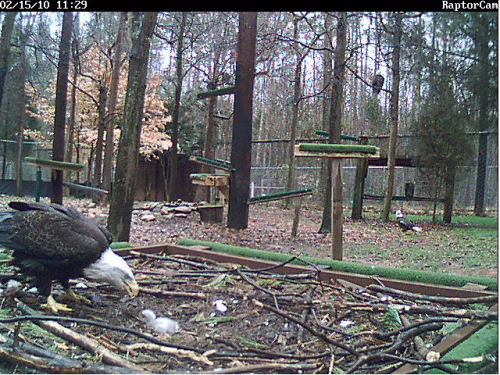
JudyB's s'cap - February 15, 2010
Based on past experience, look for eggs in early January and chicks in mid-February; chicks will likely be moved to a hacking tower around the end of March and should fledge from there in mid-May.
North Carolina
Jordan Lake
The cam is available dawn to dusk and it requires QuickTime to function properly. It provides a still picture view that refreshes automatically.
This nest is located in central North Carolina, near the urban areas of Raleigh-Durham and Chapel Hill. It's northeast of Charlotte, where the Carolina Raptor Center is located, and looks to be about half-way between Charlotte and Norfolk, Virginia. The Jordan Lake EagleCam is a collaboration between North Carolina State University and the U.S. Army Corps of Engineers Wilmington District. The goal of the project is to "stimulate interest in Bald Eagles by letting people in the triangle know that these magnificent birds are now nesting right in their backyards." The nest is situated in an area that provides many large trees suitable for nesting bald eagles with close proximity to lakes and rivers that provide a good food source!
This pair successfully fledged young in the three years before a cam was added in 2011, and successfully fledged two eaglets in 2011. The pair laid 2 eggs in 2012, and while the cam went down partway through the nesting season, a local photographer reported that both fledged successfully. They are working to develop a more stable cam for 2013. The pair laid 2 eggs in 2013; one hatched and the eaglet fledged successfully. 2014 was a sad year at Jordan Lake - the pair laid two eggs and both hatched, but there was a bad rainstorm when the chicks were about 6 weeks old and part of the nest collapsed, and both chicks fell from the nest. One died from the fall, and the other was rescued and taken to the Carolina Raptor Center for treatment of an abrasion under one wing and a broken leg; the chick's condition got worse and another round of tests found a hairline fracture on a wing that had become an open fracture and could not be repaired, so the little one was humanely euthanized. Rest in peace, little ones.
The eagles did not rebuild in that location, so there was a cam in 2015, but it was a more general wildlife cam, showcasing the various species that visit the area, including eagles. No change in 2016 or 2017.
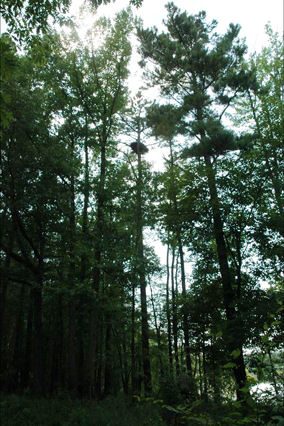
October 2010
Thanks to NC State University and US Army Corps of Engineers
Based on past experience, look for eggs in early December, chicks in mid-January, and fledging in late March/early April.
Ohio
Avon Lake
new camera for 2016
adults Stars (F) and Stripes (M)
These eagles have been nesting at the Redwood Elementary School in Avon Lake (about 20 miles from Cleveland) since the fall of 2014; it is thought that female Stars was five years old then, and male Stripes was 6 or 7. They raised two eaglets named Hope and Pride in 2015, and a camera was installed for the 2016 nesting season. The laid three eggs in 2016; all hatched, but the youngest died a few days later; the surviving chicks were named Liberty and Justice and fledged successfully. There were three eggs again in 2017, two hatched, and Maroon and Gold (named for the school colors) fledged successfully. The pair laid three eggs in 2018, and the eaglets named Red, White and Blue fledged successfully.
The pair laid three eggs again in 2018 and all hatched. R11/Lincoln and R13/Jefferson fledged successfully, but R12/Washington was knocked from the nest by an owl sortly before the other two fledged; 2 fledglings returned to the nest within a day or two and a third fledgling was seen in the nest area on July 4; the group admin believes it was the one that was knocked from the nest who was not seen after July 4, though also says the eaglets look almost exactly alike, so it's hard to tell who was where - but only two were seen at a time after that, and they continued to be seen through July. (I don't remember where I saw the numbers for the eaglets, but I believe the R is because the nest is at the Redwood Elementary School; I believe the students will name the eaglets.)
Based on past experience, look for eggs in late February.
Ohio
Sandy Ridge
no cam
new camera for 2016 - Sponsored by Lorain County Metro Parks
From the camera website: "A pair of Bald Eagles have been nesting at Sandy Ridge Reservation since 2002. They have built three nests; using the current location since Superstorm Sandy blew out a different nest in 2012. There have been four different eagles during that time. The eagle pair has successfully fledged eaglets almost every year, with the exception of 2009. That year, after the eaglets hatched, the "mother" eagle was attacked by another female eagle and never returned to the nest (she later died). The "father" eagle tried to take care of the young by himself, but couldn't keep them warm and go get food at the same time, so the eaglets perished. The male later hooked up with another female (presumably the one that killed his former mate). A couple years later, the original male disappeared during nesting season. The eaglets were half-grown. The female adult eagle called for her mate for several days, attracting the attention of “outsider” adult male eagles. She eventually accepted one of her suitors, and he helped her raise the eaglets. He was a great Step-Dad! Today we have two different adults than the pair that began nesting in 2002."
I haven't found a website or facebook thread that's focused on this nest - just occasional posts on the Lorain County Metro Parks facebook page - so details are a bit sketchy. The pair laid three eggs in 2016; all hatched, but one chick died a few days later (I think the youngest, though that wasn't clear from the website); the remaining chicks fledged successfully. There were two eggs in 2017; both hatched, but one of the chicks died a few days after the second hatch; the other fledged successfully.
I don't have all the details, but have learned that this is a very sad year here. The female was found seriously injured April 21st (initial reports suggested she might have been hit by a car but later reports said she likely died in a territorial fight with another female eage), and died shortly afterwards, and it appears that their chick was killed around 7 pm on April 22nd by an intruder trying to take over the nest. I have not been able to find out if the other egg hatched and what happened, or if there was only the one chick. Rest in peace, Mom and little one, and fly free.
There was not a cam for 2019 and I didn't see any reports; I asked about 2020, and was told that the eagles moved to a new nest that was too far from them to
Based on past experience, look for eggs in late February.
Oklahoma
Sequoyah National Wildlife Refuge
The nest is in the Sequoyah National Wildlife Refuge, near Vian in eastern Oklahoma, near the Arkansas border. This is the Sutton Center's second nest with a cam (their first features a pair that nests about 125 miles away, at Sooner Lake in north central Oklahoma). Their primary cam page shows two views of Sooner Lake and two of Sequoyah.
The pair laid three eggs in 2011, the first year with a cam, though one disappeared before the cam came online. The two remaining eggs hatched, and both chicks fledged successfully; the younger was given a GPS transmitter, and you can follow his travels here. The pair again laid three eggs in 2012, and all three hatched, but the youngest chick was significantly smaller and fell behind in development, probably because food was a bit scarce; he was holding his own, and usually getting some food - but sadly died, probably of exposure, when he was about 5 weeks old - there was a heavy rainstorm, and his older siblings had feathers to help protect themselves from the cold rain, and he still had mostly down. The pair has laid two eggs to start the 2013 nesting season, so we are hoping both hatch and thrive.
Well, 2013 was an unusual, and ultimately non-productive nesting season here. There appeared to be an intruder or intruders who disrupted the nesting starting about 3 weeks into the incubation period; adults were off the eggs 30-60 minutes initially, and eventually only incubated for a couple of hours per day; they eventually resumed incubation, but the eggs had been uncovered in freezing weather for hours at a time, and often uncovered overnight, so sadly there wais no realistic chance the eggs will hatch. One egg collapsed January 30 (52 or 49 days after laying) and the adults were last seen on the nest February 2 (and incubated the remaining egg for a while that day). Then a great horned owl started visiting on February 3, appeared to incubate the eagle egg during the night Feb 4 & 5, spent the day on the nest Feb 6 - and laid an egg Feb 7! She laid a second egg two days later, and incubated them and the remaining eagle egg. The eagle egg and one owl egg disappeared overnight Feb 15-16; the second owl egg and the owl were gone when cam came online the morning of Feb 26; as of Feb 28, the owl had not been seen, though there would be no reason for her to return to the nest if she lost the egg. The eagles have not been seen since Feb 2; both owls visited the nest the morning of March 3rd, and one was on the nest as it got dark that evening, though there's no IR, so she(?) may have left as darkness fell. A pair of osprey also visted the nest later in the spring - busy nest!
No one used the nest in 2014 - though a local observer believes the pair had a successful season, though it wasn't clear which alternate nest was theirs, so we don't know how many chicks they raised.
2015 was a sad year - we think there may have been a new pair (chatters felt the female did not look like the one from previous years, and the male seemed very tentative the first few times he tried to incubate
their two eggs); I focused on other nests once the eggs were laid and things looked OK, but when I checked back after a couple of weeks, it appeared that only the female was incubating the eggs; the male was in the area, and would come to the nest some of the time when the female left, but we didn't see him bring food or tend to the eggs, which were left uncovered (often for long periods of time, given the chilly weather) while the female was off getting food.. Against all odds, the first egg began hatching but couldn't complete the hatch process and was removed from cam view by the male; it looked as if there was a pip in the second egg, and I'm hoping the hatch process had stopped before the female abandoned the nest. I know new/young pairs often don't get all the necessary skills in the right sequence initially, so am hoping for a better year in 2016.
Rest in peace, little almost-chicks.
The nest cams failed in 2016, but they reported at least two chicks; I haven't been able to find out if they fledged. There were two eggs in 2017, one hatched, and that chick fledged successfully. There were two eggs in 2018 and both hatched successfully; the camera went down several weeks later, and Sutton Center reported that the problem was in the tree so could not be fixed during the nesting season; they said that unless there was a bad storm that damaged the tree, the eagles should be fine from this point forward, so keeping fingers crossed. The pair again laid two eggs in 2019; one hatched and that chick fledged successfully.

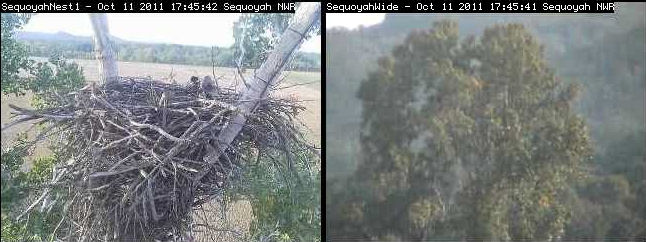
JudyB's s'caps - Feb 10, 2011, and Oct 11, 2011
Based on past experience, look for eggs in late December/early January, chicks in early February, and fledging in mid April.
Oklahoma
Sooner Lake
no cam
This nest has streaming video with one cam mounted above the nest, and the other at a distance looking up at the nest in its tree.
The nest is on Sooner Lake, near Stillwater in north-central Oklahoma. This pair's former nest was on an artificial tower erected by the Sutton Avian Research Center and local utility OG&E to replace the original dead nest tree used by this pair after it fell down. The pair first built a nest in the dead tree in 1995, and laid their first eggs in 1996. Since then, they've fledged 24 eaglets, with three eaglets in 2000 and 2002. 2008 was the first year they've known how many eggs were laid; they do know that three eggs hatched in 2007, but the youngest chick was unable to compete for food with its older siblings, so only two of them fledged. There was an unusual clutch of four eggs laid in 2008, but the cam was down for a month shortly after they started to hatch, so we don't know how many of them hatched; there were two eaglets when the cam came back, and both fledged successfully. They laid three eggs in 2009, but only one hatched; the eaglet fledged successfully. In 2010 the pair did some preliminary work on two alternative nests, eventually choosing one in a tree near the lake. This proved to be a bad choice; they laid three eggs, two of which hatched; the younger chick died two days after hatching when it was blown across the nest in heavy winds and slipped through a hole in the edge; the older chick died when it was a little over a month old, most likely by losing its balance as it learned to stand upright, and slipping over the edge. As far as we know, they didn't nest in 2011; they are still seen at the platform in the lake, so we're hoping they may nest in 2012. The pair again nested in the dead tree in 2012, and laid three eggs, two of which hatched; the older one died when it was about a week old, possibly after being stepped on by one of the adults; the remaining chick fledged successfully. The dead tree blew over in mid-December, happily at a time when there were no eggs or chicks present, and the adults appear to be turning their attention to the artificial nest they used before. The pair used the artificial nest in 2013, and had laid 4 eggs by the time the cam was streaming there; all hatched, but the fourth died shortly after hatching, and while the 3rd was only 2 days younger than the others, there was some fairly intense rivalry and some very cold weather, and he died less than a week after hatching; the other two fledged successfully.
The pair used an alternate nest in 2014, and Chat member "nesty" reported that they fledged two eaglets.
2015
was another unusual year - a local observer said it looked as if the pair was using an alternate nest as of mid-February (and I'm not sure how that worked out), and then someone laid an egg on the platform nest on March 26 (over a month after eggs are usually laid), though there was only a minimal amount of incubating before it was abandoned; folks at the Sutton Center said that there was a failed nest attempt attempt about a mile away earlier in the spring, and that pair might have been starting a second clutch, but didn't carry through because of the lateness of the season. They said the egg might also have been laid by a young female not yet ready to complete a nesting season. It is amazing what we are learning from these cams!
As of fall 2017, I found some mention of eagles seen visiting the platform, but no indication of any nesting activity. No cam and no reports in 2018 or 2019.
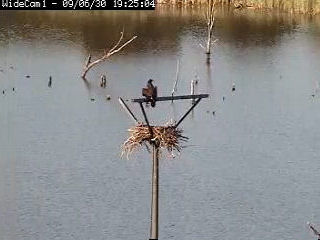
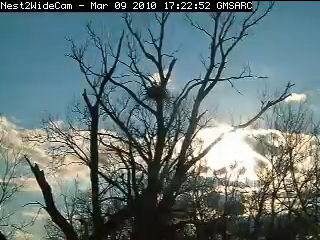
JudyB's s'caps - earlier nest June 30, 2009 and current nest March 9, 2010
Based on past experience, look for eggs in early February, chicks in mid March, and fledging in late May or early June.
Oregon
Deschutes
This is a streaming cam with a 3-minute limit; there's a brief intro before you get to the cam.
This is a streaming cam with a 3-minute limit; there's a brief intro before you get to the cam.
The cam is located in Willamette Pass in Deschutes National Forest in central Oregon. The Deschutes National Forest Bald Eagle Cam is provided by the Oregon Zoo, AT&T, the National Fish & Wildlife Foundation, and the USDA Forest Service's NatureWatch Program. The area was first identified as an occupied territory in 1974, and has been successful in producing fledglings in 21 of the years since then. They raised one chick in 2006, and had early nest failures in 2007 and 2008. They laid one egg in 2009 (I don't actually remember any other pairs that laid only one egg in a nesting season), and it hatched, and the eaglet fledged; the eaglet (named Pengra Cescent) did not return to the nest after fledging, but two adults and a juvie were seen flying in the area a few days later, so we're optimistically assuming it was Pengra and her parents. The pair laid two eggs in 2010, but there was a series of heavy snowstorms during the incubation period, and while they made an amazing effort to keep the eggs warm and dry, the eggs did not hatch. 2011 was a very snowy year, and as far as we know the eagles did not nest, though they were seen in the territory. They also did not nest in 2012, as far as we know, and we haven't had any additional updates or seen activity at the nest.
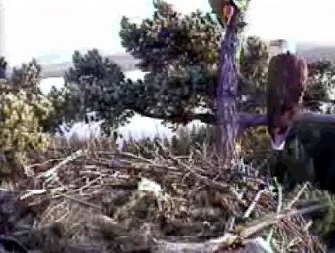
Marcia's s'cap - July 25, 2008
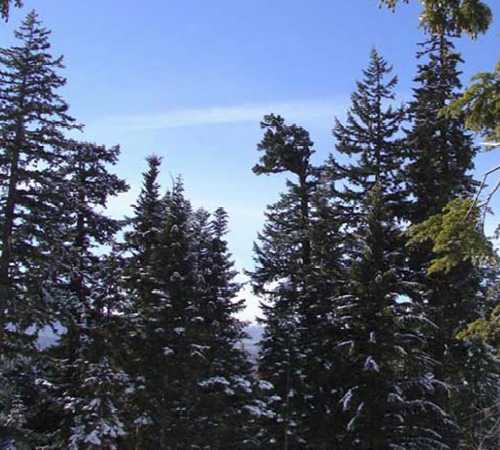
Thanks to the USDA Forest Service for making this copyright-free picture of the nest
taken January 2010 during camera installation available for non-commercial use.
Based on past experience, look for eggs in mid-April, chicks in late May, and fledging in mid to late August.
Pennsylvania Codorus State Park
Hanover
new cam for 2015
adults Freedom (M) and Liberty (F)
The Pennsylvania Game Commission apparently had a trial webcam on a different nest, then moved here for the 2015 nesting season. The cam is a bit north and a ways inland from the Blackwater nest in Maryland - but may be close enough to Chesapeake Bay to be an early nest. The initial press release didn't provide any background on the eagles - so we have much to learn here!
2015 was a good year here - the pair laid two eggs, and in spite of enough snow that we had trouble telling which bump was the incubating female, both hatched and fledged successfully. 2016 was a sad year - they laid two eggs, one hatched - and we don't know why, but the chcik died two days later. 2017 was better - they laid two eggs, both hatched, and H3 and H4 fledged successfully.
2018 was another hard year. One of the three supporting branches for the nest broke off last summer, squirrels were seen removing material from inside the nest, weakening it structurally, and the bottom half of the nest fell away in November - so we started the nesting season not knowing if the nest would survive, assuming the eagles decided to use it. They chose to use it, built it up, and it survived several bad storms. They laid two eggs - and as hatching time approached, at least one and possibly two other eagles challenged them for the territory. I believe the last confirmed sighting of female Liberty was March 17; there was a report of an injured eagle in the area but rehabbers were unable to find the eagle when they arrived to try to rescue him or her; the cam was down March 18 and part of March 19; when it returned, the adults were leaving the eggs untended for 20 minutes at a time (unusual for this pair) - we had known there were potential intruders in the area, and saw at least one come to the nest and be fended off by Dad Freedom. As time went by, observers realized there was only one adult tending the eggs and agreed it was Freedom, and he did a great job, staying with them through a major snowstorm for almost 30 hours, after which he had to leave to take care of his own needs; he was away for about an hour in the late afternoon of March 21, and returned to find snow covering one egg - and left again, and snow covered both eggs. The intruder/possible new female ate the no-longer-viable eggs on March 22, I think in the late afternoon. Observers believe she and Freedom are both being seen at the nest, and may be starting to form a bond; not sure why, but she is being called Lucy. And then, at the end of March and beginning of April, observers were beginning to see an eagle that looked like Liberty on the nest - and it was confirmed April 7 or 8 that she was back, though I think Lucy was still being seen in the area initially. In the end, it appeared that Liberty regained her nest.
2019 was better. Freedom and Liberty laid two eggs and both hatched; older eaglet Stars made an accidental fledge when s/he was knocked off the nest on June 18; he or she returned to the nest 5 days later, on June 23; younger eaglet Stripes fledged intentionally on June 30th; part of the nest collapsed on August 2; both fledglings were on the nest, and were OK.
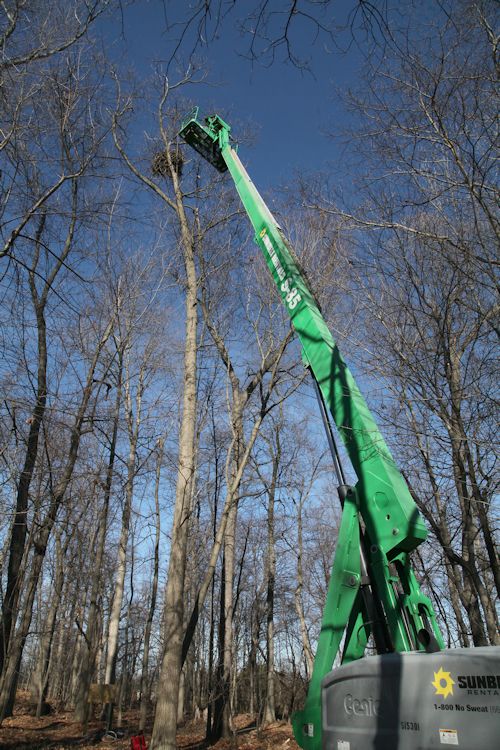
© Pennsylvania Game Commission, all rights reserved
Based on one year's experience, look for eggs in mid-February, chicks in late March, and fledging in mid June.
Pennsylvania
Harmar
new cam for 2016
Like the Pittsburgh Hays cam, this cam located north of Pittsburgh is a project of the Audubon Society of Western Pennsylvania in conjunction with PixController and a number of local sponsors. The cam is looking up towards the nest, so most dates are based on interpretations of observed behavior. We don't have a lot of history beyond knowing the pair fledged one chick before the cam was installed.
There were two eggs in 2016, both hatched, and both chicks fledged. 2017 was a repeat - there were at least two eggs, two chicks hatched, and HR4 and HR5 fledged successfully. There were two eggs again in 2018, and HR6 and HR7 fledged successfully. The pair moved to a new nest for 2019 so no camera, but a local observer/photographer documented the nest on Facebook, so we know that the pair had two chicks and HR8 and HR9 fledged successfully.
Based on past experience, look for eggs in early March.
Pennsylvania Pittsburgh Hays
Hays is a neighborhood in Pittsburgh, and lies southeast of the center of Pittsburgh along the Monongahela River. The nest is on a steep, wooded hillside overlooking the river. The pair reared one young chick in 2013, which was the first successful eagle nesting in the city in more than 200 years, according to game commission officials. The pair successfully raised three chicks (H2, H3 and H4) in 2014. The pair only laid two eggs in 2015, and neither of them hatched; one broke at about 3-1/2 weeks and the other collapsed at around 5 weeks - neither was viable. There was some miserable weather early in the incubation period which might have been a factor - host PixController reported that they received a very interesting message from one of their Facebook fans Susan Shearer. This was her message: "Wanted to give you some info I got from the Raptor Education Center that may be the reason the eggs failed...On Feb. 24th mom stood up and steam came off the nest ..after that the color of the eggs changed ...out of concern I messaged the Raptor center sent them pics of the eggs before the incident and after ..also sent them video of the steam coming off..they had concerns that there was too much moisture and that could cause bacteria that would harm the eggs being they were just a few days old...This makes sense to me." Hoping for a better year in 2016.
The pair laid three eggs in 2016, two hatched, and H5 and H6 fledged successfully.
2017 - well, this may be one for the record books. The pair laid their first egg February 10 - and two days later, on the evening of February 12, the nest tree was blown over during a windstorm. The camera caught the female flying to safety as the tree fell, and by the 15th, they were hard at work on a new nest - and on the 19th, they appeared to be incubating an egg! It hatched - and H7 fledged successfully.
The pair laid three eggs in 2018; one of the eggs was discolored, and broke after about 4 weeks; one of the remaining eggs hatched, and H8 fledged successfully. There were three eggs again in 2019; the first one didn't hatch, but the others produced H9 and H10, and they fledged successfully.
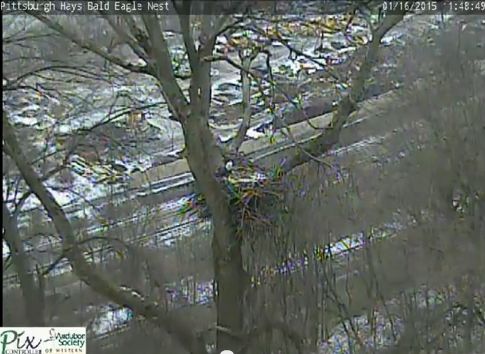
© Pix Controller, all rights reserved
Based on past experience, look for eggs in mid-February, chicks in late March, and fledging in mid to late June.
Tennessee
Dale Hollow
new cam for 2017
adults named Obey (M) and River (F) after the Obey River
The Obey River is the main tributary that forms Dale Hollow Lake and runs the full length (almost 50 miles) of the reservoir from the headwaters to the confluence with the Cumberland River below Dale Hollow Dam. This Eagle's Nest is located on Dale Hollow Lake, a 30,000 acre reservoir located on the Kentucky-Tennessee state line.
This nest and its human sponsors had a challenging first year - the pair laid three eggs, and all hatched - and the youngest one was really feisty and tried really hard in spite of bad weather, scarce food, and major sibling rivalry - but sadly did not survive; DH1 and DH2 fledged successfully. There were two eggs in 2018 and both hatched, but older chick DH4 died four days after hatching; the cam operators said he or she might have been accidentally injured by one of the adults, or may have had some health issue - rest in peace, little one. DH5 had an accidental fledge when s/he slipped from a branch during the night, perhaps after something startled him/her, but did fine afterwards and was seen in the area for another month.
The pair laid three eggs in 2019, and DH6, DH7 and DH8 all fledged successfully and were seen returning to the nest for another month.
Based on past experience, look for eggs in mid-January.
Tennessee
East TN State U
Bluff City
new cam for 2016
adults named Eugene (M) and Frances (F) after the wonderful property owners
East Tennessee State University has eagle cams at two locations - Johnson City (JC) and Bluff City (BC) - both cams set up in November 2015 by the Department of Biological Sciences; the cams are both in the Northeast corner of the state of Tennessee, so both are in the eastern time zone. The ETSU Bluff City Nest is located on private property along South Holston River, and 2016 is the 5th year this pair of Bald Eagles has nested here.
They laid two eggs in 2016, one hatched and BC9 fledged successfully. They again laid two eggs in 2017, both hatched, and BC10 and BC11 fledged successfully. The pair moved to a new nest in 2018 so there was no cam, but local observers reported that they fledged two eaglets. There was a cam on the new nest for 2019, and they laid two eggs, and BC14 and BC15 fledged successfully.
Based on past experience, look for eggs in early to mid-February.
Tennessee
East TN State U
Johnson City
new cam for 2016
adults named Noshi (M) and Shima (F) (father and mother in Algonquin)
East Tennessee State University has eagle cams at two locations - Johnson City (JC) and Bluff City (BC) - both cams set up in November 2015 by the Department of Biological Sciences; the cams are both in the Northeast corner of the state of Tennessee, so both are in the eastern time zone. The ETSU Johnson City nest is located on private property on Boone Lake in Johnson City, TN. 2016 is the 4th year this pair of bald eagles has nested at this site; in the past, they have successfully fledged 2 eaglets each year.
The pair laid two eggs in 2016, one hatched, and JC7 fledged successfully. They again laid two eggs in 2017, both hatched, and JC8 and JC9 fledged successfully. The pair laid three eggs in 2018, and JC10, JC11 and JC12 fledged successfully. There were three eggs in 2019; two hatched, and JC13 and JC14 hatched successfully.
Based on past experience, look for eggs in early to mid-February.
Tennessee
Harrison Bay
Adults Elliott (M) and Eloise (F) (through 2016)
Adults Elliott (M) and Eliza (F) 2017
adults
Elliott (M) and Athena (F) from 2019
According to records on the Harrison Bay Eagle Cam site, the nest is on the edge of a golf course, and is near the top of a 75-foot tall pine tree. The site also notes that the pair first nested in 2011, producing eaglets HB1 and HB2. They laid two eggs in 2012 and at least one hatched, but neither chick survived the hatching process. There was a camera in 2012, but I'm not sure if it was streamed to the web. 2013 was the first year I was aware of the cam, and Eloise and Elliott laid two eggs, and HB3 and HB4 fledged successfully.
The pair laid 2 eggs in 2014, and HB5 and HB6 fledged successfully - but HB5 had a bit of a detour on the way; he or she may have had an accidental fledge on May 26 when only 72 days old, and made it back to the nest, but went missing the next day and was found on the ground behind a building with several lacerations on one wing and a swollen elbow, but no broken bones; he/she was in rehab for about a month, then was released back in the nest area, when an observer reported seeing the two fledglings flying together.
2015 was a more peaceful year - the pair laid two eggs, and HB7 and HB8 fledged successfully without any detours.
2016 was similar - two eggs, two chicks, and HB9 and HB10 fledged successfully.
As of spring 2017, female Eloise has not been seen since September, and there's a new female in town, now named Eliza, who is working with Elliot on nesterations; unfortunately the cam went down in January, so I'm not sure what happened, but didn't see any indications that anyone had seen chicks or eaglets.
In 2018 it was reported that Eloise died on January 14 (no details provided beyond that her body was found); at least four other females have spent time with Elliott as of March 26, but there doesn't seem to be a nesting pair this year. Eliott and his new mate Athena laid three eggs in 2019; the cam went down before they hatched, and local observers reported seeing two chicks, and said that HB13 and HB14 fledged successfully.

© Harrison Bay Eagle Cam, all rights reserved
Based on past experience, look for eggs in mid-February, chicks in mid-March, and fledging in early to mid-June.
Tennessee
Pigeon Forge
adults Liberty (F)and Justice (M) thru 2010
adults
Independence (F) and Franklin (M) 2011-
adults Isaiah (M) and Mrs. Jefferson (F) 2014-
adults Eleanor (F) and Roosevelt (M) 2017-
adults Grant (M) and Glenda (F) 2018-
Liberty and Justice are a pair of non-releasable Bald Eagles cared for by the American Eagle Foundation (AEF) - female Liberty can only see out of one eye so lacks the depth perception needed to hunt in the wild, while male Justice was found with shotgun pellets in a foot and wing, resulting in permanent injuries that would keep him from hunting successfully. They bonded as a pair in 1993, and have successfully raised 14 of their own offspring and several foster chicks for release to the wild from hacking towers in Tennessee. Their three eggs were infertile in 2005; bad weather caused the collapse of their nest and loss of three eggs in 2006; and the one egg Liberty laid in 2007 was infertile - but in 2008 one of the two eggs she laid hatched, and Liberty and Justice successfully raised the resulting eaglet. They laid three eggs in 2009 but none hatched. The eagles were not on cam in 2010; it was reported that they laid two non-fertile eggs, and then fostered two three-day-old eaglets; there was a report on the AEF website that two eaglets were released from the AEF hacking tower in July, though it wasn't clear if they were the two Liberty and Justice had raised.
Perhaps because of Liberty and Justice's advanced age, AEF decided to feature a new pair on-cam in 2011, Independence (F) and Franklin (M). Both are originally from Alaska, and both are non-releasable because of wing injuries. Independence came to the AEF facility in 1994, and Franklin arrived in 1995; they became a pair in 2000 and laid their first eggs in 2002. In 2011, their first year on cam, they laid three eggs, all of which hatched and the three eaglets were successfully released from a hacking tower; the first egg was moved to an incubator shortly after it was laid, due to a tornado warning, and returned to the nest several weeks later; perhaps because of the more consistent artificial incubation, it hatched 6 days before the second egg and a whole week before #3; fortunately there was plenty of food, and all three chicks thrived. Independence and Franklin again laid 3 eggs in 2012, and all three hatched; the chicks were moved to a hacking tower, and all fledged successfully, though it took two tries for the oldest one - she had some rocky landings on her first flight, resulting in an abrasion on the bottom of one foot, so she was returned to AEF for treatment, and finally released about 45 days after her siblings. Franklin and Independence laid two eggs in 2013, and eaglets Thunderbird (M) and Destiny (F) fledged successfully from a hacking tower.
2014 was a puzzling year - Franklin and Indy's eggs were moved to an incubator (and replaced with imitation eggs) so work could be done on their enclosure which had been damaged by a windstorm; the eggs were candled and appeared to be infertile or non-viable - so fertile eggs from other pairs were placed with them as the time for hatching drew near. The first egg hatched March 31 - and the chick was seen lifeless with no obvious cause the next day. The second egg hatched April 2 - and the female killed it. AEF said ""Sometimes there are no answers, and this is one of those times." Indy had successfully raised 29 eaglets, and I know one of her eggs spent time in an incubator in 2011, and she accepted it back without any problem; she may have been hit by a falling branch or something in the storm - but there was no sign of serious injury. The third egg was removed and replaced with a wooden egg; it hatched in an incubator and was successfully fostered with bald eagle pair Hero and Volunteer, and fledged from the hacking tower as H4/Hallmark (F). The cams were switched to the habitat of a different non-releasable pair in mid-April, so we could watch Isaiah (M) and Mrs. Jefferson (F) raise their two chicks. J4/Lady Talon and K4/Battle Force went to the hacking tower with H4/Hallmark, and all fledged successfully.
Because of the nature of the work the American Eagle Foundation does, things happen at their nests that wouldn't happen elsewhere - and some of that is amazing, so I'm going to do another long update for 2015. The cams were on Franklin and Independence (Indy) again in 2015. They laid three eggs - one broke while they were moving a large stick and the other two didn't hatch and were found to be underdeveloped and infertile, as was the first one - but they ended up fostering a chick that hatched from an abandoned egg produced by Isaiah and Mrs. Jefferson, which was found on the ground a couple of months earlier; although it had gone untended for some period of time, it was put in an incubator - and hatched 36 days later, on May 6! The chick was fostered into Frank and Indy's nest on May 15, so it did appear a bit big for the broken egg shell that was left on the nest as if it had just hatched; that chick, nicknamed "Little E" thrived (which does suggest that Franklin and especially Indy were back to normal after whatever happened last year) and successfully fledged from the hacking tower as L5/Miracle.
But there's more -
Isaiah and Mrs. Jefferson weren't featured on cam this year - but AEF reported that their enclosure was damaged during a windstorm, disrupting their incubation activities, so their 4th and 5th eggs for the season were removed and placed in an incubator, and when they hatched, they were fostered with a pair of golden eagles whose own eggs were non-viable. (I'm not sure what happened to their first three eggs, but do know one of AEF's mission is to increase the eagle population in the area, so they may have moved them to an incubator so the pair would lay a second clutch.) Anyway, it sounds as if the egg that became Little E came from that clutch, and at least one of her(?) siblings was in the hack towers at the same time, and that eaglet, named Hope, also fledged successfully.
My notes for 2016 just said that Franklin and Indy laid three eggs, none of which hatched, and Isiah and Mrs. Jefferson also laid three eggs which didn't hatch; AEF fledged 5 eaglets, two raised by Honor and Braveheart and one raised by Freedom and Faithful Spirit (though it sounds as if those pairs weren't necessarily the parents), and the other two from other places.
Franklin and Indy laid three eggs again in 2017; one collapsed and the others weren't viable. Isiah and Mrs. Jefferson also laid three eggs; one was lost and the other two weren't viable. Eleanor and Roosevelt laid two eggs which did hatch, and ER2 and ER3 were moved to the hacking tower at the usual time, and probably fledged successfully.
2018 was the first year as a pair and the first year on cam for the non-releasable pair Grant and Glenda, who met each other and developed an attraction in the Pick-a-Mate section at the AEF facility. They laid two eggs, one of which broke and the other didn't hatch. Isaiah and Mrs. Jefferson laid three eggs, and happily one of them hatched and MJI16/Sequoyah (likely male) fledged successfully from a hacking tower.
Grant and Glenda laid one egg in 2019, and GG2/Awohali (wing tag A19) fledged successfully. Isaiah and Mrs. Jefferson, both of whom are blind in one eye, and therefore non-releasable, laid three eggs in 2019, none of which hatched. Per AEF, Mrs J has glaucoma and is receiving eye drops; they are hoping she'll recover to the point she doesn't need them, but will keep her in a quiet place where she can be treated if that doesn't happen; Isaiah had a growth near his non-functioning eye that is being treated; they hope the pair will be back together soon. Off-site pair Hope & Volunteer produced eaglet "Parker's Hope" who was released June 21, 2019, with tag H19, and off-site pair Freedom & Faithful Spirit raised eaglet "Trilliam" who was released June 28 with tag J19.
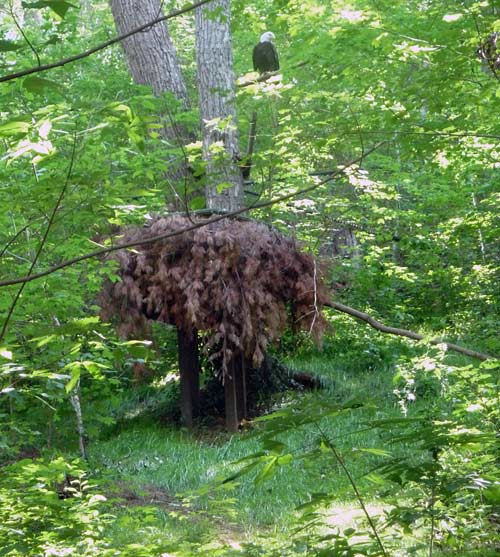
Franklin & Independence's nest
© American Eagle Foundation, all rights reserved
Based on past experience, look for eggs in late March, chicks in early May, and fledging in mid to late July. The chicks will be removed from the parents at about 5 or 6 weeks of age and transferred to a nearby artificial nest in a hack tower, where they will be released a few weeks later as part of the American Eagle Foundation's captive release program.
Tennessee
Smoky Mountain
(near Pigeon Forge)
an American Eagle Foundation nest
adults Sir Hatcher (M) and Lady Independence (F) through 2017
adults Sir Hatcher II(M) and Lady Independence (F)
Lady Independence was hatched and raised by Franklin and Independence and released from a hacking tower in 2008; this wild pair has a nest about 5 miles from the Pigeon Forge/Dollywood complex.
They raised three eaglets in 2016 and all fledged successfully. They moved to a new nest for 2017; AEF was planning to install a cam, but there doesn't seem to be information available about the 2017 season.
There's a new male for 2018, being called Sir Hatcher II; we don't know what happened to the original male - but thanks to the AEF we do know that "the new male, now approximately 6 years old, was brought to AEF in 2012 because he failed to fledge from his wild nest located in Marion County, TN. The eaglet was placed in AEF’s Douglas Lake hack tower and was released at approximately 14-16 weeks old. The eaglet was named Chattanooga at the time of the release, he was given patagial tag of B2 and USFWS band # 629-43867. To continue honoring the contributions of Bob Hatcher to the restoration of the Bald Eagle in Tennessee, the new male will be named Sir Hatcher II."
A couple of fish with line and hooks were brought into the nest on April 22 and 23, and AEF put in the necessary requests to go into the nest to remove the fishing gear; unfortunately when their climbing team reached the nest on the morning of April 24, they discovered that middle chick SM15 had fishing line hanging from his/her beak; the chick was removed from the nest and taken to a local vet for x-rays, which showed that s/he had swallowed a hook and it was lodged in the chick's stomach; the eaglet was taken to the UT Vet School where th hook was removed, and he or she was returned to the nest on April 25. Unfortunately the adults continued to bring fishing line and hooks along with fish for the chicks, so the chicks were removed from the nest on May 22 and transferred to AEF's Hack Tower at Douglas Lake, where SM14 - L18/Luna (likely male),
SM15 - P18/Phoenix (possible male) and
SM16 - N18/Nova (likely female) fledged successfully.
AEF initially thought this pair did not lay eggs in 2019, but later discovered that they had a new nest and reported that they fledged two eaglets; they will try to put cams in both nests for 2020.
Texas
Seagoville
Eagles have been nesting in the John Bunker Sands Wetlands since 2011, and 2015 was their first year on cam. And in the process of finding a photo of the nest, I watched the video by Oncor Energy of them moving the whole arm with the nest from an active power line several miles away to this tower in a much safer location, built just for the eagles - and the eagles moved in! Unfortunately they've been having issues with the cam, and it went down shortly after the eagles laid their egg(s). We do know there was at least one egg, and at least one chick, and that chick fledged successfully - and they have repaired and upgraded the cams, so we're hoping to be able to watch more of the process in 2016.
Well, there were tornadoes in the area in December 2015 and they damaged the cam system - the nest and eagles are fine, but it was too close to nesting to work on the cam. Observers reported two chicks who fledged successfully. We were actually able to watch in 2017 - two eggs again, both hatched, and JBS8 and JBS9 fledged successfully.
There was one egg in 2018; it hatched and JBS10 fledged successfully. The pair laid two eggs in 2019, and JBS11 and JBS12 fledged successfully, though the cam went down before the chicks hatched.
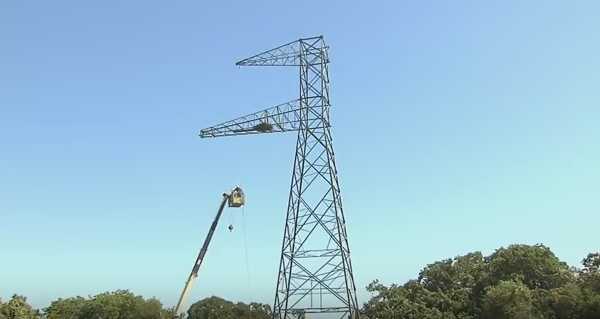
Photo from the video of the moving of the nest, courtesy of Oncor
Based on past experience, look for eggs in late January or early February, chicks in mid-March, and fledging in early to mid-June.
Texas
Webster
no cam
Cam not streamed but good video coverage on Facebook
2018 was the first year I followed this pair, and they laid two eggs, and Tex and Yellow Rose fledged successfully. There were two eggs in 2019; one hatched, and Ranger fledged successfully.
Based on past experience, look for eggs in mid December chicks inlate January, and fledging in mid April
Virginia
Norfolk Botanical Garden
no cam
This was a streaming camera with night vision (but not sound - it's near an airport so it's felt we'd hear more planes than eagles).
The nest is in a botanical garden in Norfolk, Virginia. The 2007 nest fell apart after the last chick fledged, and the eagles built a new nest for 2008; Norfolk Botanical Garden (NBG) moved the cam to the new nest. This pair successfully raised 3 chicks in 2006 and 2007; in 2008, practically everything that could go wrong did - they produced 2 (or maybe 3) eggs, but then a four-year-old female started harassing the pair, forcing them from the nest for prolonged periods and leaving the eggs uncovered; eventually the parents appeared to abandon the nest, and two no-longer-viable eggs were recovered. Then the original female returned to the nest and was seen mating with the male - and a month or so after the initial clutch, they produced two eggs - which were apparently broken when the nesting parent jumped up to respond to a large bird (maybe a great horned owl) flying near the nest. The next day she laid the third egg of the second clutch - which successfully hatched. When the chick was about 3 weeks old, a photographer noticed a growth on its beak - and the chick was removed from the nest a few days later for testing; the eaglet (named Easter on the Hancock forum and Buddy and Poink on others) was found to have Avian Pox and was taken to the Wildlife Center of Virginia (WCV) for treatment. The treatment was successful, but Easter/Buddy's beak was damaged by the pox, and in August 2009 WCV declared that he was non-releasable, “based on a review of the bird’s treatment over the past 15 month, evaluation of the curvature of the eagle’s beak, and the habituation of this young bird to humans.” His beak will continue to need periodic trimming for the rest of his life, and after considering several options WVC made the juvie, now officially named Buddy, one of their educational birds. 2009 was a much less eventful year; the eagles moved back and rebuilt their former nest, and successfully raised three eaglets. The middle eaglet, nicknamed Azalea, was fitted with a transmitter, and you can follow her travels at http://eagletrak.blogs.wm.edu. The pair again successfully raised three eaglets, all male, in 2010; the oldest was nicknamed Camellia and given a transmitter (same link for updates). It will be interesting to compare his travels with those of his older sister. The eagles are building a new nest for 2011, and NBG has moved the cam so we'll be able to follow the activity in 2011.
The pair again laid three eggs in 2011, all of which hatched. The female was struck and killed by an airplane landing at the adjacent airport when the chicks were about 6 weeks old; it was estimated that she was about 15 years old, and the current pair had been together since 2003, raising 19 eaglets including the three on the nest when she died. The experts involved with the nest felt a single adult would not be able to both feed and protect three rapidly growing eaglets, so all three were removed from the nest and taken to the Wildlife Center of Virginia. The three were released in late July, but the middle chick NX, who was fitted with a transmitter shortly before release, seemed too hot and tired to get good height, so was captured and returned to WCV to recover, and was successfully released a month later; you can follow her travels at http://www.wildlifecenter.org/wp/tracking-nx/. The male was seen with a new female, estimated to be 5-6 years old, in the fall of 2011, so we are hoping the new pair will nest in 2012.
2012 was a sad year for Norfolk. The male's new mate died after flying into power lines, and then several other females spent time courting the male, and occasionally fighting with each other. By the time the male appeared to be bonding with female #4, it was too late for nesting. We enjoyed watching them, and hoped for chicks in 2013 - but unfortunately the USDA Wildlife Service recommended that the nest be removed to reduce the chance of another eagle-airplane collision, and that was done on October 4, 2012. The pair immediately started building two other nests, in trees the male had used before - and after they were well underway, they were also taken down, and some supporting branches were removed, to make it harder for the eagles to rebuild. We are all hoping that the eagles find a tree on private property away from the Botanical Gardens where they can nest safely, out of the public eye. On a personal note, I visited the Norfolk Botanical Garden a couple of days after the nest was initially taken down - my comments and pictures are here - http://www.judybmaine.com/travel/2012_midatlantic/norfolk_2012.htm
As of November 2013, Dad Norfolk and his mate continue to be seen at the Botanical Gardens, and the USDA continues to remove any nests they try to build, and to harrass them in other ways to try to drive them out. It's not working - and it's so very sad. 2014 was much like 2013 - but with luck 2015 will be better - we heard in late October 2014 that Dad Norfolk and his lady have been working on a new nest on private property outside of the Norfolk Botanical Garden - in a place where they should be safe from harassment.
2015 was a wonderful year - Dad Norfolk and his mate successfully raised and fledged a chick from the new nest - and we learned that his mate is not the dark-tailed young female who was with him initially at the NBG - her bands identify her as HE, his offspring from 2009, and a strong young eagle also carrying Mom Norfolk's genes!
And terribly sad news as we get ready for the 2016 season - Dad Norfolk's mate HE died January 6, apparently the result of a collision with a motor vehicle. I'm glad she had the chance to mate and produce a chick - and so sorry that there was only one. Rest in peace, HE, and fly free forever, far beyond the sky.
Update -
there was no indication that Dad found a partner or nested in 2016; he was occasionally seen with another eagle, and spent time at his nest, but nothing definitive - maybe next year.
According to reports from local observers, Dad lost his nest to two young eagles in 2017 - and though they looked young, they raised three chicks! I saw a report that one had fledged and the others looked close, though I didn't see an announcement of when the others fledged. And exciting news as we prepare for the 2018 nesting season - it looks as if Dad is back with a mate, and they've taken back the nest! Observers reported that Dad Norfolk and his new mate Lady Jane had two chicks in 2018; I didn't see any report that they'd fledged (though wasn't following closely), but assume I would have heard if there had been bad news. Dad and Lady Jane had three chicks in 2019 and all fledged successfully.

EmtyBelfry's s'cap - January 12, 2009

Dad Norfolk in his new nest, October 30, 2014
© Mike Inman, used with permission, all rights reserved,
may not be reproduced or reposted without permission
Based on past experience, look for eggs in the first half of February, chicks in mid-March, and fledging in early June.
Virginia
Richmond
The Richmond nest territory was established in 1996 and the cam was installed in 2012. The cam began operating for the first time on January 15, 2012. Eagle history: This pair built a nest along the James River 90 feet up in a loblolly pine in 1995. They abandoned the first nest and built the current nest in 2001. The nest has been used for 10 years and 18 chicks have successfully fledged. In 2011 2 eaglets fledged. The pair laid two eggs in 2012, and both fledged but it was touch and go for a while as fishing was hard after a major storm, and the sibling rivalry was brutal. It appears that the pair is building a new nest for 2013, about 1/2 mile from their 2012 nest - and unfortunately not in a location where a cam is possible, at least for 2013. Hopefully there will be some ground observer reports. Two chicks were seen in the nest during an aerial survey March 11, but only one was seen in the second survey on May 4-5; the remaining chick appeared to be about 8 weeks old and doing well - but I could find no report on whether or not it survived to fledge. (I'm guessing it did - but that's not proof.)
Based on past experience, look for eggs in mid-February chicks in mid-March, and fledging in early to mid-June.
Virginia
River Farm
adults George (M) and Martha (F)
This was a new nest for us in 2014. The pair laid three eggs, but one was broken, perhaps by the adults bringing in a large partly-frozen rabbit in anticipation of a hatch; the other two eggs hatched, but the older chick died when he or she was a few days old, perhaps because it was a cold and snowy night and s/he was partly exposed or perhaps because of some underlying issue; the remaining chick fledged successfully but never returned to the nest as most (but not all) chicks do - so we are hoping for the best.
Unfortunately 2015 was even sadder - there were two eggs, but the first chick barely survived the hatching process, and the second egg didn't progress beyond a strong initial pip. We are very much hoping for a better year in 2016.
2016 was a happier year - but we didn't get to see much of it because the cam slipped just after the second chick hatched, so all people could see was the edge of the nest. There were three eggs, two definitely hatched (and there was no indication that the third one did) and both chicks fledged. The pair built a new nest for 2017 so no cam, and we didn't find any updates. No news in 2018.

photo of the nest courtesy of Eagle Cam
Based on past experience, look for eggs in February, chicks in mid or late March, and fledging in mid-June.
Washington
Kent
no cam
This nest is about 90 feet up a tall cottonwood tree, and you can see a bit of Lake Meridian in the distance. The eagles are named Star (female) and Spirit (male), and they've raised 16 eaglets over the past eight years, including two in 2007. The nest collapsed at the end of the 2007 season;
the eagles were seen rebuilding in 2008, but did not lay any eggs. Eagles have been seen in the area, occasionally working on the nest, in 2009 and 2010; there is still a cam, and if they nest, there is a chance the cam will be online again.
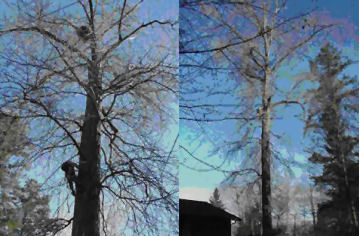
landowner's photo - December 28, 2001 - installation of camera
Based on past experience, look for eggs in mid-March, chicks in late April, and fledging in mid to late July.
Washington
Lake Washington
This cam is now streaming, with night vision! And it was repositioned in 2009 so there is a better look into the nest bowl.
The Washington Department of Fish and Wildlife posted the following in 2008 about this cam: “This year we have retired the Puget Sound EagleCam and replaced it with the Lake Washington EagleCam. Located in a 100 foot tall Douglas fir tree, the bald eagle pair have been actively building their nest and should be able to be observed increasingly as the mating season and pair-bonding is upon us. This bald eagle cam was installed with a landowner’s invitation and cooperation and with the hope to share the unique views and interactions of a dramatically situated bald eagle nest.” Lake Washington is in the northwest corner of Washington state, not really all that far from Seattle. This cam was new in 2008, and there were two chicks that year, one of which fledged successfully and the other which died of unknown causes when it was 8-1/2 weeks old (the cam was refresh-only the first year, making it harder to see what was happening in the nest). They successfully raised and fledged two chicks in 2009 and 2010. They successfully raised two chicks in 2011, but one was found dead at the foot of the tree when it was 12 weeks old, likely as the result of a mishap during or shortly after fledging; the other fledged successfully. The DFW website suggests there may be a cam upgrade for 2012.
There was a nice new cam for 2012 - but sadly no chicks; the WDFW website suggested that one of the previous pair may have died too close to nesting for a new mate to become established in time for eggs to be laid this year. The pair is visiting regularly so we hope they will nest in 2013. The eagles visited and worked on the nest from time to time in 2013, but did not lay eggs there; not sure if they didn't nest, or if they had a nest elsewhere.
In 2014, everything was going well until the first week of July - the pair returned, laid two eggs, both of which hatched, and the chicks were branching when the nest began to collapse; the good news is that the chicks were already branching, and they seemed to adapt to spending more time on the branches, and eating on the branches, as the nest vanished. It was mostly gone by July 16, when the chicks were 11-1/2 weeks old, and we only saw them occasionally for the next couple of days. There is no local observer posting anywhere as far as I know, so we are hoping for the best.
The eagles didn't return in 2015 - maybe next year.
No additional news discovered since then.
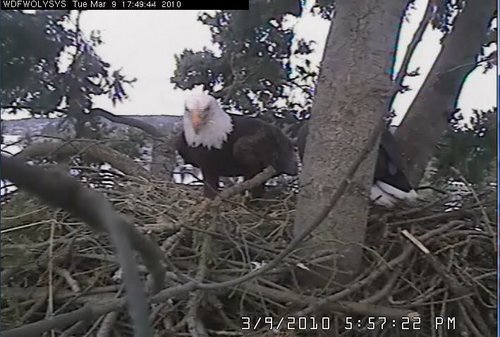
soph9's s'cap - March 9, 2010
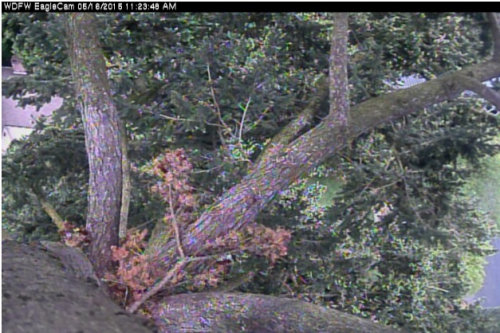
MaryF's s'cap - May 15, 2015
Based on previous experience, look for eggs in mid-March, chicks in late April, and fledging in mid July.
Washington
Puget Sound
no cam
This cam was only online one season, in 2007. The pair laid two eggs, one of which hatched. One of the more interesting things we observed is that the second egg was still in the nest seven weeks after the other egg hatched, and the eaglet appeared to be brooding it from time to time.

Sherri's s'cap - May 14, 2007
(eaglet is about 2-1/2 weeks old here)
West Virginia
NCTC
Shepherdstown
adults Liberty (M) and Belle (F) through spring 2011
adults Shep/Smitty (M) and Belle (F) summer 2011 -
February 2018
adults Shep/Smitty (M) and Bella (F) 2019 -
Liberty and Belle have been in this location near the Potomac River since late 2002, built their nest mostly in late 2003 and early 2004, and Belle laid her first egg February 14, 2004. The pair raised two chicks in 2004, one in 2005 and three in 2006; they had three eggs in 2007 but none survived the spring storms; they raised three chicks in 2008; they laid three eggs in 2009, but only one hatched - and that chick fledged successfully. In 2010 there was a major snowstorm with over 20" of snow after Belle laid her first two eggs; she kept them covered through the storm, but the snow was piled so high around the nest cup that the eggs were buried shortly after the storm ended. They cleared a new area of the nest and Belle laid a third egg - and there was another foot of snow shortly thereafter; that egg was left uncovered, apparently sitting on snow, a number of times over the next couple of days. It seemed as if Liberty was having trouble getting down to the nest cup (which still had substantial piles of snow around it), so he sometimes stood guard rather than incubating. Immediately after the second storm, they started bringing in more sticks and padding for the nest area - and four days after the third egg, Belle laid a fourth egg. The third egg disappeared after about two weeks - and the fourth egg hatched and the chick fledged successfully. In 2011 the pair laid two eggs; the first one hatched, but the male Liberty did not arrive to provide food or support, and a new younger male kept trying to enter the nest; Belle chased him off - but wasn't able to leave the nest to get food, so the chick died on its fourth day. Belle was observed offering her beak to the chick, and its possible some liquid was transferred, but no food was brought into the nest until shortly after the chick died. The other egg didn't hatch. The body of an adult eagle was found in the vicinity later in the spring; Liberty wasn't banded so its identity couldn't be confirmed, but many people thought it was probably Liberty. After chasing the new male away for a while, Belle began to tolerate his presence, and they appeared to be a pair by the end of the year. Here's hoping 2012 will be a happier year.
Belle and her new mate, known as Shep or Smitty on various forums, laid two eggs, both of which hatched and fledged successfully. It was interesting - and educational - to watch Belle teach her young partner what was expected of him. Once she had laid the eggs, he did a good job of delivering food - but it took a couple of days before he realized that he was supposed to incubate the eggs while she ate. Once he figured that out, he did much of the incubating during the day, allowing Belle time away from the nest. Once the chicks hatched, he upped the food delivery, but it was 5 days before he realized he should be feeding the chicks when he was on nest duty, and in fact it looked as if it took one of the chicks reaching up to grab a bite away from him to trigger the "ah-ha" moment. He is developing into a great parent - and we're learning what's involved in making that happen. It will be interesting to see what happens in 2013. Belle and Shep/Smitty laid two eggs in 2013, and both chicks fledged successfully - and he was a great Dad.
The pair laid three eggs in 2014, and all three hatched, but the middle chick sadly died shortly after hatching; there were some cam issues, but we're pretty sure the other two fledged successfully. Sadly there was also a loss in 2015; there were again three eggs, and all hatched, but the youngest chick was lost when the male brought in a huge fish as the tiny one was beginning to move out of the nest bowl, and plopped the fish on the little one (fly free, Lit'l Bit); the other chicks fledged successfully.
The pair laid two eggs in 2016, both hatched, and both chicks fledged successfully. They laid 2 eggs again in 2017; the first one appeared to be hatching normally but the chick wasn't fed, and wasn't seen the next day; the second chick seemed fine and was being fed and brooded, but died three days later; there was no obvious reason - maybe infection, maybe the chick got chilled in spite of being brooded by experienced parents - but whatever the reason, it wasn't meant to be. There intruders trying to take over the territory in 2018, which perhaps resulted in the first egg being laid later than usual; unfortunately there was a fight between Belle and a female intruder shortly after the egg was laid, and we're not sure what happened to Belle; we do know there were a number of eagles around, and none of them laid any eggs.
2019 was the first year for new female Bella, and may be her first time nesting; her name honors long time resident female Belle. The pair laid two eggs; both hatched, but sadly one of the chicks (an observer guessed the older, based on size) died overnight when a little over a week old and was removed from the nest bowl the next morning; both had seemed healthy and active the day before, venturing out of the nest cup to explore the nest and tucked back in at dark, so we'll never know what happened; the remaining chick and adults all seem fine. The eaglets were named by local school children after the first eaglet died and they chose to honor his/her memory by naming the tiny one Angel; younger eaglet Hope fledged accidentally while trying to fly to a perch above the nest at night; she returned to the nest two days later and was seen coming and going for another month.
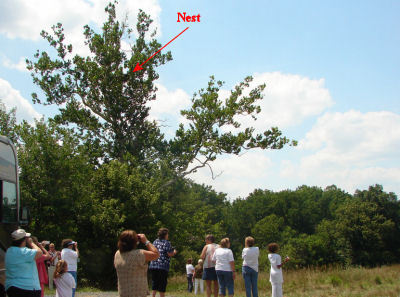
July 14, 2007 - visit to the site
© 2007 Paula Compton, used with permission, all rights reserved
Based on past experience, look for eggs in the first half of February, chicks in mid-March, and fledging in early June.
Wisconsin
Eagles4Kids
adults Larry (M) and Lucy (F) (pre-2014)
adults Blair (F) and Taylor (M) (challenged by Mister in 2015)
Taylor replaced by Thunder in 2016
Blair (F) and Thunder (M)
The nest is in Blair, Wisconsin, which is in the western part of the state, not too far from the border with Minnesota and Iowa. The interesting thing about this cam and website is that it is a project of the third and fourth grade classes at the Blair-Taylor Elementary School, in conjunction with the National Eagle Center. The cam came online in 2011, and the website reported that the eagles had fledged two eaglets in each of the previous 5 years. Unfortunately the eagles, known as Lucy and Larry, did not nest in 2011, and there was some suspicion that the original female may have disappeared and been replaced. The pair laid two eggs in 2012 - and the male had to teach the female how to feed newly hatched chicks, adding to the belief that she was a first-time mom; she learned well, and both chicks fledged successfully. As of December 2012, the pair is facing a new challenge - the toes of Lucy's right foot have been badly injured, perhaps by being caught in a trap, and it looks as if she will lose them. Her left foot also appeared swollen, but that may be because she was needing to use it more to compensate because she can't stand on her right foot (though it appears that she can put weight on it - it's the balance that's lacking). I think she's looking better, as she's adapting to what she can and can't do - but she does spend more time sleeping in the nest than is normal for an adult. We're keeping our fingers crossed that it will work out somehow. 2013 was better than we'd feared - Lucy did lose the toes on her right foot, but her left foot stabilized and has gotten stronger; amazingly they laid one egg, and it's perhaps not a bad thing that it didn't hatch, and apparently collapsed about a week after the anticipated hatch date. As of November 2013, Lucy and Larry have returned and are working on their nest.
2014 was a year of transition; another pair was seen in there territory March 6, and Lucy has not been seen since then; Larry remained the resident male and at least three females were seen seen vying for his attention, and one seemed to be spending time perched with Larry before they left the area on May 1st, but no eggs were laid.
2015 brought a new pair to the area; when the eagles returned in September 2014, there was a female who was likely the one who had been with Larry in the late spring, but the male who was seen at the nest was young, with some dark feathers on the head and tail. It took time, but they developed a bond, and the students from the school sponsoring the cam named them Blair (F) and Taylor (M) - and we began looking forward to eggs. However, in mid-February another male appeared, an older male who looked a lot like Larry, though that was never confirmed; Taylor was last seen on February 13th, and the new male, who was called Mister by the Chat moderators, began spending time with Blair, and by the 17th, they were working on the nest together. And on the 18th, Blair laid an egg! With a second one three days later. It's not clear if she had mated with either male in the right time frame for the eggs to be fertile, and Mister showed no interest in the eggs, though he tucked his talons in while on the nest; he brought food for Blair occasionally, but she did all the incubating. Then, on March 3, Taylor returned! He didn't have any obvious injuries, but it seems likely he needed time to heal after his first encounter with Mister, and came back strong, as Mister was not seen again. Taylor initially showed no interest in the eggs beyond watching over them from a perch while Blair was off getting food, but he tentatively began incubating near the end of the hatch window - and continued incubating much longer than Blair did - the pair incubated the eggs for 90 or more days. As of January 2016, Blair and Taylor are back and working on the nest - and we're hoping this will be a good year for them!
2016 was another hard year. Blair and Taylor are back - but Taylor was attacked by another male on Feb 18 and left the area, while the new male spent time near/at the nest; Taylor returned on Feb 25 and won the next fight, staying at the nest, but showing injuries to his feet which may have made successful mating difficult. The right foot seemed most sensitive, and it appeared better after a week or so, and perhaps sensing that it was past time for eggs, they began mating more often, though he was still limping a bit. An intruder was seen in the area after the first egg was laid, and perhaps as a result, Taylor didn't do as much incubating from March 12-15; happily he did some incubation starting on the 16th, but not what one would expect from an experienced male and/or a male who didn't have a challenger in the neighborhood. As of March 26, their rhythm was improving - but unfortunately the new male ended up taking over the nest and territory, and destroyed the eggs on April 3. Maybe next year.
Blair and new male Thunder were working on the nest early in 2017, but then a raccoon spent the night on the nest in February, and apparently disrupted them as the eagles stopped coming to the nest; they had been very busy making preparations for eggs before that, but after that mostly were at the nest tree to perch, and no eggs were laid. To add to the problem, a March 20 Facebook post by Eagles4Kids reported that there were "Too many eagles brought on by someone feeding nearby. That is the only factor that is different here than the other nearby nests. And they are not too far away. It is clear that is the reason. The food is gone, but the damage was already done." And then, in June, the nest tree was blown down; the folks at Eagles4Kids ended the season with the following update: "Due to the storm taking out the nest tree, the cameras will be off indefinitely. There is no plan at this time to resume in a different tree or to build a nest box. There is no suitable tree nearby for that. The eagles will have to make some plans for the future sooner than they might have anticipated. Thank you to all the E4K viewers over the seven seasons!!!"

October 7, 2011, cam installation - courtesy of Eagles4Kids
Based on past experience, look for eggs in early March, chicks in early to mid-April, and fledging in late June.
Wisconsin
Wolf River
Located on the banks of the Wolf River in Wisconsin, these bald eagles have built a nest in a large white pine tree. The adults, known as George and Martha, laid two eggs in 2012 (their first year on cam); both hatched, and the chicks fledged successfully. 2013 was interesting - a pair of great horned owls arrived at the nest in early February and laid 3 eggs; one hatched, and left the nest when he/she was 45 days old - too early to fledge, but owlets do move onto branches at a younger age than eaglets, and are fed there - so we're hoping all is well; happily the eagles did not show up to reclaim the nest in the middle of all this. It will be interesting to see what happens in 2014.
The eagles worked on the nest and apparently spent some time defending their territory, but no one nested here in 2014. At the end of August, an adult
who resembled Martha was found near the nest with a broken wing; the break is near the "wrist" so there wasn't much the rehab could do except keep her safe and see if it healed on its own - and it did! She was released October 6.
The eagles were working on the nest in December 2014, but so far I haven't been able to find much information beyond the fact that the eagles weren't there in April 2015.
Don't know if there will be a cam for 2016 or not.
We didn't find a lot of information for 2016, but apparently the eagles (or a pair of eagles - not sure if it's the same pair as before) did nest this year. On April 10 it was reported there were two chicks and an egg; I saw a post that there might be a pip in the third egg, but didn't find anything suggesting there was ever a third chick; one of the chicks may have gotten stuck and was untangled April 25; there's a May 20 report of banding 2 eaglets - I think this pair; June 21, there was a picture of one of them (with a band) helicoptering over the nest; and both were flying well July 15.
We didn't find any information for 2017 or 2018.
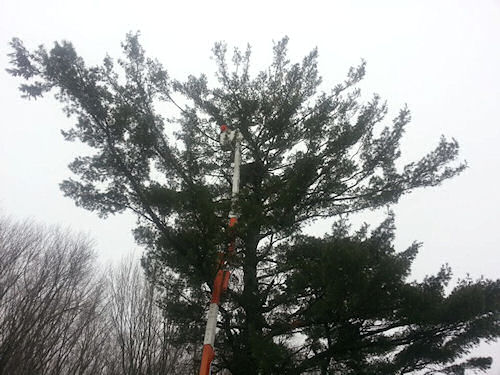
December 9, 2012 - camera replacement - courtesy of Wolf River Eagles
Based on past experience, look for eggs in mid to late March, chicks in late April, and fledging in mid to late July.
This is an artificial nest sponsored by Yukon Electrical Company, and replaces one that was lost in a storm The nest is located in downtown Whitehorse, but does have trees and a river nearby. 2013 is the first year watching this nest, and the eagles laid three eggs, all of which hatched - and all three eaglets fledged successfully. The pair moved to a new nest for 2014, so there was no cam; local observers reported that there were three chicks and all fledged successfully. A cam was put on the new nest for 2015 but the utility sponsoring the cam felt the quality was not adequate for streaming; they and observers reported there were again three eggs and three chicks, and all fledged successfully. Hoping they'll get the cam working better for 2016.
No cam, but they fledged three chicks in 2016, according to local observers.
We didn't find any information for 2017 or 2018.
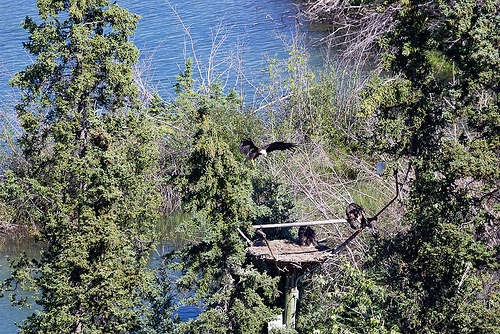 August 10, 2013 - "Food Drop"
August 10, 2013 - "Food Drop"
© 2013 arbitrage, used with permission, all rights reserved
Based on past experience, look for eggs in mid April, chicks in mid May, and fledging in early to mid August.
entries above this line have been updated
Location
Name
no cam / link info
adults if named
info on nest
(this post is made to be copied when I add a nest to the list)
NOTES
All images are the property of the cam from which they were taken and/or the person/organization credited.
Thank you for letting me use the images for this compilation.